By Sam Robinson |
at August 30, 2016 8:30 am
The Texans’ blueprint this offseason obvious to everyone as they devoted a full-force effort on multiple fronts to fix their offense. After a defensive-powered season ended with a 30-0 shutout in the wild-card round, Houston will deploy a starkly different starting offense.
For most of this century, teams with elite quarterbacks or those equipped with dominant defenses advanced to Super Bowls. There aren’t many exceptions in the modern game. The 2012 Ravens are one, but they were riding a hot streak from Joe Flacco who was playing some of his best football. The 2016 Texans are banking on another fifth-year passer, but Flacco and Brock Osweiler‘s careers aren’t exactly comparable. Houston bet big on the longtime backup who was at times effective in his audition last season.
Although they employ one of the NFL’s premier players in J.J. Watt, the Texans’ chances will hinge largely on the 6’7″ Osweiler building on his brief success. Last year’s No. 3-ranked defense lifted the team about as far as it could. This offseason, management made a point to provide as much help as possible.
Notable signings:
- Brock Osweiler, QB: Four years, $72MM. $37MM guaranteed.
- Lamar Miller, RB: Four years, $26MM. $14MM guaranteed.
- Jeff Allen, OL: Four years, $28MM. $12MM guaranteed.
- Chris Clark, T: Two years, $6MM. $3.25MM guaranteed.
- Tony Bergstrom, C: Two years, $5.75MM. $1.5MM guaranteed.
- Shane Lechler, P: One year, $1.8MM. $500K guaranteed.
- Brandon Weeden, QB: Two years, $4MM. $450K guaranteed.
- Eddie Pleasant, S: Two years, $2.15MM. $311K guaranteed.
- Quintin Demps, S: One year, $1.5MM. $260K guaranteed.
- Jonathan Grimes, RB: One year, $900K. $200K guaranteed.
- Antonio Allen, S: One year, $800K. $80K guaranteed.
- Nick Novak, K: One year, minimum salary benefit. $80K guaranteed.
- A.J. Bouye, CB: One year, $1.671MM. Signed original-round RFA tender.
- John Simon, LB: One year, $1.671MM. Signed original-round RFA tender.
Midway through 2014, it looked like Peyton Manning was going to play out the five-year contract he signed with the Broncos in 2012, thus giving his lanky backup no realistic opportunity impress potential buyers as a free agent. But the future Hall of Fame quarterback experienced a quick decline that forced the Broncos to retool their offense that season, and his freefall continued in 2015 prior to Manning injuring his foot. Osweiler stepped in and kept his previous defensive-fueled team afloat, altering his career in the process.
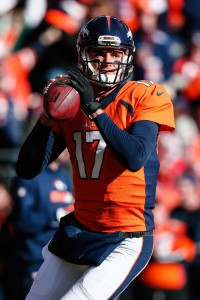 The seven-game work sample Osweiler offered included mixed reviews. He showcased some ability despite no previous experience in an important game situation, leading the Broncos to a 4-2 record in games he played throughout. The former second-round pick drove the team to pivotal victories over the Patriots and Bengals to help the Broncos secure home-field advantage. He finished with 10 touchdown passes, six interceptions and 245.9 passing yards per game. Denver’s offense also sputtered for several entire halves under Osweiler’s guidance, leading to two December losses and increasing the defense’s burden. What happened during the final stretch of offensive futility under the 25-year-old Osweiler may have changed the long-term outlook for two franchises.
The seven-game work sample Osweiler offered included mixed reviews. He showcased some ability despite no previous experience in an important game situation, leading the Broncos to a 4-2 record in games he played throughout. The former second-round pick drove the team to pivotal victories over the Patriots and Bengals to help the Broncos secure home-field advantage. He finished with 10 touchdown passes, six interceptions and 245.9 passing yards per game. Denver’s offense also sputtered for several entire halves under Osweiler’s guidance, leading to two December losses and increasing the defense’s burden. What happened during the final stretch of offensive futility under the 25-year-old Osweiler may have changed the long-term outlook for two franchises.
Benched for Manning early in the third quarter of the Broncos’ Week 17 game after a spate of turnovers that mostly were hard to pin on him, Osweiler either was merely miffed at the idea of being replaced after guiding Denver back to the precipice of home-field advantage. Or he saw Gary Kubiak‘s decision as evidence he didn’t want to return to the team. His agreement with Houston came after Denver offered him $16MM per year to continue in a system in which he showed promise. Osweiler has attributed the surprising exit to wanting to start something with the Texans, who are placing immense faith in the Arizona State product whose career began with a longer backup stint than Aaron Rodgers‘.
The Texans are committed to Osweiler for the next two seasons at least. This experiment failing can reasonably result in a divorce in 2018, when just $6MM in dead money would be attached to an Osweiler release. But the Texans spent plenty in offseason capital to give their quarterback weaponry after deploying an offense without much in the way of options beyond DeAndre Hopkins last season.
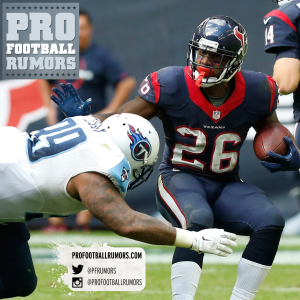 Houston moved quickly to replace Arian Foster, signing Miller on Day 1 of free agency. Unlike the new franchise quarterback, the Texans’ cornerstone ball-carrier’s ability can be judged based on full-season bodies of work. Miller posted back-to-back slates of at least 1,200 yards from scrimmage. Among backs who received at least 400 carries in 2014-15, Miller’s 4.8 yards per tote rank as the league’s top mark in a sub-category basically exclusive to starting backs. As a receiver, Miller caught 47 passes for nearly 400 yards last season, so he’s no slouch as an outlet option, either.
Houston moved quickly to replace Arian Foster, signing Miller on Day 1 of free agency. Unlike the new franchise quarterback, the Texans’ cornerstone ball-carrier’s ability can be judged based on full-season bodies of work. Miller posted back-to-back slates of at least 1,200 yards from scrimmage. Among backs who received at least 400 carries in 2014-15, Miller’s 4.8 yards per tote rank as the league’s top mark in a sub-category basically exclusive to starting backs. As a receiver, Miller caught 47 passes for nearly 400 yards last season, so he’s no slouch as an outlet option, either.
Miller played 16 games in each of the Dolphins’ past three regular seasons, but 2014’s 210 carries represent the former fourth-round pick’s career high. He stands to have plenty of opportunities in Houston, which looks to have signed a 25-year-old runner with upside thanks to his age and a lack of usage typical of a three-year starter. By this measure, Miller’s $6.5MM AAV (sixth among running backs) accord looks to be a good value bet. He’ll be a key part in helping Osweiler assimilate in south Texas.
The other key piece on the free agency side of the offense-enhancement blueprint, Allen possesses the starting experience closer to Miller but a track record more in line with Osweiler’s. Excepting a 2014 season during which he missed the Chiefs’ final 15 games, Allen was a primary starter in Kansas City after arriving as Scott Pioli‘s final second-round selection in 2012. He started 13 games as a rookie and 14 a year later, but in neither season was he considered an above-average guard. Conveniently for his value and the sake of the Chiefs’ reeling line last year, Allen strung together his best season in 2015.
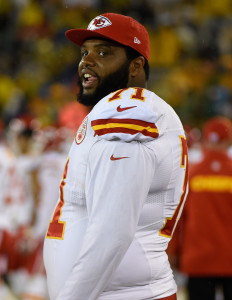 Previously relocated to right tackle in 2014 prior to his season-ending elbow malady, Allen began his ’15 campaign on the right edge before Ben Grubbs‘ career-ending neck injury moved him back inside. At left guard, Allen became Kansas City’s best lineman, helping the Chiefs adjust to life without Jamaal Charles. But the 6-foot-4 blocker saw a preseason knee injury limit him to 12 games (eight starts) last season. Nonetheless, the Texans needed a guard with Brandon Brooks in the process of signing with the Eagles, and they made Allen the league’s sixth-highest-paid guard on a per-year basis.
Previously relocated to right tackle in 2014 prior to his season-ending elbow malady, Allen began his ’15 campaign on the right edge before Ben Grubbs‘ career-ending neck injury moved him back inside. At left guard, Allen became Kansas City’s best lineman, helping the Chiefs adjust to life without Jamaal Charles. But the 6-foot-4 blocker saw a preseason knee injury limit him to 12 games (eight starts) last season. Nonetheless, the Texans needed a guard with Brandon Brooks in the process of signing with the Eagles, and they made Allen the league’s sixth-highest-paid guard on a per-year basis.
Allen’s $7MM average — which ended up being $1MM less per season than Brooks received from Philadelphia — makes him the Texans’ third $5MM-per-year blocker. He’ll join tackles Duane Brown and Derek Newton as veteran presences expected to open lanes for Miller, only Allen will now have to live up to a deal signed on the strength of barely a half-season’s worth of upper-echelon work. Like Osweiler, Allen showcased potential at the right time.
Houston spent less extravagantly to fortify its swing spots but kept Clark and brought in Bergstrom on notable veteran deals. A 2015 trade acquisition from the Broncos, Clark looks like the Texans’ swing tackle, with former Raider Bergstrom settling in as the interior roving backup. Clark could be called to action in a key capacity, however, as Brown remains on the Active/PUP list.
Clark operated in this capacity for the 2013 Broncos, starting the team’s final 17 games after left-edge bastion Ryan Clady went down that September. He performed adequately that year but couldn’t hold the right tackle job in 2014, helping green-light a trade to Houston. Last season, Clark performed better as a run-blocker than in pass protection during his four games as a starter.
Bergstrom suffered a significant foot injury in 2013 and did not play in ’13 or ’14. A former Raiders third-rounder, he returned as a sub for Rodney Hudson in three starts last season. He could also serve as a possible starting center given the team’s recent trouble at that spot. Nick Martin‘s season-ending ankle injury appears to have opened the door for 2015 UDFA Greg Mancz. But the second-year player faltering could move Bergstrom into a position to play with the first unit.
Regardless of whether or not Bergstrom or Clark ascend into the starting lineup, Houston’s now paying five linemen at least $2.5MM per year. Martin’s injury would have set several teams back worse.
Read more
Notable losses:
- Brandon Brooks, G
- Jared Crick, DE
- B.J. Daniels, QB: Waived
- Arian Foster, RB: Released
- Garrett Graham, TE: Released
- Ben Jones, C
- Brian Hoyer, QB: Released
- Rahim Moore, S: Released
- Darryl Morris, CB
- Chris Polk, RB
- Justin Tuggle, LB
- Nate Washington, WR
- T.J. Yates, QB
The makeover of the Texans’ offense meant parting with the player most associated with it during the decade. While Duane Brown has enjoyed a longer stint in Houston and Andre Johnson was still a top-flight target for a few years during the 2010s, Foster buoyed this run-centric attack for years. His Texans tenure, one that concluded because of injuries, broke down into two parts: the three-year stretch from 2010-12 when he profiled as one of the league’s best, and the past three years defined mostly by injuries.
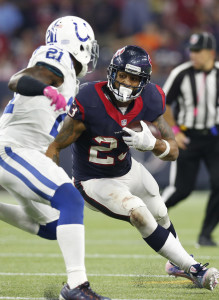 The outspoken former UDFA won the 2010 rushing title and earned Pro Bowl berths during each season he suited up for at least 13 games, with 2014 being the last such instance. Foster totaled at least 1,550 yards from scrimmage in all four of those campaigns; his 2,220 in ’10 ranked as a top-20 all-time mark. However, the 30-year-old’s Achilles tear last season limited him to four games and put his viability as a player going forward in doubt until training camp. The Texans will incur a $2.3MM dead-money charge in 2016 after cutting their franchise rushing leader.
The outspoken former UDFA won the 2010 rushing title and earned Pro Bowl berths during each season he suited up for at least 13 games, with 2014 being the last such instance. Foster totaled at least 1,550 yards from scrimmage in all four of those campaigns; his 2,220 in ’10 ranked as a top-20 all-time mark. However, the 30-year-old’s Achilles tear last season limited him to four games and put his viability as a player going forward in doubt until training camp. The Texans will incur a $2.3MM dead-money charge in 2016 after cutting their franchise rushing leader.
For the third straight offseason, the Texans parted with the previous year’s starting quarterback. Though Hoyer didn’t enjoy the kind of highs either Matt Schaub or Ryan Fitzpatrick have in their respective careers, he was the only one in this group to be jettisoned a year after leading the Texans to the playoffs. Houston traded Schaub to the Raiders after benching him midway through a 2-14 season in 2013 and moved Fitzpatrick in a trade to the Jets after he went 6-6 for the ’14 Texans. Enduring a strange yo-yo pattern with the since-cut Ryan Mallett early last year, Hoyer guided a depleted Texans team to an AFC South title, going 5-4 as a starter.
Hoyer’s 19-to-7 touchdown pass-to-interception ratio helped Houston into the playoffs, albeit in a down year for the division, but the 30-year-old journeyman became expendable after Osweiler’s arrival. His ignominious finish to the season — the five-turnover catastrophe that aided the Chiefs to their first playoff win in 22 years — helped streamline the Texans’ search for their first long-term option under center since Schaub.
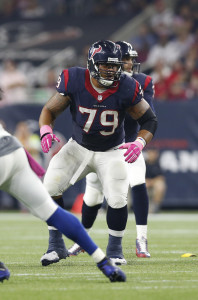 Brooks and Jones departed after four years with the team. Each starting a similar amount of games during their years with Houston, the interior-line tandem received disparate commitments from their second NFL employers after negotiations with the Texans didn’t lead to re-ups. Brooks is now a top-five-compensated guard, while Jones signed for four years and $17.5MM with the Titans.
Brooks and Jones departed after four years with the team. Each starting a similar amount of games during their years with Houston, the interior-line tandem received disparate commitments from their second NFL employers after negotiations with the Texans didn’t lead to re-ups. Brooks is now a top-five-compensated guard, while Jones signed for four years and $17.5MM with the Titans.
One of the game’s biggest guards, Brooks will join an Eagles team that also was connected to Allen due presumably to Doug Pederson‘s presence. Brooks did not play up to his capabilities last season, ranking as a substandard run-blocker in the opinion of Pro Football Focus. But his pass-protecting savvy remained, and with Brooks exhibiting road-grading ability in recent years, it’s not surprising he received a big commitment in free agency. Jones graded as PFF’s No. 18 center last season, with the analytics site also preferring the ex-fourth-rounder’s pass blocking over his ability to clear lanes for Foster or his understudies.
Neither Graham nor Moore proved to be good fits with Bill O’Brien, with their respective releases leaving three years total on the table. Although Houston’s cap sheet looks pretty clean when it comes to dead money, Moore and Graham combine for $2.75MM of the $5.6MM in payments due to non-roster players.
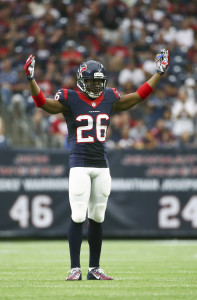 The Texans initially signed Moore to a mid-level accord at three years and $12MM but benched the free safety after six games last season. He’d rated as plus cover man in 2014 with the Broncos, leading to the Texans deal, but did not excel after leaving Colorado. The ill-fated pact ceasing after one season led Houston to turn to the lesser-known Andre Hal at free safety.
The Texans initially signed Moore to a mid-level accord at three years and $12MM but benched the free safety after six games last season. He’d rated as plus cover man in 2014 with the Broncos, leading to the Texans deal, but did not excel after leaving Colorado. The ill-fated pact ceasing after one season led Houston to turn to the lesser-known Andre Hal at free safety.
Having signed a three-year deal just after O’Brien took over in 2014, Graham did not prove to fit this offense. After catching 49 passes for 545 yards and five touchdowns in relief of Owen Daniels in 2013, Graham played sparingly the past two years and snared just 22 passes for 227 since re-signing. Houston’s offensive transformation did not include bringing in help at tight end, so C.J. Fiedorowicz and Ryan Griffin will continue to share duties here.
Crick joined the parade of exiting 2012 Texans draftees after underwhelming opposite J.J. Watt. The run-stopping defensive end will attempt to recapture the form the Gary Kubiak– and Wade Phillips-led coaching staff initially saw in him.
Trades:
- Acquired a 2016 first-round pick (No. 21) from the Redskins in exchange for a 2016 first-round pick (No. 22) and a 2017 sixth-round pick.
- Acquired a 2016 second-round pick (No. 50) from the Falcons in exchange for a 2016 second-round pick (No. 52) and a 2016 sixth-round pick (No. 195).
Extensions and Restructures:
- Cecil Shorts, WR: Accepted pay cut, creating $1.05MM in cap space by reducing 2016 base salary from $2.75MM to $1.2MM. Added $500K roster bonus.
Draft picks:
The Texans entered the draft with a similar issue that’s plagued them for most of their existence: the lack of a No. 2 wide receiver. Andre Johnson‘s prime mostly went by without this luxury, although Kevin Walter did put together two solid years in the late 2000s, until DeAndre Hopkins arrived. Only the two best wideouts in team history didn’t see their timelines intersect for long, with Johnson slowing down considerably by 2014 as Hopkins was taking off. In 2015, Hopkins shouldered most of the receiving load, and Nate Washington‘s workmanlike effort notwithstanding, Rick Smith sought a long-term upgrade with which to equip his new quarterback.
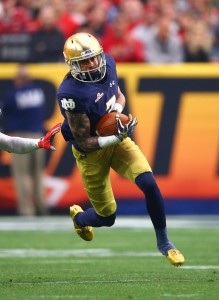 As examined by former NFL scout Dave-Te Thomas in PFR’s Impact Rookies series, the Texans acquired another receiver who excels in jump-ball situations. They already employ maybe the league’s premier playmaker by that measurement, and Fuller’s 4.32-second 40-yard dash speed should help distract defenses from rolling coverage to Hopkins constantly. Fuller delivered dominant seasons in South Bend, Ind., hauling in 29 touchdown receptions in 2014-15 while amassing nearly 2,500 air yards in those seasons.
As examined by former NFL scout Dave-Te Thomas in PFR’s Impact Rookies series, the Texans acquired another receiver who excels in jump-ball situations. They already employ maybe the league’s premier playmaker by that measurement, and Fuller’s 4.32-second 40-yard dash speed should help distract defenses from rolling coverage to Hopkins constantly. Fuller delivered dominant seasons in South Bend, Ind., hauling in 29 touchdown receptions in 2014-15 while amassing nearly 2,500 air yards in those seasons.
He’ll be given every chance to ascend into a starting role opposite Hopkins, with Shorts and Jaelen Strong being the team’s auxiliary incumbents. Fuller averaged 20.3 yards per reception with the Fighting Irish last season, duplicating his ’14 sophomore success and showing the kind of consistency that’s been largely lacking from Texans complementary cogs.
Fuller began the second full-speed-ahead approach to offensive improvement; three more offensive talents followed in an attempt to help a unit that finished 19th in total offense and 21st in scoring last season.
While Martin’s injury hurts since he was going to be the Day 1 center, the Texans landed the intriguing Miller soon after that night. Despite one year of experience as a receiver with the Buckeyes, Miller is expected to be deployed quickly in Houston as the team’s No. 1 slot receiver. At 6-2 and 215 pounds, Miller brings a different frame to the slot than most teams are going to feature. But his elusiveness should be on display, given the explosive plays he authored as a two-time Big Ten offensive player of the year.
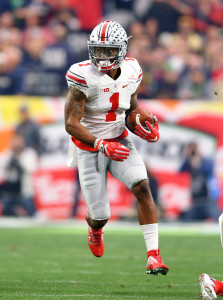 However, his accolades came at quarterback. Miller’s pure receiving numbers — 25 receptions for 340 yards last season — leave some questions as to how he’ll translate. Because it’s far from automatic. That said, Miller got the jump on some other recent slot threats that worked as QBs exclusively in college, doing so by switching a year early to make room for Cardale Jones and J.T. Barrett. Julian Edelman and Antwaan Randle-El both worked as running quarterbacks until called upon to learn receiver in the pros. The switch has also created talented gadget players like Brad Smith or Josh Cribbs.
However, his accolades came at quarterback. Miller’s pure receiving numbers — 25 receptions for 340 yards last season — leave some questions as to how he’ll translate. Because it’s far from automatic. That said, Miller got the jump on some other recent slot threats that worked as QBs exclusively in college, doing so by switching a year early to make room for Cardale Jones and J.T. Barrett. Julian Edelman and Antwaan Randle-El both worked as running quarterbacks until called upon to learn receiver in the pros. The switch has also created talented gadget players like Brad Smith or Josh Cribbs.
The Texans, though, did run some wildcat concepts last season, and although those plays were understandably a small section of the playbook, the team now has an ideal operator for this look. Miller opens up some possibilities. If nothing else, he adds depth to a receiving corps that’s now packed equipped with high picks opposite Hopkins.
When they finally went defense, they chose the lesser-regarded former Mountaineers safety. Dillon obviously didn’t tantalize scouts like Karl Joseph did, but he does boast some versatility. As Thomas notes, Joseph’s knee injury forced Dillon to take on a bigger role. He accrued some free and strong safety seasoning in 2015, and coupled with the weakside linebacker reps he also received during his career at West Virginia, makes for an interesting package for a team that doesn’t boast much in terms of safety investments.
Moore not panning out leaves the team bereft of established talent or high-ceiling prospects. Along with 2014 seventh-rounder Andre Hal — who’s slated to start at free safety after intercepting a team-high four passes last season — castoffs Antonio Allen, Kurtis Drummond and Eddie Pleasant populate the safety contingent in Houston. It’s by far the defense’s thinnest position group and, even including tight end, probably the spot where the Texans are most vulnerable. It’s arguable they should have paused a bit on the all-offense offseason to address this area, but the fact they didn’t illuminates a path for Dillon.
Other:
Smith’s tenure can be broken down in a few ways. The case for extending him hinged on the select playoff appearances the team has made now under two different coaching regimes, along with the caliber of talent his managerial tenure produced in the draft. Watt is already one of the greatest defensive players in NFL history. Few can match his impact on the league. Hopkins took the mantle from Andre Johnson as a true No. 1 wideout quickly. Although the Texans don’t have an AFC championship game berth in 14 years, their run of dominant pass-catchers is hard to match. Bringing in Brown and Whitney Mercilus in the first round helped add impact players on the edges as well, aiding a team that hasn’t featured quality quarterback play in years.
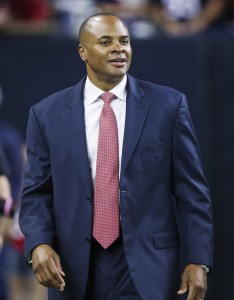 The lack of consistency in steering teams to the playoffs should count against Smith, given that it took the Texans until his sixth year — and the franchise’s 10th — to secure their first playoff berth. Among NFL expansion franchises that spawned since the merger, that is the longest drought, eclipsing the Seahawks’. It’s true the worst of those years came under Charlie Casserly in the early and mid-2000s, but Smith and Gary Kubiak tread water for a while. On the other hand, Houston was competing with one of the most consistent teams in NFL history, the Peyton Manning-era Colts, for several of those years. So, winning division titles was going to be difficult no matter who was making the personnel decisions.
The lack of consistency in steering teams to the playoffs should count against Smith, given that it took the Texans until his sixth year — and the franchise’s 10th — to secure their first playoff berth. Among NFL expansion franchises that spawned since the merger, that is the longest drought, eclipsing the Seahawks’. It’s true the worst of those years came under Charlie Casserly in the early and mid-2000s, but Smith and Gary Kubiak tread water for a while. On the other hand, Houston was competing with one of the most consistent teams in NFL history, the Peyton Manning-era Colts, for several of those years. So, winning division titles was going to be difficult no matter who was making the personnel decisions.
Smith’s tenure will largely be defined by what happens in the next few years after the signings the Texans made this offseason. It’s arguable his leash shouldn’t be as long as it is, but if the Brock Osweiler/Bill O’Brien era falters after the Kubiak/Matt Schaub stretch faded fast, Smith probably won’t be around to tab another quarterback.
The option for Hopkins became elementary. He’s an elite receiver. But the 24-year-old performer’s mini-holdout did signal some potential acrimony ahead. It’s not the Texans’ fault the new rookie wage scale has become so team-friendly. Hopkins only became extension-eligible this year, and other teams waited longer to extend wideouts of his ilk. The Broncos and Cowboys respectively re-signed Demaryius Thomas and Dez Bryant entering their sixth years. The Bengals and Falcons signed off on respective payments for A.J. Green and Julio Jones in advance of their fifth seasons.
Hopkins has proven to be in their class, and the $2.43MM he’s slated to earn in his fourth year represents a risk for the 2013 first-rounder. Players like T.Y. Hilton, Keenan Allen and Allen Hurns received eight-figure-per-year money and essentially benefited from not being first-rounders and thus residing as potential Year 5 UFAs instead of their teams holding value-suppressing fifth-year options. Hopkins has proven more than those pass-catchers, and having seen the Texans extend Watt before his fourth year, it’s a dicey situation in which the team could find itself. It was somewhat surprising Hopkins’ holdout ended so soon since the offense would not work well without him.
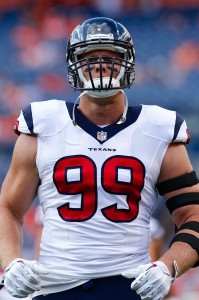 Watt’s injury proved to be the other key takeaway from this summer. The Texans may need to show caution since Watt is more important to the Texans’ defense than Hopkins is to the offense. Either’s absence throws the team off axis right now. The 27-year-old superstar and four-time first-team All-Pro has never missed a game, working in Houston’s favor, but summer back surgery does throw up a warning sign regardless of the player. Without Watt, Jadeveon Clowney would be called to action to finally determine how far he’s come since injuries hijacked his trajectory.
Watt’s injury proved to be the other key takeaway from this summer. The Texans may need to show caution since Watt is more important to the Texans’ defense than Hopkins is to the offense. Either’s absence throws the team off axis right now. The 27-year-old superstar and four-time first-team All-Pro has never missed a game, working in Houston’s favor, but summer back surgery does throw up a warning sign regardless of the player. Without Watt, Jadeveon Clowney would be called to action to finally determine how far he’s come since injuries hijacked his trajectory.
That duo still hasn’t flashed like most thought it would, although that’s been mostly due to bad luck. The Texans still boasting a top-five defense regardless of the former No. 1 overall pick’s slow start illustrates Watt’s impact.
A cornerstone left tackle for years, Brown was non-committal Sunday on his status for the Texans’ opener; Brown underwent surgery for a torn quadriceps tendon in January. This could lead to either Brown missing starts or landing on the Reserve/PUP list to start the season, putting Chris Clark in position to start Houston’s first six games. Brown’s played at least 14 games in seven of his eight seasons and would go a long way toward mobilizing the revamped offense.
He and Martin missing games together would make things difficult for Osweiler, who didn’t show strong pocket presence last season, absorbing 23 sacks in less than a half-season’s worth of work. It will be interesting to see how he handles opposing rushes in a new system. Martin’s malady thrusts Greg Mancz to the forefront. The Mid-American Conference product played just three games last year in a reserve capacity. This could well be a problem spot, but the insurance addition of Tony Bergstrom looks prescient now.
Top 10 cap hits for 2016:
- J.J. Watt, DE: $14,500,000
- Brock Osweiler, QB: $12,000,000
- Duane Brown, T: $9,500,000
- Brian Cushing, LB: $9,047,500
- Kareem Jackson, CB: $8,437,500
- Johnathan Joseph, CB: $7,000,000
- Jeff Allen, OL: $6,125,000
- Jadeveon Clowney, LB: $6,074,454
- Whitney Mercilus, LB: $5,800,000
- Derek Newton, T: $5,500,000
Given the investments Rick Smith and Co. made in the offense this year, the Texans will be one of the magnified teams in 2016. Even with Watt involved, they haven’t usually garnered this kind of attention. Their peak period came when Peyton Manning and Tom Brady were still ruling the AFC. Now in a more wide-open landscape, the Texans should generate buzz based largely on how Osweiler functions.
This is one of the bigger dice rolls in memory, and how a quarterback with seven starts to his name performs will determine the fate of the franchise. After all, Watt earned defensive player of the year honors three times in four years — and had a strong MVP case in 2014 — but the Texans lost seven games in each of the past two campaigns, showing why they spent on a 25-year-old quarterback with an uncertain ceiling.
And 9-7 might not be enough to win this division this season. Andrew Luck was not playing well before he went down, but now that he’s presumably healthy again, the Colts will be a factor, just as they were from 2012-14. The potential development of the Jaguars could loom as well despite that operation showing little thus far despite extensive offseason expenses. The reinforcements the Texans acquired will be needed even after last year’s less diverse offense was enough to secure a January home date.
Houston fans will learn a lot about their team’s place in the AFC hierarchy this season, because it’s pretty hard to overstate what kind of pressure Osweiler will encounter based on the contract he signed. The Texans haven’t devoted these kind of resources into locking in a quarterback since taking David Carr with their first-ever draft pick. This largely untouched defense has shown it can carry the team to a point, but this is a higher-variance team because of the bet it made on Osweiler. As they attempt to re-establish themselves as one of the AFC’s best after such a bold step, the Texans will be one of the league’s most interesting teams as a result.
Information from Over the Cap, Spotrac, and Roster Resource was used in the creation of this post. Photos courtesy of USA Today Sports Images.
By Connor J. Byrne |
at August 24, 2016 6:34 pm
Although the Buccaneers are in the midst of an eight-year playoff drought, they appear to be on the right track after taking significant steps forward in 2015. Not only did Tampa Bay enjoy a four-win improvement and better its point differential by 58 from 2014 to 2015, but it may have found a franchise quarterback in Jameis Winston. The No. 1 overall pick in last year’s draft, Winston acquitted himself well as a rookie and could soon help lead the Buccaneers back to consistent contention for the first time since the early 2000s. In a perfect world for the Bucs, their return to the postseason will come in January 2017. However, given the club’s relatively modest offseason, it’s likely too soon to expect it to push for a playoff spot in the NFC.
Notable signings:
- Doug Martin, RB: Five years, $35.75MM. $15MM guaranteed. $5.75MM available via escalators.
- J.R. Sweezy, G: Five years, $32.5MM. $14.5MM guaranteed.
- Robert Ayers, DL: Three years, $19.5MM. $7.5MM. $1.65MM available via incentives.
- Brent Grimes, CB: Two years, $14MM. $7MM guaranteed.
- Chris Conte, S: One year, $3MM. $2.5MM guaranteed.
- Daryl Smith, LB: One year, $2.5MM. $2MM guaranteed.
- Bryan Anger, P: One year, $1.75MM. $750K guaranteed.
- Josh Robinson, CB: One year, $2MM. $500K guaranteed.
- Keith Tandy, S: Two years, $1.85MM. $250K guaranteed.
- Bradley McDougald, CB: One year, $2.553MM. Signed second-round RFA tender.
- Russell Shepard, WR: One year, $1.671MM. Signed original-round RFA tender.
- A.J. Francis, DT: One year, $600K.
General manager Jason Licht said before free agency that the Buccaneers would be “selective and strategic” in spending money and wouldn’t dole out contracts with the potential to damage their cap over the long haul. Licht was true to his word, as even the most sizable deals he awarded to veterans will be easy to escape in short order if they don’t work out.
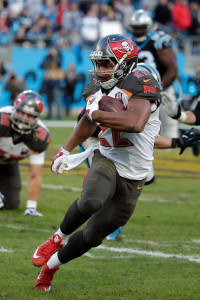
In terms of both contract (five years, $35.75MM with $15MM in guarantees) and star power, running back Doug Martin was Tampa Bay’s most notable offseason signing. Given that the Buccaneers decided in May 2015 to decline Martin’s $5.621MM fifth-year option for 2017, they took a financial hit this past winter in committing nearly three times that much in guarantees to their 2012 first-round pick. A year ago, though, Martin was coming off back-to-back miserable seasons that made his sensational rookie campaign look like a fluke. He revisited his first-year form last season, however, finishing second in the NFL in both carries (288) and rushing yards (1,409) en route to first-team All-Pro status.
Considering Martin’s inconsistent track record, betting on the 27-year-old going forward looks like a gamble. In the event he’s unable to live up to his new pact, the Bucs will be able to bail on his contract after the 2017 season, thus mitigating the risk. Should Martin keep serving as a quality option, Tampa Bay will continue to have one of the league’s most well-rounded backfield duos in him and Charles Sims. Led by that tandem, the Buccaneers finished last season first in yards-per-carry average (4.8), fifth in overall rushing (2,162) and 11th in DVOA – up from 31st in 2014.
Among the players who will be responsible for blocking for Martin and Sims is left guard J.R. Sweezy, whom the Buccaneers inked to a five-year, $32.55MM pact with $14.5MM guaranteed in free agency. With a combined $2.5MM in dead money through 2020 left after this year, the Buccaneers will be able to move on from Sweezy without much difficulty if they have buyer’s remorse.
Sweezy spent the first four years of his career in Seattle, where he started in all 46 of his appearances from 2013-15, though Pro Football Focus ranked him just 66th among 81 qualified guards in overall performance last season. Nevertheless, the Bucs are counting on Sweezy as the long-term replacement for the retired Logan Mankins, whom PFF placed 15th in 2015. The Sweezy era in Tampa Bay hasn’t gotten off to an ideal start, though, as the 27-year-old will miss at least the first five weeks of the season with a back injury. In the meantime, the Buccaneers are likely to go with former tackle Kevin Pamphile, a third-year man with four starts on his resume.
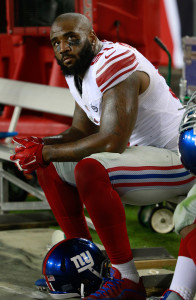
On the defensive side, the Buccaneers went into free agency looking to augment a pass rush that finished last season tied for 14th in sacks (38) and 22nd in hurries (91). To help with those issues, they added defensive end Robert Ayers, a former Bronco and Giant who amassed 21 sacks and four forced fumbles in 39 games over the previous three seasons. The soon-to-be 31-year-old Ayers missed four games in 2015, but his production was highly impressive – he picked up a career-high 9.5 sacks and added 18 hurries, placing him between the likes of Chandler Jones (16) and Olivier Vernon (20).
Ayers, who also finished last year as PFF’s eighth-best edge rusher (110 qualifiers), is now on the Buccaneers’ books through 2018. But that doesn’t necessarily have to be the case – in the event of an appreciable decline in output, the Bucs will be able to move on from Ayers either after this season or after next without taking on any dead money. While Tampa Bay would rather see Ayers play well and remain in place for the duration of his three-year, $19.5MM deal, the fact that his contract has no cap ramifications past this season makes it a worthy gamble for the organization.
Joining Ayers in the Buccaneers’ front seven is 13th-year man Daryl Smith, who’s slated to start at strongside linebacker after dividing his first 12 seasons between Jacksonville and Baltimore. Notably, Smith played the first four years of his career under new Buccaneers defensive coordinator Mike Smith, who was the Jaguars’ defensive chief during those seasons. Daryl Smith enjoyed some fine seasons with the Jags, and he was particularly durable as a member of the Ravens. In Baltimore, Smith started in 48 straight games from 2013-15 and racked up 120-plus tackles in each of his three seasons with the club, while also combining for nine sacks and four forced fumbles. PFF was unimpressed with Smith’s play last year, though, as the outlet ranked him 71st among 97 qualified linebackers. The Ravens then cut Smith in early March, but based on his ability to stay on the field and produce, the Bucs made out well in signing the 34-year-old for a fairly meager sum of $2.5MM.
“Not only is he a really good football player, but once you get to know Daryl and the type of guy he is, I think Daryl will be a really good sounding board,” new head coach Dirk Koetter told Scott Reynolds of Pewter Report. “His experience and the players that he’s played with in his career, the things that he’s accomplished in his career, will do nothing but help Lavonte [David] and Kwon [Alexander] advance as players.”
Thanks largely to a weak secondary, Tampa Bay allowed the fourth-most touchdown tosses (31) and the second-highest passer rating (101.2) in the league last season. With that in mind, the club addressed the area over the winter by signing outside help (Brent Grimes and Josh Robinson) and re-upping Chris Conte, Bradley McDougald and Keith Tandy to new deals.
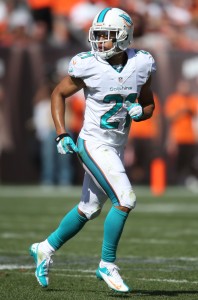
Grimes, a cornerback, is clearly the most accomplished member of the group, having started in 90 of 106 appearances with two teams – the Falcons and Dolphins – and totaling 26 interceptions since entering the league in 2007. Like Daryl Smith, Grimes also worked under Mike Smith previously. Grimes played in Atlanta from 2007-12, and Smith was the Falcons’ head coach in five of those six seasons. The rapport they established with the Falcons helped lead to a reunion in Tampa Bay.
“It’s a big deal for me, because I like the system,’’ Grimes told Roy Cummings of the Tampa Bay Times in March. “And one thing I know about Mike Smith is, he’s a great coach as far as everybody on the field knowing where they need to be and knowing what their assignment is, and he pays great attention to detail.”
After leaving Atlanta, Grimes was an impressive producer in Miami, where he started in all 47 appearances over the previous three seasons and picked off either four or five passes in each of those years (though he did yield a 103.2 passer rating against in 2015). Grimes is now in his age-33 season, so he’s unlikely to resemble a shutdown corner at this juncture. Still, as is the case with their other established veteran signings, the Bucs will have the option of waving goodbye to Grimes with no real harm done at season’s end. Regardless of whether Grimes sees his two-year deal with the Buccaneers through, the organization will hope his outspoken wife, Miko, is capable of avoiding controversy. She already made headlines for the wrong reasons last month, which wasn’t anything new.
While neither Robinson nor Tandy is expected to play a huge role at corner in Tampa Bay’s secondary this year, both Conte and McDougald have realistic chances to occupy the starting safety spots. Conte performed well in 2015, his first season with the Buccaneers, starting 13 of 14 appearances and totaling 79 tackles, three interceptions and two forced fumbles. The ex-Bear’s output also netted him a solid 32nd-place ranking among 88 qualifying safeties at PFF, and the Bucs elected to bring him back on a one-year deal. The team made the same decision with McDougald, whom it signed to a second-round tender for 2016. McDougald led the team’s defensive backs in snap percentage last season (81.2 percent), and he piled up 87 tackles and two interceptions along the way, but the Bucs haven’t been happy with his work this summer. However, with only flawed options behind McDougald, he’s a good bet to open the season as the club’s No. 1 free safety.
Read more
Notable losses:
- Connor Barth, K: Released
- Da’Quan Bowers, DL
- Bruce Carter, LB: Released
- Larry English, DE
- T.J. Fatinikun, DE
- Mike Jenkins, CB
- Jorvorskie Lane, FB
- Danny Lansanah, LB
- Logan Mankins, G: Retired
- Tony McDaniel, DT
- Henry Melton, DT
- Sterling Moore, CB
- Bobby Rainey, RB
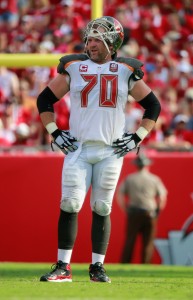
After joining the Buccaneers via trade with New England in 2014, Mankins went on to start in all 31 of his appearances in Tampa Bay, where he continued his long run as one of the league’s premier guards. Depending on how Pamphile does filling in for Sweezy, Mankins’ exit could have a highly negative effect on the Buccaneers’ offense for at least the first few weeks of the upcoming season.
Defensively, the Buccaneers didn’t re-sign cornerback Sterling Moore after he started in nine of 16 appearances last season and led their underwhelming group of corners in snap percentage (64.9) and pass breakups (six). With the additions of Grimes and first-round pick Vernon Hargreaves III (more on him in a bit), the departure of the unspectacular Moore – now in Buffalo – shouldn’t serve as much of a hindrance in 2016. It might have made sense for the Bucs to re-sign the 26-year-old as depth, but that didn’t materialize.
In addition to Moore, Tampa Bay let defensive tackle Henry Melton walk after only one year with the team. A Pro Bowler with the Bears in 2012, Melton – who signed with the Broncos on Sunday – is a rotational player nowadays. Nevertheless, Melton partook in all 16 games of the Buccaneers’ games and finished fourth among their defensive linemen in snap percentage (46.5). Melton also logged two sacks and a pair of fumble recoveries, but PFF rated the 29-year-old a below-average 101st among 123 qualified interior D-linemen in overall performance. Without Melton and Tony McDaniel, who participated in over 26 percent of the Buccaneers’ defensive snaps in 2015 and signed with the Seahawks last week, the Bucs’ depth (or lack thereof) at D-tackle could be an issue. Of course, the anchor in the middle – Gerald McCoy – remains in place, and he helped Tampa Bay to the second-best YPC against (3.4) in the league last season.
Moving over to special teams, kicker Connor Barth converted a respectable 23 of 28 field goals and hit 25 of 26 extra points in 2015, but the Buccaneers went for what they hope will be a major upgrade in the draft and subsequently gave Barth his pink slip. Barth, who’s now with the NFC South rival Saints, made 85 percent of his field goals (91 of 108) in two different stints with the Bucs.
Trades:
- Acquired a 2016 first-round pick (No. 11) and a 2016 fourth-round pick (No. 106) from the Bears in exchange for a 2016 first-round pick (No. 9).
- Acquired a 2016 second-round pick (No. 59) from the Chiefs in exchange for a 2016 third-round pick (No. 74) and a 2016 fourth-round pick (No. 106).
Draft picks:
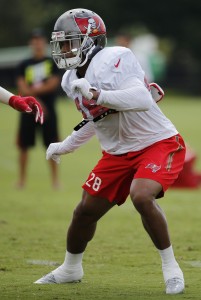
Not only did the Buccaneers gain a fourth-round pick when they made a trade with the Bears and moved down two spots in the first round of this year’s draft, but they also ended up with ex-Florida cornerback Vernon Hargreaves III at No. 11 overall. So far, the decision is paying dividends. In the Buccaneers’ 27-21 preseason win over Jacksonville on Saturday, the Jags targeted Hargreaves three times and failed to complete a pass – unless completions to Hargreaves count. The 21-year-old intercepted two passes and hasn’t yet allowed a completion in two exhibition games. As a result, Hargreaves is PFF’s highest-rated preseason corner thus far.
In assessing Hargreaves, who picked off 10 passes in three seasons with the Gators, PFR scouting guru Dave-Te Thomas wrote: “He will hustle and run down a ball carrier from across the field and seems to enjoy the contact in run force. He plays at full speed and few players in the game of football can match his quickness. He competes for the ball with no regard for his body.”
Twenty-eight picks after grabbing Hargreaves, the Buccaneers chose former Eastern Kentucky edge rusher Noah Spence, who drew first-round buzz before the draft. Spence fell thanks in part to character concerns, though, as multiple failed drug tests at Ohio State caused the Big Ten to declare him permanently ineligible in 2014. Spence then transferred to Eastern Kentucky, where he recorded 11.5 sacks last year. In 2013, his second and final season as a Buckeye, Spence accumulated 14 tackles for loss and 7.5 sacks. For the time being, the Bucs will use Spence in pass-rushing situations, Smith told Jenna Laine of ESPN.com earlier this month.
“We’re going to have to be very careful about what we’re going to ask him to do early on in the season,” said Smith.
On Spence, Thomas offered: “Despite his boneheaded mistakes off the field, Spence is an instinctive player, but not the type that will out-think himself on the field. He is a quick reactor to action in front of him and easily picks things up well, showing no problem taking plays from the chalkboard to the playing field. There should be no issues with him digesting a complicated playbook. Spence is reliable, works hard in the weight room, and is a self-starter. He takes well to hard coaching and is the unquestioned leader of the defensive unit. For his age, he had an advanced knack for reading the quarterback well, as it is rare to see him fooled by misdirection or play action.”
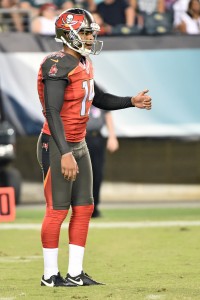
Not content to end up with just Spence in the second round, Licht swung a trade that sent a third- and fourth-rounder (Nos. 74 and 106) to the Chiefs for the 59th pick. In making that move, Licht paid a high price – 141 cents on the dollar – per Chase Stuart of Football Perspective. To Stuart (and most others), the move became that much more questionable when Licht used the selection on former Florida State kicker Roberto Aguayo, given that specialists aren’t exactly in demand that early. Licht then revealed in May that the Buccaneers placed a first-round grade on Aguayo, whose pro career has begun inauspiciously.
After missing an extra point in Tampa Bay’s preseason opener, Aguayo failed to convert two of his four field goal attempts in their second game over the weekend. There are now questions as to whether the Bucs will bring in a second kicker to compete with Aguayo, who’s coming off three straight first-team All-America seasons with the Seminoles.
Extensions and Restructures:
Earlier this month, the Buccaneers locked up their longest-tenured player, right tackle Demar Dotson, with a three-year extension that runs through the 2019 season. Dotson, who otherwise would’ve been a free agent next winter, joined the club in 2009 as an undrafted free agent from Southern Mississippi. After Dotson didn’t see much action during the first couple years of his career, he became a prominent member of the Buccaneers’ offense in 2012 and has since started 50 of 54 appearances. Only six of those appearances and three starts came during an injury-truncated 2015 for Dotson, who missed 10 games as a result of a sprained MCL. Healthy again, the soon-to-be 31-year-old is primed to start on the right side of the team’s line.
“He’s been a cornerstone player for us and our extensions that we’ve done here recently with Gerald (McCoy), Lavonte (David) and Doug (Martin), these guys all have one thing in common. They work their (tails) off and are very consistent players, very good players in the league, and you know what you’re getting out of them every day on the playing field, on the practice field,” Licht said of Dotson.
Other:
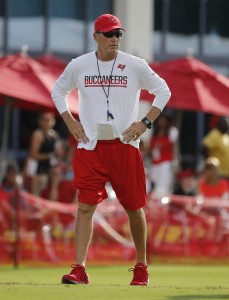
When the Buccaneers were 6-6 and in the playoff hunt last December, a January coaching change seemed out of the question. However, Year 2 of the Lovie Smith era concluded with four straight losses – three of which were one-score outcomes – and that was enough for Bucs brass to make a change. Part of the reason they moved on from Smith, perhaps, is that they didn’t want to let his offensive coordinator, Koetter, get away. With Koetter garnering head coaching consideration from other organizations, the Buccaneers tabbed him to succeed Smith. The 57-year-old Koetter worked as the Buccaneers’ O-coordinator for just one season, but the unit made obvious strides on his watch. After finishing 29th, 30th and 32nd in points, yardage and DVOA in 2014, the Bucs rose to 20th, fifth and 18th in those three categories last season.
Koetter, whose only previous head coaching experience came in the college ranks (he went a combined 66-44 at Boise State and Arizona State from 1998-2008), also helped guide Winston to a terrific showing. Winston started all 16 of the Bucs’ games, tossed 22 touchdowns against 15 interceptions, and became the youngest QB in NFL history (21) to eclipse the 4,000-yard mark.
Although Koetter is still calling the offensive plays in Tampa, he hired coordinator Todd Monken to assist him on that side of the ball. Like Koetter, Monken has experience as a college head coach, having spent the last three seasons in that role with Southern Mississippi. Monken’s familiarity with Koetter undoubtedly helped lead to his hiring — the two were on the Jaguars’ staff from 2007-10 (Koetter was the offensive coordinator, Monken the receivers coach).
Koetter also has prior ties to Smith, who hired Koetter to run the Falcons’ offense during the final three years of Smith’s tenure. The two were also on Jacksonville’s staff together in 2007. Smith is tasked with improving a defense that ended last season as a top 10 unit in terms of yardage allowed under predecessor Leslie Frazier, though that belied an 18th-place DVOA ranking and a 26th-place finish in points allowed.
End George Johnson was supposed to figure into Smith’s defense this year, but he went on season-ending injured reserve with a fractured hip earlier this month. Johnson participated in 39.4 percent of the Buccaneers’ defensive snaps in 2015 and racked up a pair of forced fumbles, but he failed to record a sack. Difficulty getting to the quarterback has been an issue at times for Johnson, who has gone without a sack in three of the four seasons in which he has seen action. In 2014, though, Johnson took down enemy QBs six times as a member of the Lions.
Top 10 cap hits for 2016:
- Gerald McCoy, DT: $13,000,000
- Vincent Jackson, WR: $12,209,778
- Lavonte David, LB: $10,000,000
- J.R. Sweezy, G: $9,500,000
- Doug Martin, RB: $8,000,000
- Brent Grimes, CB: $8,000,000
- Robert Ayers, DL: $7,750,000
- Alterraun Verner, CB: $6,750,000
- Jameis Winston, QB: $5,761,654
- Gosder Cherilus, T: $4,500,000
The Buccaneers did an adequate job of improving their roster during the offseason, and they did well in finding upgrades whose contracts won’t hurt them in the future. While the moves the Bucs made likely won’t be enough to help them break their playoff drought, further progress from Winston and a finish around the .500 mark would constitute a successful campaign. It would be unrealistic to expect more from a team that went 2-14 two years ago, has a rookie head coach and shares a division with the reigning NFC champion Panthers.
Information from Over the Cap, Spotrac, and Roster Resource was used in the creation of this post. Photos courtesy of USA Today Sports Images.
By Dallas Robinson |
at August 23, 2016 8:53 pm
Many NFL observers had not only penciled in the Colts for a lengthy postseason run, but projected Andrew Luck to be among the league’s top contenders for the MVP award. Instead, Luck dealt with injuries (and wasn’t all that productive when he was on the field), and though backup Matt Hasselbeck played well at times, the offense couldn’t handle the loss of its starting quarterback, and finished 30th in DVOA. Indy’s defense was surprisingly competent (13th in DVOA), but that performance wasn’t enough to help the club finish better than 8-8, second in the AFC South.
Notable signings:
- Dwayne Allen, TE: Four years, $29.4MM. $11.5MM guaranteed.
- Patrick Robinson, CB: Three years, $14MM. $6MM guaranteed.
- Adam Vinatieri, K: Two years, $6MM. $1MM guaranteed.
- Scott Tolzien, QB: Two years, $3.5MM. $500K guaranteed.
- Jordan Todman, RB: One year, minimum salary benefit. $480K guaranteed.
- Antonio Cromartie, CB: One year $3MM. $250K guaranteed. $500K available via incentives.
- Jack Doyle, TE: One year, $1.671MM. Signed original-round RFA tender.
- Robert Turbin, RB: One year, minimum salary benefit.
The Colts and general manager Ryan Grigson have been active spenders during the last two free agent periods, as they’ve attempted to augment their roster with external additions. During the 2014-15 offseasons, Indianapolis handed out an average of $38.5MM in guaranteed money while inking veterans such as D’Qwell Jackson, Arthur Jones, Andre Johnson, Frank Gore, and Trent Cole. This year, the club took a markedly different approach, limiting their free agent spending and disbursing less than $20MM in guarantees.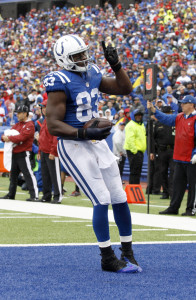
The majority of that money went towards re-signing one of the Colts’ own free agents, as the club hammered out a four-year deal to retain tight end Dwayne Allen. The 26-year-old is coming off a platform season during which he was not only hampered by ankle and calf injuries, but posted only 16 receptions for just over 100 yards and one touchdown, so it’s perhaps surprising that Allen is now among the 10 highest-paid tight ends on an annual basis.
But this contract was offered with an eye towards the future, as new Indy offensive coordinator Rob Chudzinski — a former tight ends coach who often features the position in his scheme — reportedly told Allen that he’d be more involved in the club’s gameplan going forward. Allen has flashed before (he put up a 45/521/3 line during his rookie campaign), and as Scott Barrett of Pro Football Focus noted at time of the signing, Allen has always graded out well as a blocker, both in the run and pass game.
The Colts’ only other notable re-signing was that of kicker Adam Vinatieri, with whom the club worked out a two-year deal. In 2015, Vinatieri connected on 25 of 27 field goal tries, for a 92.6% conversion rate. However, he did occasionally struggle with the longer extra point, missing three of 35 attempts. Still, there were few NFL kickers more reliable than Vinatieri, who is now third on the league’s list of all-time leading scorers. With 2,253 points, Vinatieri should be able to make a run at Morten Andersen (2,544) and Gary Anderson (2,434) as he plays out the final leg of his career.
On defense, Indianapolis found a cornerback who can slot in opposite Vontae Davis, as it agreed to terms with Patrick Robinson, who spent last season with the Chargers. A first-round pick of the Saints back in 2010, Robinson never broke out until heading to San Diego, as he started 10 games in 2015 and graded as the league’s No. 30 CB among 111 qualifiers, per Pro Football Focus.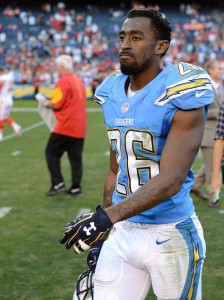
Because Davis lines up primarily on the right side, Robinson will see most of his time at left corner, although he is also capable of playing in the slot. As PFF’s Nathan Jahnke tweeted earlier this year, Robinson held quarterbacks to the third-worst rating (67.7) in the league when lined up in the slot. But with Darius Butler entrenched on the inside, Robinson will likely stay on the outside most of the time, something that Grigson confirmed when the 28-year-old was signed.
Joining Robinson in the secondary will be veteran corner Antonio Cromartie, who was just signed yesterday following news that Davis will miss at least the first month of the season with an ankle injury. Cromartie, a 10-year veteran and four-time Pro Bowler, has been on the open market since the Jets released him in February. That was the end of Cromartie’s second stint with New York, which lasted only one season. Pro Football Focus ranked him just 86th out of 111 qualified cornerbacks in 2015, but he’ll now likely be counted on to start for a quarter of the season at minimum.
While Indianapolis is planning on Robinson and Cromartie providing consistent production in the defensive backfield, the club is surely hoping that Scott Tolzien doesn’t see many — if any — snaps this year as he serves as Andrew Luck‘s backup at quarterback. Luck is coming off an injury-wrecked season, but the Colts were able to stay afloat thanks in some part to the play of Matt Hasselbeck.
Tolzien, meanwhile, doesn’t have anywhere close to the level of experience that Hasselbeck did, as Tolzien has only attempted 91 passes during his career. As such, it’s fair to wonder why Indy didn’t target a more high-profile backup signal-caller. But, as former Colts offensive coordinator Tom Moore once said (in an extremely colorful way), clubs are usually finished if their starting quarterback goes down, so perhaps not investing in a No. 2 option is the smart strategy.
Indianapolis doesn’t have much depth behind Luck, and the club is also short on options behind running back Frank Gore, who is entering his age-33 season. Veteran free agent additions Jordan Todman and Robert Turbin, each of whom signed minimum salary benefit deals, both figure to make the roster and would likely share carries if Gore suffers an injury. However, 2016 undrafted free agent Josh Ferguson has been drawing rave reviews, and could leap both Todman and Turbin for playing time.
Continue reading about the Colts’ offseason…
Read more
Notable losses:
- Colt Anderson, S
- Ahmad Bradshaw, RB
- Coby Fleener, TE
- Jerrell Freeman, LB
- Josh Freeman, QB: Released
- Matt Hasselbeck, QB: Retired
- Dan Herron, RB
- Khaled Holmes, C: Waived
- Andre Johnson, WR: Released
- Ryan Lindley, QB: Waived
- Lance Louis, G
- Dwight Lowery, S
- Jonathan Newsome, LB: Waived
- Andy Studebaker, LB: Waived
- Greg Toler, CB
- Bjoern Werner, DE: Waived
- Charlie Whitehurst, QB
- Billy Winn, DL
The Colts were always going to be forced to choose between tight ends Dwayne Allen and Coby Fleener, and according to Fleener, Indianapolis didn’t seem to struggle with their decision. “The Colts’ lack of interest and the Saints’ interest made going to New Orleans an easy choice,” Fleener told Mike Wells of ESPN.com earlier this year. 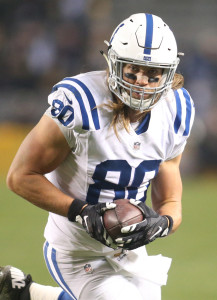 Allen is probably the more complete tight end, but Fleener holds the advantage in terms of pure receiving talent, and he could be in line for a massive season catching passes from Drew Brees. Allen scored a slightly larger annual salary, but Fleener secured $3MM+ more in guaranteed money.
Allen is probably the more complete tight end, but Fleener holds the advantage in terms of pure receiving talent, and he could be in line for a massive season catching passes from Drew Brees. Allen scored a slightly larger annual salary, but Fleener secured $3MM+ more in guaranteed money.
Indy’s passing attack will also be without veteran wide receiver Andre Johnson, who was released just one season into a three-year deal, meaning he earned $10MM+ for one campaign’s worth of work. Johnson, who has since signed with the division-rival Titans, posted the worst season of his career in 2015, struggling to create separation from defensive backs while managing only 503 receiving yards and two scores. The Texans looked to have made the right decision in parting ways with Johnson after 2014, and his deal with the Colts is just one more black mark on general manager Ryan Grigson‘s ledger. Running back Ahmad Bradshaw, who has been incredibly productive on a per-play basis with Indy, was placed on injured reserve in November and hasn’t drawn any known interest on the open market.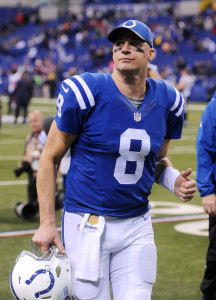
Elsewhere on offense, veteran quarterback Matt Hasselbeck — who helped the Colts stay on the fringes of the playoff race despite a bundle of injuries — decided to retire, despite the fact that he posted relatively results in 2015. In eight starts, Hasselbeck posted a 5-3 record, completed 61% of his passes for 1,690 yards, and threw nine touchdowns against five interceptions. Although he likely would have been welcomed back for another season in Indianapolis, Hasselbeck instead chose to become an analyst for ESPN.
Center Khaled Holmes and guard Lance Louis spent more than 700 snaps trying to protect Hasselbeck, but neither will be back with the Colts in 2016. Both were slightly below-average players last season, but it was a tad surprising that Indy chose to cut ties with Holmes, who is still only 26 years old. Clearly, Holmes wasn’t going to continue to start after the Colts drafted Ryan Kelly in the first round, but he could have been a relatively valuable depth piece on an offensive line that has struggled with injuries.
On the defensive side of the ball, the most talented player walking out the door is linebacker Jerrell Freeman, who was lured to Chicago by a three-year, $12MM deal. There 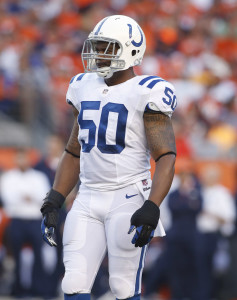 were conflicting reports as to whether the Colts were serious about retaining Freeman, a former CFLer who ranked as PFF’s No. 4 linebacker last season. While Freeman says Indianapolis never actually made him an offer, other reports indicated that the Colts proposed the same contract that he ultimately signed with the Bears.
were conflicting reports as to whether the Colts were serious about retaining Freeman, a former CFLer who ranked as PFF’s No. 4 linebacker last season. While Freeman says Indianapolis never actually made him an offer, other reports indicated that the Colts proposed the same contract that he ultimately signed with the Bears.
Grigson has taken his fair share of heat for failed free agent signings, but Dwight Lowery, who agree to a minimum salary benefit contract prior to 2015, was a success story, as the veteran safety started all 16 games and served as a stabilizing presence in the secondary. However, Lowery is now 30 years old, so letting him walk and sign a three-year deal with the Chargers was also an idea I can get behind. Fellow defensive back Greg Toler is gone as well, but the Colts shouldn’t worry too much his loss, as he ranked about the six worst corners in the league last season, per PFF.
None of Bjoern Werner, Billy Winn, Jonathan Newsome, or Colt Anderson played more than 350 snaps on defense last year, and although all four played some sort of role on special teams, the Colts ranked in the middle of the pack on teams, so the club probably won’t miss anyone from this group. Werner, notably, is a former first-round pick who only posted 6.5 sacks in three seasons in Indy, while Anderson was part of perhaps the worst play in NFL history.
Trades:
- Acquired a 2016 second-round pick (No. 57), a 2016 fourth-round pick (No. 125, and a 2016 seventh-round pick (No. 248) from the Packers in exchange for a 2016 second-round pick (No. 48).
Draft picks:
Offensive line has been an issue in Indianapolis since Andrew Luck entered the league in 2012, and the club has tried a variety of combinations in order to keep Luck upright. The front five hasn’t been stellar in the run game, either, as they ranked 27th in Football Outsiders’ adjusted line yards metric last season. With that in mind, the Colts used their first-round pick on center Ryan Kelly, whom some evaluators considered the most pro-ready offensive lineman in this year’s draft.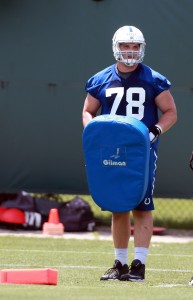
Kelly was immediately installed as Indy’s first-team center, and he should prove to be an upgrade over Khaled Holmes (who was waived) and Jonotthan Harrison. PFR’s scouting guru Dave-Te Thomas is a fan of Kelly, as well, writing that the Alabama alum will bring an “instant nastiness” to the Colts offensive line.
“Strength is needed [at center in the Colts’ scheme] in order to stall the bull rush and help in widening the rush lanes,” writes Thomas. “Quick feet and fluid retreat skills are required, as it is often the center that has to drop back and protect the pocket in passing situations. A long reach, firm anchor and great balance are important for the center, as he is usually asked to work in combination with his guards getting out in front on traps and pulls. These are all the traits that Kelly brings to the table…”
Second-rounder T.J. Green will also be expected to contribute from the get-go, as he’s penciled in as the Colts’ starting strong safety given that Clayton Geathers is still dealing with a foot injury. Defensive coordinator Ted Monachino says Green still has some work to do, but the former Clemson Tiger has a fan in Thomas. “Do not be fooled by Green’s lack of experience,” says Thomas. “He has keen football instincts and field awareness, showing good urgency taking proper angles to close and shows a good feel in zone coverage to pick up and anticipate on the switch-off and combo routes. He processes the action in front of him well and gets a quick jump on the ball in run support.”
Extensions and Restructures:
The Colts made Andrew Luck the highest-paid player in NFL history on a per-year basis, but the deal still seems like an underpay, a conclusion reached by many league observers. Luck had all sorts of leverage during negotiations, even coming off a lost season, but he still failed to top the $25MM salary mark, a plateau that most believed he would easily reach. Additionally, Luck didn’t overtake Aaron Rodgers in terms of guaranteed money ($54MM to $47MM), a fact that’s even more stunning considering that Rodgers signed his extension three years ago.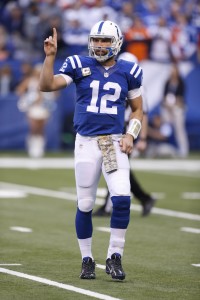
Luck, whom the Colts chose No. 1 overall out of Stanford in the 2012 draft, completed just 55.3% of his passes and logged 15 touchdowns against 12 interceptions in his injury-riddled, seven-game fourth season. Prior to that, however, he led the league with 40 touchdown passes in 2014 and helped guide the Colts to an AFC title game berth. After going 2-14 in the bridge year between the Peyton Manning era and Luck’s tenure, the Colts posted three consecutive 11-5 seasons from 2012-2014. With Luck on the sideline for most of last season, Indy finished 8-8 and failed to make the playoffs.
All in all, the Colts look to have scored a team-friendly deal, and as Stephen Holder of the Indianapolis Star noted earlier this year, the contract doesn’t figure to negatively affect the club’s cap in years to come given that the league-wide salary cap will continue to rise. From Luck’s point-of-view, the pact ends one year after the CBA expires and a year before the current TV deals are done. Although Luck will be 32 then, he could be in line for a much larger deal on the other side of this lucrative extension.
Other:
In one of the most shocking turn of events during the offseason, the Colts retained both general manager Ryan Grigson and head coach Chuck Pagano, ensuring that the pair of decision-makers are 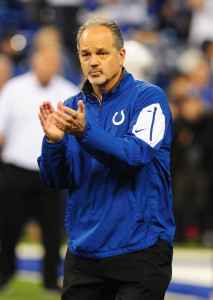 now “contractually tied” through 2019, as owner Jim Irsay put it. Despite the duo’s success together, nearly every indication was that Pagano was certainly on his way out, while Grigson was also a candidate to be fired. Pagano and Grigson’s relationship was reportedly “toxic,” and the two lacked any sort of communication throughout the season, but it seems as though the pair’s record together — 41-23 — won out over any sort of personal conflict.
now “contractually tied” through 2019, as owner Jim Irsay put it. Despite the duo’s success together, nearly every indication was that Pagano was certainly on his way out, while Grigson was also a candidate to be fired. Pagano and Grigson’s relationship was reportedly “toxic,” and the two lacked any sort of communication throughout the season, but it seems as though the pair’s record together — 41-23 — won out over any sort of personal conflict.
Pagano will have several new coaches working under him, including one, defensive coordinator Ted Monachino, with whom he has prior experience. Monachino was Baltimore’s linebackers coach when Pagano was the club’s DC, so the two should be on the same page in terms of scheme and personnel. Former Dolphins head coach Joe Philbin, meanwhile, will be tasked with overhauling an offensive line that has struggled to maintain any semblance of continuity during Pagano’s tenure.
Finally, veteran defensive lineman Arthur Jones will miss the first four games of the season after being popped for PEDs, but it’s hard to say that Jones will represent a major loss for the Colts. After coming over from Baltimore before the 2014 season, Jones has been either ineffective or hurt (he missed all of last year with injury), and was forced to take a paycut earlier this year. Fourth-rounder Hassan Ridgeway looks like the biggest beneficiary of Jones’ absence, as the could take over the starting role for the first quarter of the season, and perhaps beyond.
Top 10 cap hits for 2016:
- Andrew Luck, QB: $18,400,000
- T.Y. Hilton, WR: $11,000,000
- Anthony Castonzo, T: $9,800,000
- Dwayne Allen, TE: $8,906,250
- Vontae Davis, CB: $8,375,000
- Gosder Cherilus, T: $5,800,000 (dead money)
- D’Qwell Jackson, LB: $5,750,000
- Trent Cole, LB: $5,903,750
- Robert Mathis, LB: $5,000,000
- Erik Walden, LB: $4,250,000
This offseason, the Colts stopped trying to improve their club by signing over-the-hill veterans, and instead sought to augment their roster through a few cheap free agent contracts and the draft. The AFC South hasn’t gotten any easier, as the Texans may have found a quarterback and the Jaguars supplemented their defense, but as long as Indianapolis has its franchise quarterback in Andrew Luck, contention should be within the club’s grasp.
Information from Over the Cap, Spotrac, and Roster Resource was used in the creation of this post. Photos courtesy of USA Today Sports Images.
By Connor J. Byrne |
at August 18, 2016 6:26 pm
For the majority of NFL teams, finishing the regular season with 10 wins and picking up a playoff victory would constitute a successful year. The Packers accomplished those feats in 2015, yet their season was at least somewhat of a disappointment, especially after they got off to a 6-0 start. As the Packers scuffled over the season’s final 10 games, so did superstar quarterback Aaron Rodgers, whose descent (by his lofty standards) began in Week 8 during a 77-yard showing in a 29-10 loss to the eventual Super Bowl champion Broncos.
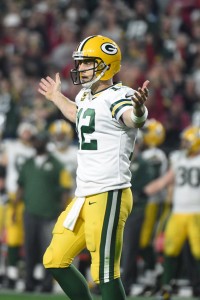
Including their shellacking in Denver, the Packers closed the regular season 4-6 and shockingly lost three of four games at Lambeau Field during that stretch. Each of those home defeats came at the hands of the NFC North, a division Green Bay had won four straight times entering last season. The final blow, a 20-13 decision against Minnesota in Week 17, cost the Packers the division and gave Minnesota its first North title since 2009. The Packers regained some of their mojo in the playoffs, going on the road to blow out the Redskins and then losing an overtime thriller to Arizona in one of the greatest games ever played, but they never really resembled Super Bowl contenders after their season-opening hot streak.
Part of the problem for Green Bay was the absence of standout No. 1 receiver Jordy Nelson, who didn’t play a game last season after suffering a torn ACL over the summer. The loss of Nelson took a player who had combined for 183 receptions, 2,833 yards and 21 touchdowns from 2013-14 away from the Packers’ Rodgers-led aerial attack. Rodgers and the offense in general didn’t enjoy life without Nelson, but with the wideout now healthy, the team will try to return to its division-winning, championship-contending ways.
Notable signings:
- Mason Crosby, K: Five years, $16.1MM. $5MM guaranteed.
- James Starks, RB: Two years, $6MM. $1.5MM guaranteed. $600K available annually via incentives.
- Nick Perry, LB: One year, $5MM. $1.5MM guaranteed.
- Jared Cook, TE: One year, $2.75MM. $825K guaranteed. $900K available via incentives.
- Lane Taylor, OL: Two years, $4.15MM. $600K guaranteed.
- Letroy Guion, DT: Three years, $11.25MM. $500K guaranteed. $250K available via escalators.
- Lerentee McCray, LB: One year, $800K. $50K guaranteed.
- Don Barclay, OL: One year, $700K.
As he has typically done since taking the reins as the Packers’ general manager in 2005, Ted Thompson largely eschewed the free agent market and mostly focused on retaining homegrown talent during the offseason. Of the Packers’ six most expensive signings this year, four were originally acquired either in the draft or, in offensive tackle Lane Taylor‘s case, as an undrafted free agent. Another, defensive tackle Letroy Guion, had been a Packer the previous two years.
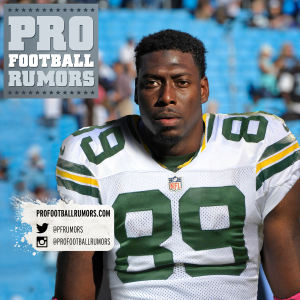
The Packers’ most notable outside pickup during the winter was tight end Jared Cook, to whom they committed just one year and $2.75MM. Given that Cook only ended up on the market after the Rams released him, the Packers won’t have to surrender a compensatory draft pick for signing the 29-year-old.
Before joining the Packers, the 6-foot-5, 254-pound Cook was durable and productive in Tennessee and St. Louis from 2011-15, missing a mere three of 80 games and combining for 235 catches, 3,064 yards and 15 scores. Last season was the only one during that five-year period in which Cook caught fewer than 44 passes (39) and three TDs (zero). He hasn’t visited the end zone since Dec. 7, 2014, to be exact, and on another alarming note, led tight ends in drops (10) last season, per Evan Silva of Rotoworld. Cook also underwent foot surgery a couple months after signing with Green Bay, but he returned to the field last week and has since impressed Rodgers. The two-time MVP lauded Cook’s speed Monday and likened him to field-stretching ex-Packers tight end Jermichael Finley.
Between Cook and Richard Rodgers, who caught 58 passes and scored eight times a year ago, the Packers have a tight end duo capable of being among the league’s most prolific. Rodgers will cede targets to Cook, though, after dominating Packers tight ends in snaps last season (799 to second-place finisher Justin Perillo‘s 115). Part of that was on account of a torn MCL that kept Andrew Quarless out for most of the season. When Quarless was healthy two years ago, he and Rodgers combined for 1,108 snaps. With Cook replacing Quarless, who’s now with the division-rival Lions, Green Bay’s reliance on its top two tight ends should revisit (and perhaps exceed) its 2014 level.
Continue reading about the Packers’ offseason..
Read more
In addition to Cook, running back James Starks will serve as one of the Packers’ skill-position weapons in 2016. Starks spent his first six seasons with the Pack, but the 30-year-old drew offseason interest from at least two other teams (the Patriots and Dolphins) before re-upping in Green Bay through 2017. Starks, who logged career highs in several key categories last season, will continue as a steady backup to the slimmed-down Eddie Lacy.
“Eddie and James is our 1-2 punch,” head coach Mike McCarthy told Rob Demovsky of ESPN.com. “That’s been an excellent combination now going into our third year with those two guys. It’s important to establish that and make sure those guys touch the football.”
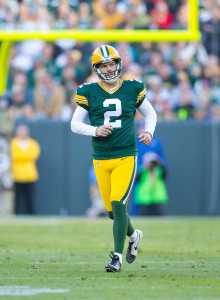
Every time Starks has scored during his career, Mason Crosby has kicked the extra point. That’s not going to change, as he easily landed the Packers’ largest offseason deal in length (five years), total value ($16.1MM) and guarantees ($5MM). Crosby, a Packer since they picked him in the sixth round of the 2007 draft, is now one of the league’s highest-paid kickers. The 31-year-old was mediocre from 2007-10 and a disaster in 2012, but he has otherwise connected on between 81.8 percent and 89.2 percent of field goal tries during the other four seasons of his career. Crosby hit 24 of 28 attempts (85.7 percent) and made all but one of five kicks from 50-plus yards (the miss was blocked) last season. He was also one of only two kickers to go without a miss on at least 35 extra points (he had 36).
On a per-year basis, outside linebacker Nick Perry collected the Packers’ most expensive offseason contract. Perry will rake in $5MM this season, but the team didn’t commit to him beyond that. Green Bay actually elected in 2015 to decline Perry’s fifth-year option for $7.75MM, so the club came out on top in retaining him for less. Ideally, though, Perry would have been worthy of that option. Instead, the 2012 first-rounder (28th overall) hasn’t quite lived up his draft status. He’s decent depth, however, and has totaled 12.5 sacks and five forced fumbles during his career. Perry amassed 3.5 sacks and one forced fumble while partaking in 33.4 percent of the Packers’ defensive snaps last season, leading Pro Football Focus (subscription required) to assign his performance a mediocre 58th-place ranking among 110 qualified edge defenders.
For the third season in a row, Guion will be one of the linemen in front of Perry. The 322-pounder avoided free agency by inking a three-year, $11.25 deal a month beforehand, though his contract contains a measly $500K in guarantees. Guion’s earning power took a serious hit as a result of a February 2015 felony arrest, one which came after Starke, Fla., police found 357 grams of marijuana and an unloaded gun in his truck. Guion ended up accepting a plea deal and settling the matter a month later, but the league subsequently hit him with a three-game suspension to begin last season. By including little in the way of guarantees in their pact with Guion, the Packers protected themselves against future off-field incidents and kept a solid nose tackle on a low-risk accord.
B.J. Raji is at least temporarily out of the picture (more on him in the next section), and fellow lineman Mike Pennel will miss the year’s first four games thanks to a substance abuse violation, making Guion all the more important to the Packers’ cause in 2016. Notably, when Raji sat out the entire 2014 season with a torn right biceps, Guion started all of Green Bay’s games and easily led their interior D-linemen in snap percentage (50.1).
Notable losses:
- Brett Goode, LS
- Casey Hayward, CB
- James Jones, WR
- John Kuhn, FB
- Andy Mulumba, LB
- Mike Neal, LB
- Nate Palmer, LB: Waived
- Andrew Quarless, TE
- B.J. Raji, DT: Hiatus
- Sean Richardson, S
- Scott Tolzien, QB
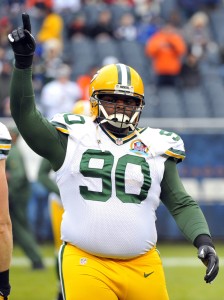
As mentioned, Raji is no longer a member of the Packers, making this the first time since 2008 that Green Bay is entering a season without the 334-pounder under its control. The Packers wanted to re-sign Raji, who’s currently a free agent, but the 30-year-old is taking a hiatus from the sport.
Aside from missing 2014, Raji had been a mainstay along the Packers’ front since they drafted him ninth overall in 2009. Raji started in all 77 of his appearances from 2010-15, including 15 last season. His 2016 showing didn’t impress PFF, however, as the site ranked him 97th among 123 qualified interior defensive linemen. With Raji as the centerpiece of their line last season, the Packers ended up 21st in rushing defense (119.1) and tied for 26th in yards per carry against (4.5). They were a much better 13th in run defense by Football Outsiders’ standards, though, after the site gave the Packers a 24th-place ranking in that department without Raji in 2014.
Along with Raji’s exit came the departure of cornerback Casey Hayward, who parlayed his 51-game, nine-interception stint in Wisconsin into a reasonable deal with the Chargers. Although Hayward went without an interception last season after picking off three the previous year, he spent time both in the slot and on the outside, started a career-high 11 games and graded as PFF’s 16th-best corner among 111 qualifiers. During his run in Green Bay, which began when it grabbed him in the second round of the 2012 draft, Hayward lined up in the slot on 65.4 percent of the passing downs in which he participated and held opposing quarterbacks to a weak 72.1 rating on those plays (via Jared Durbin of CBS Sports).
As good as Hayward is, the Packers still look fine at corner with Sam Shields, Damarious Randall, Quinten Rollins and Demetri Goodson set to comprise their top four. Of course, enemy offenses will put their depth to the test early on account of Goodson’s four-game PED suspension. Their next two corner options, Ladarius Gunter (40 snaps) and Daniel Robertson (zero snaps), garnered little experience as undrafted rookies last season.
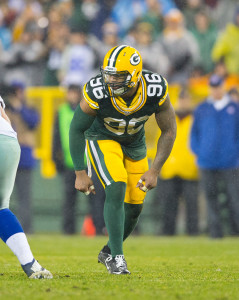
In addition to Raji and Hayward, the Packers’ defense also lost linebackers Mike Neal and Nate Palmer, who combined for 1,273 snaps a year ago. Most of those (734) went to Neal, who trailed only Clay Matthews among Packers linebackers. He also racked up 16 appearances for the third straight year and at least four sacks for the fourth straight season. Nevertheless, Neal remains a free agent, which he heavily attributes to the league’s ongoing investigation into claims that he and a handful of other players previously took performance-enhancing drugs. Matthews and Julius Peppers, both of whom have agreed to cooperate with the NFL, are also involved in that probe. Neal, on the other hand, hasn’t yet consented to an interview with the league regarding the accusations. If he doesn’t by next Thursday, he’ll face a suspension.
Neal’s ouster from Green Bay came as part of an offseason outside linebacker remodeling, as Ryan Wood of USA Today detailed in May, with Matthews headed back there from the middle, third-rounder Kyler Fackrell coming in, and third-year man Jayrone Elliott in line for more playing time. Of course, Green Bay also has Peppers and Perry on the outside, and Datone Jones – previously a full-time defensive end – is in the mix, too. Thus, the Packers are amply prepared for life without Neal and Palmer.
Offensively, the Packers chose not to re-sign a pair of fan favorites – receiver James Jones and fullback John Kuhn. Jones was a Packer from 2007-13, but he left for the Raiders in 2014. That didn’t work out, nor did a brief summer fling with the Giants, so he returned to Green Bay last September and ended up catching 50 passes for 890 yards (good for an excellent 17.8 YPC) and eight touchdowns. Despite that respectable production, the Pack didn’t show any real interest in re-upping Jones, who took a deal with the Chargers earlier this month.
The Jones-less Packers are in better shape than most at receiver, where Nelson will return to join Randall Cobb as their two best options. However, Davante Adams disappointed last season, Jared Abbrederis and Ty Montgomery combined for 24 catches, and playoff hero Jeff Janis is out for the foreseeable future with a broken hand.
As for Kuhn, he became an improbable success story with the Packers after signing with them in 2007. Now a Saint, Kuhn missed only five games in nine years with the Packers, made four Pro Bowls and, including playoffs, scored 30 combined touchdowns as a runner and receiver. In a league that’s phasing out fullbacks, Kuhn still managed to appear in 26.6 of Green Bay’s offensive snaps last season. Aaron Ripkowski, a 2015 sixth-rounder, will replace Kuhn in Green Bay. Their fans won’t have as easy a time chanting his name as they did Kuhn’s, though.
Trades:
- Acquired a 2016 second-round pick (No. 48) from the Colts in exchange for a 2016 second-round pick (No. 57), a 2016 fourth-round pick (No. 125), and a 2016 seventh-round pick (No. 248).
Draft picks:
In hopes of securing a couple long-term building blocks up front, the Packers addressed the lines with their first two draft picks. Their top choice, well-rounded defender Kenny Clark (No. 27 overall), amassed 73 tackles and 5.5 sacks en route to third-team All-America honors last season at UCLA. In the wake of Raji’s quasi-retirement, the Packers will rely heavily on Clark as a rookie. He’s primed to start alongside Guion and Mike Daniels as they look to stuff the run and aid a Green Bay pass rush that produced the seventh-most sacks in the league (43) in 2015. Clark should contribute in both areas, as PFF’s Steve Palazzolo highlighted in a pre-draft scouting.
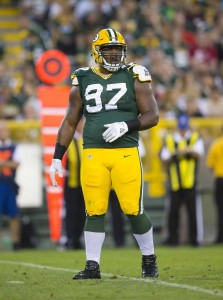
In assessing Clark, PFR’s own scouting expert, Dave-Te Thomas, wrote: “Clark has a very explosive initial step with quick feet, good athleticism and balance for his size, along with the body control and low pad level to come off the snap and get an immediate advantage versus a lethargic offensive lineman. He flashes a strong, consistent hand punch, enough to consistently put the blocker up on his heels, driving with good leverage walking that lineman back into the pocket. He has that initial burst needed on movement and the suddenness to gain advantage when engaging double teams. He has good initial quickness coming off the snap and for a player of his size, that burst can surprise an offensive lineman.”
With their second pick, the Packers moved up to take ex-Indiana offensive tackle Jason Spriggs in Round 2. In doing so, they gave up the 57th, 125th and 248th picks, which Chase Stuart of Football Perspective estimated in May as Green Bay paying the Colts 130 cents on the dollar.
Initially, Spriggs will act as depth behind starting tackles David Bakhtiari and Bryan Bulaga – who combined to miss six games last season. Bulaga hasn’t played a 16-game season since 2010, his rookie year, so Spriggs’ presence might come in handy immediately. Going forward, Spriggs could replace impending free agent Bakhtiari on the left side next year. in the meantime, the 301-pound Spriggs will have work to do, as Thomas explained, “Spriggs has a tall frame with minimal body fat, but will need to add at least 20 to 25 pounds of bulk to succeed at left tackle.”
Like Spriggs, the aforementioned Fackrell might not contribute much this year. As mentioned, the Packers are loaded with depth at outside linebacker, for one, and the third-rounder from Utah State got off to an inauspicious start at camp. On a better note, Fackrell picked up a sack against the Browns in the Packers’ preseason opener last Friday. He accumulated a total of 13 during his three full college seasons, including five in 2015, and will make his mark in the pros as a pass rusher (if he makes one, that is).
The Packers had two fourth-rounders, the first of which they used to select another linebacker – ex-Stanford Cardinal Blake Martinez. Green Bay might have a steal on its hands in Martinez, who is set to accrue significant playing time in the middle of its defense this year after piling up 138 tackles and two sacks last season. Thomas likens him to former Pack linebacker Nick Barnett and current Jets stalwart David Harris.
Six picks after landing Martinez, the Packers circled back to the defensive line and added former Northwestern Wildcat Dean Lowry at No. 137. Lowry, like Martinez, has a legitimate chance to emerge as a great value pick immediately. With Fennel on the shelf for a quarter of the season, Lowry will be a relied-on member of the Packers’ defense. The 296-pound end filled the stat sheet at Northwestern, where he notched 28 tackles for loss and 11.5 sacks from 2013-15.
Other:
In Perry and Jones, their top pick in 2013, the Packers have back-to-back first-rounders whose fifth-year options they’ve elected against exercising in consecutive offseasons. The club decided in May not to pick up Jones’ $8.369MM option for 2017, which could make this his last season in Green Bay. Jones, 26, had eight sacks in three seasons as a D-lineman and will look to up his production in a hybrid role this year. To prepare for reps as an edge-rushing outside linebacker, Jones lost 15 pounds during the offseason, thereby dropping his weight to 284, according to Tom McMahon of the Associated Press. The returns have been positive so far.
“He got off to a very good start, had some very good physical plays, had the sack,” defensive coordinator Dom Capers said of Jones’ performance against the Browns.
Top 10 cap hits for 2016:
- Aaron Rodgers, QB: $19,250,000
- Clay Matthews, LB: $13,750,000
- Sam Shields, CB: $12,000,000
- Julius Peppers, DE/LB: $10,500,000
- Randall Cobb, WR: $9,150,000
- Jordy Nelson, WR: $8,300,000
- Mike Daniels, DE: $7,400,000
- Josh Sitton, G: $6,850,000
- T.J. Lang, G: $6,181,250
- Morgan Burnett, S: $5,956,250
The Packers didn’t live up to expectations in 2015, but it’s still fair to regard them as legitimate Super Bowl contenders entering this season. Not only is Nelson rejoining their offense, but their elite quarterback remains the face of an all-around terrific roster. At minimum, a return to the top of what will likely be a competitive NFC North should be within reach for Green Bay. Given that there don’t appear to be any pushovers in the division, the utter dominance the Packers exhibited in going a combined 20-3-1 against the Vikings, Lions and Bears from 2011-14 is likely in the rearview mirror.
Contract information from Over the Cap and Spotrac was used in the creation of this post. Photos courtesy of USA Today Sports Images.
By Connor J. Byrne |
at August 17, 2016 8:55 pm
This past offseason brought far less upheaval to San Francisco than last year’s, but it certainly wasn’t a smooth winter for the 49ers. After racking up a paltry five wins en route to a last-place NFC West finish in 2015, the 49ers made a coaching change for a second straight year. Once the 49ers tabbed Chip Kelly to replace Jim Tomsula on the sidelines, acrimony between them and their erstwhile franchise quarterback led to months of speculation about a possible trade.
The Niners came close to sending Colin Kaepernick to the Broncos, but talks fell through after the 28-year-old refused a pay cut to join the reigning Super Bowl champions. As a result, the 49ers have a potential backup signal-caller with an $11.9MM base salary on their hands. While Kaepernick entered the summer set to compete with ex-Jaguars bust Blaine Gabbert for the starting job, a “dead arm” has recently kept the former from vying for the position. General manager Trent Baalke downplayed that Wednesday, however, and added that Kaepernick could begin ramping up activities Thursday. Regardless of whether Kaepernick or Gabbert ultimately wins the job, San Francisco looks like a strong bet to finish at the bottom of its division for the second consecutive season.
Notable signings:
- Garrett Celek, TE: Four years, $10.2MM. $3.5MM guaranteed.
- Phil Dawson, K: One year, $3.143MM. Fully guaranteed.
- Zane Beadles, G: Three years, $9.75MM. $2.8MM guaranteed. $500K available via incentives.
- Tony Jerod-Eddie, DL: One year, $1MM. $25K guaranteed.
- Shaun Draughn, RB: One year, $860K. $25K guaranteed.
- Christian Ponder, QB: One year, minimum salary benefit.
- Ian Williams, DL: One year, $3MM. $2MM available via incentives.
- Michael Wilhoite, LB: One year, $1.671MM. Signed original-round RFA tender.
- Kendall Gaskins, RB: Two years, $1.14MM.
- Ray-Ray Armstrong, LB: One year, $700K.
- Thaddeus Lewis, QB: One year, minimum salary benefit.
The 49ers entered the offseason with a whopping $62MM in cap space, but Baalke elected against indulging in any kind of a spending spree. His biggest outside expenditure during free agency was guard Zane Beadles, a former Bronco and Jaguar who has impressively logged five 16-start seasons in a row. Beadles made the Pro Bowl back in 2012, though the 29-year-old hasn’t been nearly as effective lately. In fact, Pro Football Focus (subscription required) ranked Beadles 64th out of 81 qualified guards in overall performance last season, and the Jags subsequently released him. Nevertheless, for a rebuilding team like the 49ers, investing modestly ($2.8MM guaranteed over three years) in a durable veteran was a reasonable path to take. They did the same in retaining a handful of in-house veterans, with nose tackle Ian Williams, tight end Garrett Celek, and kicker Phil Dawson serving as the most prominent members of the group.
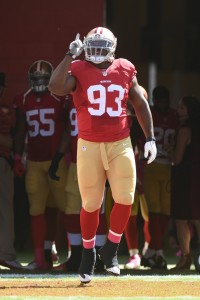
Unfortunately, an ankle injury that Williams suffered during the offseason has ruined his 2016. The 305-pounder initially agreed to a five-year contract worth more than $25MM to stay in the Bay Area, but the 49ers nixed that over concerns about how quickly he’d recover from multiple ankle surgeries. Thus, despite grading as PFF’s 18th-best interior lineman and one of its premier 3-4 nose tackles last season, Williams had to settle for a one-year, $3MM pact. But it turns out Williams’ ankle will keep him from playing at all this year, as the 49ers placed him on season-ending injured reserve last month.
Even with Williams around, the 49ers likely weren’t going to push for a playoff spot. However, Williams’ injury is still a blow to him and the team, which signed the former Notre Dame defender as an undrafted free agent in 2011 and has since helped develop into a terrific pro. With Williams out of the picture, the 49ers are especially thin at nose tackle (depth chart), where Mike Purcell and $1MM signing Tony Jerod-Eddie – a fifth-year Niner – look primed to see most of the action.
Continue reading about the 49ers’ offseason…
Read more
Celek, 28, joined the 49ers as an undrafted free agent in 2012 and finally got somewhat involved in their passing game last season. After combining for eight catches, 13 targets, 142 yards and no touchdowns during his first three seasons, Celek totaled 19 receptions, 28 targets, 186 yards and three scores in 2015. That encouraged the Niners enough to give the former blocking-only option a four-year, $10.2MM deal with $3.5MM in guarantees. It’s dubious whether Celek will continue the mild ascent he experienced in the 49ers’ offense in 2015, though, as he’s competing with Vance McDonald for a starting position and Kelly only deployed two-tight end sets 25.8 percent of the time in Philadelphia last season, per Matt Barrows of the Sacramento Bee. That’s a significant drop from the 44 percent rate of two-TE sets the 49ers utilized under Tomsula and his offensive coordinator, Geep Chryst.
Dawson, now in his age-41 season and second in San Francisco, didn’t show any obvious signs of decline last year. The 17-year veteran hit an impressive 24 of 27 field goals, good for the 10th-best success rate in the league (88.9 percent). He also connected on all three of his attempts over 50 yards and nailed 20 of 21 extra points (the miss was blocked). Dawson hasn’t converted worse than 80 percent of his field goal tries since 2006, when he made only 72.4 percent of attempts as a member of the Browns, so it appears San Francisco was wise to bring him back for just over $3.1MM.
Notable losses:
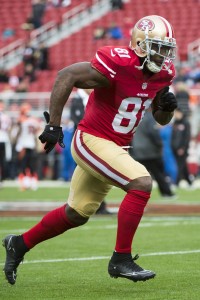
At least in terms of career accomplishments, Anquan Boldin‘s loss is easily the 49ers’ biggest. Boldin combined for 237 receptions, 3,030 yards and 16 TDs during his three-year tenure with the club. While his numbers clearly declined last year at the age of 35, Boldin still paced the Niners in yards (789) and TDs (four, tied with Torrey Smith), and more than doubled their second-leading receiver, Smith, in catches (69 to 33).
Boldin’s production won’t be easy to replace, then, though it should lead to more targets for Smith, whose first season with the 49ers was a disappointment. The former Raven inked a five-year, $40MM deal last winter and proceeded to amass the fewest receptions, targets (61), yards (663) and scores (four, tied with his 2013 total) of his five-year career. On the bright side, Smith’s streak of 16-game seasons continued and the big-play threat kept up his field-stretching ways in notching a career-high, league-leading 20.1 yards per catch.
Now that Boldin is in Detroit, Smith should be the obvious go-to option in the 49ers’ passing attack. Aside from him, it looks as though San Francisco’s top choices at wideout will be a trio of uninspiring fourth-round picks from 2013-15 – Quinton Patton (36 catches in 26 games), Bruce Ellington (19 receptions in 26 contests) and the banged-up DeAndre Smelter (zero experience). The 49ers had a potential 2016 breakout candidate in the 25-year-old Eric Rogers, a former CFL star whom half the league pursued last winter before he signed with San Francisco. But Rogers tore his ACL earlier this month and will miss the season, forcing the Niners to wait another year to evaluate him.
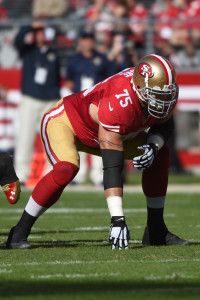
Guard Alex Boone left the 49ers after seven years with the organization for a sizable payday in Minnesota, making him the only Niners departure who earned big money elsewhere. Boone was a longtime stalwart at both guard spots in San Francisco, where he started in 59 of 60 regular-season appearances from 2012-15. One of Beadles or first-round rookie Joshua Garnett (more on him later) is likely to replace Boone on the left side this year, while either of those two or Andrew Tiller could grab the reins on the right. That position is there for Beadles, Garnett or Tiller because the 49ers waived Jordan Devey, who made nine less-than-stellar starts last year and is now a member of the Chiefs.
The 49ers lost a pair of backfield members, longtime pro Reggie Bush and Jarryd Hayne, the latter of whom retired. Hayne, who emigrated from Australia last year, tried to make his mark in the NFL after a successful rugby career. It wasn’t to be, though, as Hayne made a limited impact as a rusher and return man in eight games with San Francisco. Hayne perhaps could have pushed for a spot on the roster again this season, but the 28-year-old decided to go back to his homeland and return to rugby (which seems to be going well).
Bush, meanwhile, surprisingly made less of a dent in the Bay Area than Hayne did. While the hope when the 49ers signed Bush was that he’d continue his work as a capable dual threat and give Kaepernick a backfield weapon in the passing game, he wasn’t able to do that during a truncated campaign. Before tearing his ACL in St. Louis on Nov. 1, the former Heisman Trophy winner at USC picked up just 12 touches (eight rushes, four receptions) and 47 yards in parts of five games. Thanks to a combination of his injury, career-worst showing and age (31), the 49ers chose not to re-sign the Bush.
Trades:
- Acquired a 2016 first-round pick (No. 28) and a 2016 seventh-round pick (No. 249) from the Chiefs in exchange from a 2016 second-round pick (No. 37), a 2016 fourth-round pick (No. 105), and a 2016 sixth-round pick (No. 178).
Draft picks:
- 1-7: DeForest Buckner, DL (Oregon)
- 1-28: Joshua Garnett, G (Stanford)
- 3-68: Will Redmond, DB (Mississippi State)
- 4-133: Rashard Robinson, CB (LSU)
- 5-142: Ronald Blair, DE (Appalachian State)
- 5-145: John Theus, T (Georgia)
- 5-174: Fahn Cooper, OL (Ole Miss)
- 6-207: Jeff Driskel, QB (Louisiana Tech)
- 6-211: Kelvin Taylor, RB (Florida)
- 6-213: Aaron Burbridge, WR (Michigan State)
- 7-249: Prince Charles Iworah, DB (Western Kentucky)
For the second straight year, the 49ers chose a former Oregon defensive lineman with their top draft pick. Incidentally, Kelly was the former head coach at Oregon, where he recruited both 2015 first-rounder Arik Armstead and this year’s seventh overall selection, DeForest Buckner, to the Ducks. The pre-Kelly 49ers brought Armstead along slowly as a rookie, giving him zero starts and using him in 32.9 percent of defensive snaps. It appears the club will take a different approach with Buckner, who showed enough early in training camp to earn a No. 1 role and a solid chunk of first-half playing time in the 49ers’ preseason opener against Houston on Sunday.
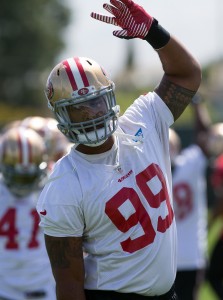
Kelly likes what Buckner has provided, saying Sunday, “I thought DeForest has had a really good camp so far and I thought he did some really good things (Sunday). There’s still some things I think he needs to clean up, but he’s obviously pushing to get a lot of playing time right now.”
Buckner garnered extensive experience during his four seasons at Oregon, but he truly shined in 2015. After accumulating 67 quarterback pressures, 10.5 sacks and 17 tackles for loss, Buckner earned Pac-12 defensive player of the year honors. Moreover, PFF’s Sam Monson wrote prior to the draft that Buckner might have been the most productive player in all of college football in 2015. If Buckner makes a seamless transition to the pros, he’ll greatly aid a 49ers team that finished 29th in both total defense and sacks last season.
With pass-rushing linebacker Aaron Lynch out for the first quarter of the season because of a violation of the league’s substance abuse policy, the Niners will need Buckner to hit the ground running. Lynch recorded 12.5 sacks during his first two years and finished 10th in the league last season in hurries (28).
The 49ers stayed in the Pac-12 with their second pick, Garnett, though they had to pay a high price to move back into the first round to land the ex-Stanford guard. In trading the 37th, 105th and 128th picks to Kansas City for No. 28, the 49ers surrendered 136 cents on the dollar, according to Chase Stuart of FiveThirtyEight. It was a questionable move, but the fact that the 49ers will be able to control Garnett for five years (it would’ve been four for any prospect they’d have chosen at No. 37) likely made the deal easier to make for the organization. Garnett was an accomplished blocker at Stanford, where he won the Outland Trophy – which is given annually to the best interior offensive lineman in the nation – and earned consensus All-America honors last year.
Opposing offenses torched the 49ers through the air last season, evidenced by their defense’s 30th-place DVOA against the pass. Further, quarterbacks put up a 98.1 rating (25th worst in the league), averaged 8.0 yards per attempt (30th) and threw just nine interceptions (tied for 26th) against San Francisco. With that in mind, the 49ers turned to their secondary with their third- and fourth-round picks. The first of those selections, ex-Mississippi State cornerback Will Redmond, is still recovering from the torn ACL that ended his college career last October. However, Redmond – whom Daniel Jeremiah of NFL.com said might have been a first-rounder if healthy – has looked good during his time with the 49ers and could be their answer at nickel corner this year, Barrows wrote earlier this week.
Blackmon is familiar with fourth-round corner Rashard Robinson from their time in the SEC. Robinson went to LSU, where he dealt with suspensions for a failed drug test and academic issues before the team dismissed him last summer after an arrest for unauthorized entry into quarterback Anthony Jennings’ apartment. Nevertheless, the 49ers felt the troubled 21-year-old’s upside was worth the gamble. Mark Dulgerian of NFL.com regarded the 6-foot-1, 177-pounder as a potential top 40 pick based on talent, but his off-field woes dropped him to the 133rd choice.
Extensions and Restructures:
San Francisco locked up two members of its front seven, linebacker NaVorro Bowman and lineman Quinton Dial, to extensions in recent months. Bowman, the more notable and accomplished of the pair, is now under 49ers control through the 2022 campaign. The move to extend Bowman, thereby adding $44MM total and $20MM in guarantees to his previous deal, surprised because he still had three years remaining on his contract at the time. At $67.5MM, Bowman now leads all inside linebackers in overall contract value.
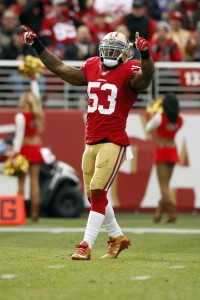
It’s remarkable that Bowman, 28, was even in position to receive an extension after suffering a devastating knee injury in January 2014. Back then, Bowman tore both his ACL and MCL in the 49ers’ NFC title game loss to Seattle, leading to questions as to whether he’d ever be an effective player again. Prior to the injury, Bowman was an elite performer with three straight first-team All-Pro seasons on his resume. Bowman missed all of 2014 while recovering, but he returned with a vengeance last season to make 16 starts, pile up a league-high 154 tackles on 1,101 snaps (first among Niners linebackers by 305) and once again nab first-team All-Pro honors.
PFF wasn’t particularly bullish on Bowman’s output, though, ranking him a so-so 51st among 97 qualified linebackers and assigning him a miserable grade in pass coverage. Still, Bowman’s comeback last season was a positive development for the 49ers in a season with few of those, and he’s now the long-term heart-and-soul leader of their defense – a role which Patrick Willis filled with aplomb before retiring last year.
Dial, meanwhile, took on full-time work for the first time in 2015, starting in each of his 15 appearances. Along the way, the 2013 fifth-round pick established new career marks in tackles (59), sacks (2.5) and defensive snaps (662), and PFF ranked his play a middle-of-the-pack 62nd among 123 qualified interior defensive linemen. The 49ers leaned heavily last year on Dial, who was second among their D-linemen in snaps (only Williams had more), and he’ll continue to give them a palatable option at a reasonable cost.
Other:
Unsurprisingly, the doomed-to-fail Tomsula era was ephemeral. Tomsula had to follow the act of an elite head coach, former boss Jim Harbaugh, and the longtime defensive assistant was in over his head from the get-go. Plus, the deck was stacked against Tomsula immediately as a result of the 49ers taking so many shots to their roster before the season began. The departures of Willis, Chris Borland, Justin Smith, Aldon Smith, Chris Culliver and Perrish Cox ravaged a once-formidable defense, while offensive cornerstones Mike Iupati, Anthony Davis and Frank Gore also went in other directions. With those important contributors no longer around, the Tomsula-led Niners stumbled to their worst record since 2007 and suffered nine double-digit defeats.
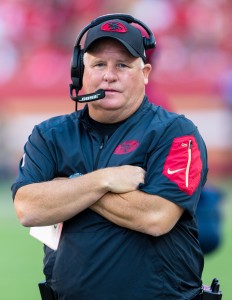
As they searched for Tomsula’s replacement, the 49ers interviewed six candidates before hiring Kelly, who wasn’t out of work long after the Eagles fired him in December. The offensive-minded, unconventional Kelly fell one game short of lasting a full three seasons in Philadelphia, where he helped the club to a respectable 26-21 record, two 10-win showings, and a playoff appearance. Those are quality results on paper, but the wheels came off after Kelly took control of the Eagles’ roster last offseason. Once that happened, his first head coaching stint in the NFL began careening off a cliff.
Kelly wasn’t exactly a players’ coach in Philly, where there were accusations of racism and complaints about daily urine tests and his fast-paced offense, so the 49ers took a risk in awarding him a $24MM contract. Kelly has experienced plenty of success at the college and pro levels, though, and it’s possible he’ll get back on track now that he no longer has primary control over an NFL roster (that’s Baalke’s responsibility). Further, as an offensive guru who has extracted career seasons from mediocre-at-best QBs like Nick Foles, Mark Sanchez and Sam Bradford, there’s a chance he’ll be able to mold either Kaepernick or Gabbert into a usable starter. Kaepernick, of course, was among the league’s best dual-threat signal-callers just a couple years ago.
To help lead his coaching staff, Kelly hired Curtis Modkins and Jim O’Neil as his coordinators. Kelly, not Modkins, is the real offensive mastermind and gives the 49ers a much more credible play caller than Chryst.
O’Neil is the defensive successor to Eric Mangini, who was in a difficult position thanks to the aforementioned losses the 49ers had to deal with last offseason. Previously the D-coordinator with the Browns from 2014-15, O’Neil had his ups and downs in Cleveland. As a rookie coordinator, O’Neil’s group finished top 10 in both yards and points allowed. However, it plummeted toward the cellar last season, ranking just 27th and 29th in those two categories. Given Kelly’s uptempo offensive attack, O’Neil has his work cut out for him in San Francisco. In his three seasons with the Eagles, Kelly’s teams had to defend more plays than any other squad in the league.
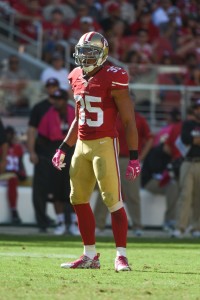
One player O’Neil is likely to coach through at least next season is safety Eric Reid, whose 2017 fifth-year option the 49ers exercised in May. Reid, who has been a full-time starter for the Niners since they selected him 18th overall in 2013, is now slated to be on their books for upward of $5.6MM next year. Reid is coming off his first season without an interception, though PFF still ranked him an above-average 36th among 89 qualified safeties in overall performance. The 24-year-old picked off a combined seven passes during his first two seasons in the league. Four of those came as a rookie in 2013, Reid’s lone Pro Bowl campaign.
Joining Reid and the rest of the 49ers this year is right tackle Anthony Davis, another player in whom the 49ers previously invested a first-rounder. Davis, the 11th pick in 2010, started in all 71 of his pro appearances through 2014 and then took a hiatus from football last season. While Davis’ return this year was expected, he took his time applying for reinstatement to the league and even swiped at Baalke and the organization via social media before officially coming out of retirement last month.
The soon-to-be 27-year-old is now working to beat out Trent Brown for his old job. Brown, not Davis, ran with the No. 1s during the 49ers’ preseason opener. Interestingly, Davis is now 30 to 40 pounds lighter than he was in 2014, per Matt Maiocco of CSNBayArea.com, but it remains to be seen whether that will affect his performance.
Top 10 cap hits for 2016:
- Colin Kaepernick, QB: $15,890,753
- NaVorro Bowman, LB: $9,554,000
- Joe Staley, T: $8,300,000
- Ahmad Brooks, LB: $8,005,000
- Torrey Smith, WR: $7,600,000
- Antoine Bethea, S: $6,025,000
- Ian Williams, DT: $4,000,000
- Tramaine Brock, CB: $3,880,000
- Erik Pears, T: $3,350,000
- DeForest Buckner, DL: $3,307,453
The 49ers were neither competitive nor interesting last season. At the very least, they should be more compelling this year with Kelly at the helm. The roster isn’t going to remind anybody of the superb one the franchise had during the halcyon days of the Harbaugh era, however, so it’s unfair to expect many wins this season. Frankly, after doing so little during the offseason to address their dearth of talent, it’ll be surprising if the Kelly-led 49ers pick outside the top 10 in next year’s draft.
Information from Over the Cap, Spotrac, and Roster Resource was used in the creation of this post. Photos courtesy of USA Today Sports Images.
By Dallas Robinson |
at August 16, 2016 9:26 pm
The Steelers have long been one of the NFL’s model organizations, with stability among their ownership group, front office, and coaching staff proving paramount to their success. Kevin Colbert is the fourth-longest tenured general manager in the league, while Mike Tomlin has the fifth-longest tenure among head coaches. Consistently among the contenders for the AFC crown, Pittsburgh entered this offseason with a mandate to get younger on the defensive side of the ball, while suspensions for two of its young offensive stars threatened to throw a wrench in its plans.
Notable signings:
- Ladarius Green, TE: Four years, $20MM. $4.75MM guaranteed.
- Ramon Foster, G: Three years, $9.6MM. $2.75MM guaranteed.
- William Gay, CB: Three years, $7.5MM. $1.9MM guaranteed.
- Robert Golden, S: Three years, $4.95MM. $1.25MM guaranteed.
- Ryan Harris, T: Two years, $3.9MM. $675K guaranteed.
- Darrius Heyward-Bey, WR: Three years, $3.8MM. $400K guaranteed.
- Bruce Gradkowski, QB: One year, minimum salary benefit. $80K guaranteed.
- Greg Warren, LS: One year, minimum salary benefit. $80K guaranteed.
- Steven Johnson, LB: One year, minimum salary benefit. $25K guaranteed.
- David Johnson, TE: One year, minimum salary benefit.
- Ricardo Mathews, DE: One year, minimum salary benefit.
Given that the Steelers had only about $10MM in available cap space heading into the offseason, it was always unlikely that the club was going to be a major player in the free agent market. And sadly, Pittsburgh’s one major external addition isn’t delivering returns as of yet, as tight end Ladarius Green hasn’t practiced this summer as he continues to deal with chronic headaches. Green, 26, suffered two concussions in the the span of two weeks last September, so the logical conclusion is that he’s still coping with the aftereffects of those brain injuries.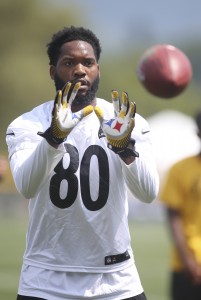
At least one report has indicated that if the headaches persist, Green could contemplate retirement, and while his long-term health is certainly the most important issue in this situation, there is also a financial component involved. If Green retires, he’d have to return his signing bonus to the Steelers, but the situation becomes more murky if Pittsburgh simply releases him. If the team feels that Green wasn’t forthcoming about his injury history at the time of signing, they’d have an argument to recoup the bonus, or at least a portion of it.
Of course, Green’s potential absence will also limit the Steelers’ offense, as he’d been set to add a new dimension to a unit that will already be without Martavis Bryant and Le’Veon Bell for varying amounts of time. Green posted 37 receptions for more than 400 yards in a limited role with the Chargers, and could’ve seen those numbers rise as he took on a full-time job with Pittsburgh. If he’s not a factor in 2016, the Steelers will instead turn to Jesse James, Xavier Grimble, and FB/TE David Johnson, who returns to the Steel City after two years in San Diego.
Receiver Darrius Heyward-Bey may also see more targets if Green is sidelined, as DHB is back with the Steelers after inking a three-year deal. Now 29 years old, Heyward-Bey 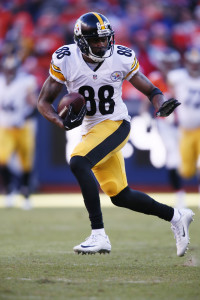 clearly never lived up to his draft billing after being chosen seventh overall in 2009, but he can still serve as a depth option and special teams player. He saw 39 targets last season, and that number figures to stay relatively stagnant, as though Bryant is suspended for the season, DHB is still behind Antonio Brown, Markus Wheaton, and Sammie Coates among the club’s wide receivers.
clearly never lived up to his draft billing after being chosen seventh overall in 2009, but he can still serve as a depth option and special teams player. He saw 39 targets last season, and that number figures to stay relatively stagnant, as though Bryant is suspended for the season, DHB is still behind Antonio Brown, Markus Wheaton, and Sammie Coates among the club’s wide receivers.
With so many of Pittsburgh’s skill players facing availability questions to start the season, the club’s offensive line could be doubly important, and veteran guard Ramon Foster will be a key factor on that front five after re-upping on a three-year pact. Foster will be entering his eighth season with the club, and he’s been remarkably durable — he played every offensive snap in 2016, and he’s appeared in 75 of 80 possible games since becoming a full-time starter. After he graded out as the No. 16 guard in the league last season (per Pro Football Focus), it’s a little surprising that the Steelers only had to invest $3.2MM annually to re-sign Foster.
Joining Foster in the offensive line room will be tackle Ryan Harris, but it’s still unclear whether the former Bronco will act as a starting option or serve as a backup. Harris 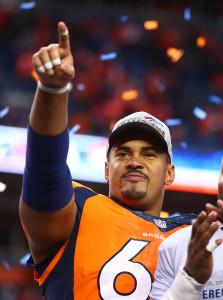 emerged as Denver’s left tackle after incumbent Ryan Clady went down for the season, and helped stabilize the club’s offensive line on the way to a Super Bowl title. With the Steelers, Harris will compete with Alejandro Villanueva, who started 10 games at left tackle for Pittsburgh as a 27-year-old rookie. So far, it sounds as though the two are neck-and-neck.
emerged as Denver’s left tackle after incumbent Ryan Clady went down for the season, and helped stabilize the club’s offensive line on the way to a Super Bowl title. With the Steelers, Harris will compete with Alejandro Villanueva, who started 10 games at left tackle for Pittsburgh as a 27-year-old rookie. So far, it sounds as though the two are neck-and-neck.
One offensive player who probably won’t contribute much during the upcoming season is veteran quarterback Bruce Gradkowski, who is dealing with a “sizable” hamstring tear suffered in the Steelers’ first preseason game. Gradkowski, 33, also missed all of last season with an injury, and his absence means Landry Jones will be the club’s clear cut No. 2 quarterback. If Pittsburgh feels the need to add another arm, Michael Vick — who played for the team last season — is still sitting on the open market, though Jeremy Fowler of ESPN.com (Twitter link) doubts that Vick will end up with the Steelers.
Safety Robert Golden, meanwhile, wasn’t re-signed with the thought that he’d be starting, but the makeup of the defensive backfield has changed enough that Golden will once again be counted on to to play a large role. 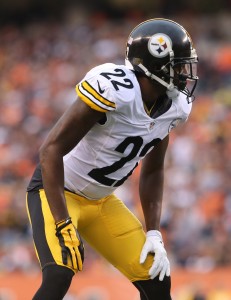 Second-round rookie Sean Davis had been ticketed to take Golden’s place as Pittsburgh’s strong safety, but following a serious injury to cornerback Senquez Golson, Davis is likely to see most of his action at slot corner, meaning Golden will see a heavy snap count in the back end.
Second-round rookie Sean Davis had been ticketed to take Golden’s place as Pittsburgh’s strong safety, but following a serious injury to cornerback Senquez Golson, Davis is likely to see most of his action at slot corner, meaning Golden will see a heavy snap count in the back end.
A convenient line of logic might dictate that linebacker Steven Johnson could play a key role as a top backup behind Ryan Shazier and Lawrence Timmons given that he comes over from the Titans, whose defense was led by former Steelers defensive coordinator Dick LeBeau. However, Johnson only saw 27 defensive snaps last season, meaning he’s simply a special teams piece. Veteran defensive lineman Ricardo Mathews, then, is a much more likely candidate to see snaps, as he should be the third defensive end behind Cameron Heyward and Stephon Tuitt.
Continue reading about the Steelers’ offseason…
Read more
Notable losses:
- Mike Adams, T: Waived
- Cortez Allen, CB: Released
- Will Allen, S
- Kelvin Beachum, T
- Antwon Blake, CB
- Brandon Boykin, CB
- Terence Garvin, LB
- Will Johnson, FB
- Doug Legursky, C
- Steve McLendon, DT
- Heath Miller, TE: Retired
- Sean Spence, LB
- Byron Stingily, T
- Shaun Suisham, K: Released then retired
- Cam Thomas, DT
- Jordan Todman, RB
- Michael Vick, QB
Heath Miller, 33, began his career back in 2005, when the Steelers selected him with the 30th overall pick in the draft. The Virginia product immediately became a starter, and appeared in 168 regular-season games (167 starts), plus another 15 playoff contests, for the franchise over the next 11 years. Miller’s best years came in 2009, when 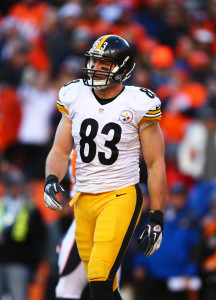 he caught a career-high 76 passes, and in 2012, when he racked up 816 receiving yards and eight touchdowns.
he caught a career-high 76 passes, and in 2012, when he racked up 816 receiving yards and eight touchdowns.
Miller remained productive for the Steelers until his final season, totaling 60 receptions, 535 yards, and two touchdowns in 2015. No tight end in franchise history accumulated more total catches (592), receiving yards (6,569), or receiving touchdowns (45) than Miller. While he probably isn’t a Hall of Famer — he doesn’t crack the top-25 in approximate value among tight ends since the merger — Miller would certainly enter Pittsburgh’s Ring of Honor (if it had one).
Aside from Miller, most of the Steelers’ offense will return next year, but the one other exception is left tackle Kelvin Beachum, who signed a unique deal with the Jaguars during free agency. Beachum is an excellent blindside protector when healthy, and given that his new contract only calls for $1.5MM in guarantees and a 2016 cap charge of $5.375MM, it was a tad surprising that Pittsburgh didn’t make a serious attempt to retain him. Instead, the Steelers will let the relatively inexperienced Alejandro Villanueva battle it out with veteran Ryan Harris for the starting job.
On defense, Pittsburgh lost or let go of four defensive backs who have all struggled to find solid homes this offseason. Of the quartet, only two have signed contracts. Slot corner Brandon Boykin first landed a deal with the Panthers and then, after being released, with the Bears, but he’s already been placed on injured reserve and will miss the season. Veteran cornerback Antwon Blake, meanwhile, secured $200K guaranteed from the Titans, but doesn’t figure to be any higher than fourth on Tennessee’s depth chart.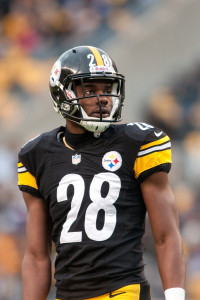
A pair of Allens, Cortez and Will, haven’t yet inked new contracts after being cut loose by the Steelers. Cortez Allen was released even though he had agreed to an extension worth nearly $25MM in 2014. Since a solid 2013 season, the 27-year-old had regressed and struggled with injuries, appearing in just 12 total games over the last two seasons. By acknowledging their mistake with Allen and cutting him, the Steelers reduced his cap number from $5.75MM to $4.05MM for 2016, creating $1.7MM in cap space.
Cortez Allen hasn’t drawn any interest since earning his release in April, and Will Allen has sat on the open market even longer, as his contract expired in March. Allen is now 33 years old, but still managed to start 13 games and play on nearly three-quarters of Pittsburgh’s defensive snaps last season. It’s possible that he could score a phone call from an interested club if injuries set in, and it’s conceivable that the Steelers may even express intrigue given the rash of injuries to their secondary.
Up front, Pittsburgh never made a serious effort to retain nose tackle Steve McLendon, who inked a three-year deal with the Jets. The Steelers were reportedly resistant to handing a hefty salary to a player who only sees the field for about 25-30% of the club’s defensive snaps. Defensive tackle Cam Thomas is also gone after the Pittsburgh declined to offer him a contract for the 2016 season. After playing on more than 40% of the Steelers’ defensive snaps in 2014, Thomas struggled to get on the field in 2015, seeing action on less than 17% of plays.
Finally, longtime Steelers kicker Shaun Suisham won’t be back with the club in 2016, and he won’t be kicking for anyone, as Suisham announced his retirement after being released earlier this year, citing the difficult recovery from an ACL tear. Over the course of his ten-year career (excluding his lost 2015 campaign), Suisham suited up for the Cowboys and Redskins in addition to the Steelers. In his last five years with Pittsburgh, Suisham has nailed 84.1% of his field goal attempts and 99.3% of his extra point tries.
Draft picks:
It’s a generally accepted narrative that the Steelers preferred William Jackson III with the 25th overall pick, but after the Bengals took yet another first-round corner at pick No. 24, Pittsburgh opted 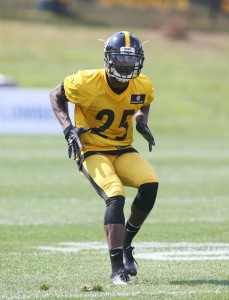 for Miami’s Artie Burns. As scouting guru Dave-Te Thomas wrote in PFR’s Impact Rookie series, Burns might not yet have the refined skills that he’ll need to develop, but he’s a born playmaker.
for Miami’s Artie Burns. As scouting guru Dave-Te Thomas wrote in PFR’s Impact Rookie series, Burns might not yet have the refined skills that he’ll need to develop, but he’s a born playmaker.
“Burns is built for speed,” according to Thomas. “He has an angular frame with very good quickness. He shows good hip snap and change of direction agility. He does not take wasted steps in transition and can close on the ball quickly when the play is in front of him.
Burns shows smoothness with his feet in his pedal and has the range to make plays along the sidelines. He shows good hand/eye coordination, but you’d like to see him generate a second gear in order to recover quicker on deep routes. He has valid feet for the position and good arm usage to stick it to receivers in press coverage.”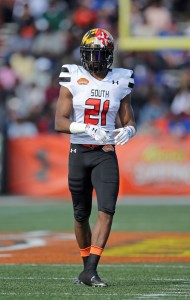
Sean Davis, meanwhile, graded higher on several evaluators’ boards, including that of Thomas and NDT Scouting’s Kyle Crabbs, who ranked Davis as No. 3 defensive back in the 2016 class behind only Jalen Ramsey and Jackson. Davis will likely have a larger role during his rookie year than will Burns, who isn’t expected to start. The former Maryland Terp had been projected to see time at strong safety, but now that Senquez Golson is set to miss four months or so with an injury, Davis has been lining up at slot corner.
Third-rounder Javon Hargrave is probably the only other Steelers rookie with a legitimate chance to see significant playing time in 2016, as he’s set to be the reserve nose guard to begin the season. Given that he’s making the leap from FCS competition to the NFL, Hargrave will certainly face a steep learning curve, but given that Daniel McCullers, who only played 105 snaps last year, is the current starter along the interior, Hargrave should have the opportunity to push for playing time.
Other:
- Declined 2017 fifth-year option for LB Jarvis Jones ($8.369MM).
- Learned WR Martavis Bryant would be suspended for the 2016 season (substance abuse policy).
- Learned RB Le’Veon Bell would be suspended four games (substance abuse policy).
- Learned CB Senquez Golson could miss up to four months with a foot injury.
- Signed 10 undrafted rookie free agents following the draft.
Two of Pittsburgh’s finest offensive weapons just can’t seem to stay out of their own way, as receiver Martavis Bryant will miss the season after another violation of the league’s substance abuse policy, while running back Le’Veon Bell is banned 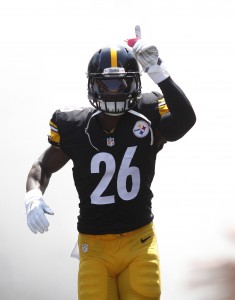 four games after reportedly missing a drug test. Bryant isn’t challenging his suspension, but Bell is, and is fairly confident that he’ll win an appeal, the results of which should be in later this week. Bell is coming off a major injury and has now been suspended twice by the league, so it’s no surprise that the Steelers aren’t currently negotiating with him as he enters the final year of his rookie deal.
four games after reportedly missing a drug test. Bryant isn’t challenging his suspension, but Bell is, and is fairly confident that he’ll win an appeal, the results of which should be in later this week. Bell is coming off a major injury and has now been suspended twice by the league, so it’s no surprise that the Steelers aren’t currently negotiating with him as he enters the final year of his rookie deal.
Pittsburgh could still work out a long-term deal with linebacker Jarvis Jones, but they chose not to lock him into a $8.369MM salary in 2017 via his fifth-year option. That’s probably the right call, as Jones simply hasn’t done enough during his three years with the club to warrant such a payday, as he graded as only the No. 67 edge defender among 110 qualifiers last season, per PFF. He’ll be a starter again in 2016, but he could lose snaps to James Harrison and Arthur Moats, which would further deplete his value.
While Jones hasn’t produced much during his time with the Steelers, cornerback Senquez Golson hasn’t produced anything, though it’s hard to fault him given that injuries have knocked him out in each of his first two seasons. After being selected in the second round of the 2015 draft, Golson was taken down by shoulder surgery, and missed the entirety of his rookie season. This year, it’s a foot ailment that will sideline him for four months, meaning that while he’s a candidate for IR/designated to return, it’s more likely that he’s absent for a second straight campaign.
Top 10 cap hits for 2016:
- Ben Roethlisberger, QB: $23,950,000
- Lawrence Timmons, LB: $15,131,250
- Antonio Brown, WR: $12,370,833
- Maurkice Pouncey, C: $10,551,000
- Cameron Heyward, DE: $10,400,000
- David DeCastro, G: $8,070,000
- Mike Mitchell, S: $6,763,750
- Marcus Gilbert, T: $6,461,000
- Cortez Allen, CB: $4,500,000 (dead money)
- Shaun Suisham, K: $3,503,000
This offseason, it seems as though the Steelers were attempting to get back to their roots in terms of roster management. In too many recent seasons, Pittsburgh had been leveraged to the hilt, constantly reworking veteran deals that created cap space in the present but presented problems down the road. This year, the Steelers didn’t renegotiate a single contract, and because they never spend serious money in the free agent market, the club’s cap situation should look better in the years to come. On the field, there’s no reason why Pittsburgh shouldn’t be considered among the favorites to represent the AFC in the Super Bowl.
Information from Over the Cap, Spotrac, and Roster Resource was used in the creation of this post. Photos courtesy of USA Today Sports Images.
By Dallas Robinson |
at August 10, 2016 11:00 am
With the exception of the Rams, perhaps no team in the NFL defines mediocrity more than the Dolphins. Since winning the AFC East with an 11-5 record in 2008, Miami has not earned another postseason appearance, posting a 49-63 record during that time while never winning more than eight games in a single season. A new coaching staff is now in place, and tasked with the same assignment that prior regimes have failed to complete time and again: dethrone the Patriots as division champions.
Notable signings:
- Mario Williams, DE: Two years, $17MM. $8.485MM guaranteed. $1.5MM available annually via incentives.
- Isa Abdul-Quddus, S: Three years, $12.75MM. $4.225MM guaranteed.
- Andre Branch, DE: One year, $2.75MM. $2.5MM guaranteed.
- Matt Moore, QB: Two years, $3.55MM. $2.25MM guaranteed.
- Jason Jones, DE: One year, $1.535MM. $1.01MM guaranteed.
- Jermon Bushrod, OL: One year, $1.5MM. $985K guaranteed.
- Arian Foster, RB: One year, $1.5MM. $400K guaranteed. $2MM available via incentives.
- Kraig Urbik, G: Two years, $2.5MM. $250K guaranteed.
- Spencer Paysinger, LB: One year, $840K. $200K guaranteed.
- Sam Young, T: One year, $910K. $150K guaranteed.
- MarQueis Gray, TE: One year, $675K.
- Isaiah Pead, RB: One year, $675K.
- Griff Whalen, WR: One year, $675K.
- Jacques McClendon, G: One year, minimum salary benefit.
- James-Michael Johnson, LB: One year, minimum salary benefit.
- Danny Lansanah, LB: One year, minimum salary benefit.
- Daniel Thomas, RB: One year, minimum salary benefit.
- Chris Culliver, CB: One year, details unknown.
Perhaps no club swung and missed more often while searching for help at a single position than the Dolphins as they trawled for a new running back after losing Lamar Miller during free agency. Miami eyed options such as James Starks and Chris Johnson, offering the latter more money than did 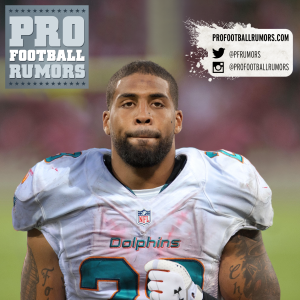 the Cardinals (with whom he ultimately re-signed), and even signed the Broncos’ C.J. Anderson to a restricted free agent offer sheet. But after Denver matched on Anderson, the Dolphins did little to augment their backfield over the next four months except select Kenyan Drake — who doesn’t project as a starter in 2016 — in the third round of April’s draft.
the Cardinals (with whom he ultimately re-signed), and even signed the Broncos’ C.J. Anderson to a restricted free agent offer sheet. But after Denver matched on Anderson, the Dolphins did little to augment their backfield over the next four months except select Kenyan Drake — who doesn’t project as a starter in 2016 — in the third round of April’s draft.
In mid-July, however, Miami finally struck a deal with veteran back Arian Foster, whom the club had first met with all the way back in March. Foster will turn 30 years old before the regular season begins, and the torn Achilles he suffered last season was just the latest in a long line of injuries that have limited him throughout his career. But, when he’s healthy, Foster is electric. In the four seasons when he’s managed to play 13+ games, Foster has rushed for at least 1,200 yards and eight touchdowns, adding an average of 50 receptions during those campaigns.
Second-year pro Jay Ajayi, Foster’s direct competition for snaps, is no beacon of health himself, as knee issues worried some draft observers in 2015 and caused Ajayi to fall to the fifth round. And regardless of the fact that Ajayi was listed as the first-team back on Miami’s “official” depth chart released this week, the Fins are clearly hoping Foster can serve as their bell-cow back. As Armando Salguero of the Miami Herald recently tweeted, Foster has shown during camp that he’s “head and shoulders the best running back on the Dolphins'” roster.
The group blocking for Foster and/or Ajayi could look a little different this season, especially at the guard position, where Miami added veterans Jermon Bushrod and Kraig Urbik. The latter is probably going to serve as depth, but the Dolphins reportedly want Bushrod to win the right guard job instead of Billy Turner. Bushrod, 31, is a career left tackle, and he’s acknowledged the difficulty of not only moving to the interior, but to the opposite side. Miami has locked-in options at center and both tackle spots, but guard will be an area to watch during camp, as Bushrod, Urbik, Turner, Laremy Tunsil, and Dallas Thomas will all compete for time.
Miami also added trench reinforcements on the defensive side of the ball, agreeing to terms with three veteran defensive ends to augment a rotation that already includes former All Pro Cameron Wake. After losing Olivier Vernon and Derrick Shelby during 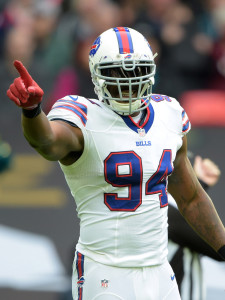 the free agent period, the club’s first move was to sign former Bills defensive end Mario Williams, who had reportedly been seeking $10MM annually. While he didn’t reach that mark, there’s some question as to whether Williams is worth the $8.5MM average he did receive.
the free agent period, the club’s first move was to sign former Bills defensive end Mario Williams, who had reportedly been seeking $10MM annually. While he didn’t reach that mark, there’s some question as to whether Williams is worth the $8.5MM average he did receive.
During his final season in Buffalo, Williams posted only five sacks and graded as the league’s No. 93 edge defender among 110 qualifiers, per Pro Football Focus, and later drew criticism from Bills head coach Rex Ryan, who said Williams complained about having to drop into coverage. New Dolphins head coach Adam Gase said Williams is going to be a “different guy” in South Beach, and he’ll have to be to justify his salary.
Along with Williams, Miami also signed Jason Jones, who last played for the Lions, and inked ex-Jaguar Andre Branch. Jones, for his part, was an especially solid addition, as the Dolphins were able to land him for only $1.5MM on a one-year contract. He’ll act as a rotational run-stuffer behind Wake and Williams. Branch, meanwhile, can’t stop the run and has never lived up to his second-round draft status, but he’s a capable pass-rusher who can produce in limited snaps. Miami could conceivably move either Williams or Wake inside next to Ndamukong Suh on passing downs, allowing Branch to get after the quarterback from the edge.
Just today, the Dolphins agreed to terms with free agent cornerback Chris Culliver, signing the former 49er/Redskin to a one-year deal. Culliver, 28 next week, didn’t draw much interest on the open market after being released by Washington, and that’s likely due to concerns about his ACL, which he tore in November. 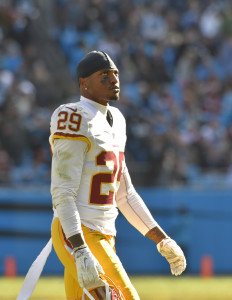 There aren’t many details available about the one-year pact as of yet, but Ian Rapoport of NFL.com did note that the deal can be worth “up to $5MM.” That type of phrasing can mean many different things, and we’ll need to know the complete specifics before fully analyzing the deal, but it likely doesn’t offer much in the way of guarantees.
There aren’t many details available about the one-year pact as of yet, but Ian Rapoport of NFL.com did note that the deal can be worth “up to $5MM.” That type of phrasing can mean many different things, and we’ll need to know the complete specifics before fully analyzing the deal, but it likely doesn’t offer much in the way of guarantees.
Aside from a few veteran linebackers who will likely earn playing time via special teams (Spencer Paysinger, Danny Lansanah), the Dolphins’ only other notable signing was that of safety Isa Abdul-Quddus, whom they lured away from the Lions with a three-year deal. Abdul-Quddus was excellent after wresting away a starting job from James Ihedigbo last year, posting 40 tackles and ranking as the No. 21 safety in his eight starts, according to PFF. However, IAQ has only posted a half-season’s worth of production during his five-year career, so there’s definitely some risk in this contract, but that uncertainty is somewhat negated by the modest financials.
Continue reading about the Dolphins’ offseason…
Read more
Notable losses:
- Quinton Coples, DE: Released
- Louis Delmas, S
- Jason Fox, T: Waived
- Brent Grimes, CB: Released
- Greg Jennings, WR: Released then retired
- Rishard Matthews, WR
- Brice McCain, CB: Released
- Lamar Miller, RB
- Damontre Moore, DE: Waived
- Derrick Shelby, DE
- Kelvin Sheppard, LB
- Olivier Vernon, DE: Rescinded transition tag
The Dolphins lost several interesting players this offseason, but none was more impactful than defensive end Olivier Vernon, who signed a massive deal (five years, $85MM, $40MM guaranteed) after Miami rescinded his transition tag. The argument can be made 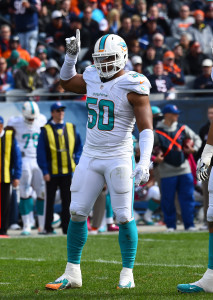 that the Dolphins made a mistake by not assigning Vernon the franchise tag — which would have been worth about $15.7MM — from the start. Mario Williams, Andre Branch, and Jason Jones account for roughly $10.7MM on Miami’s 2016 cap, so for $5MM more, the club could have retained one of the league’s elite edge defenders instead of signing three mid-range options.
that the Dolphins made a mistake by not assigning Vernon the franchise tag — which would have been worth about $15.7MM — from the start. Mario Williams, Andre Branch, and Jason Jones account for roughly $10.7MM on Miami’s 2016 cap, so for $5MM more, the club could have retained one of the league’s elite edge defenders instead of signing three mid-range options.
But rationalizing the Dolphins’ choice with Vernon is also possible, although it requires one to view the team’s front office in a different light. Miami has traditionally employed a “stars-and-scrubs” approach to roster-building, but allowing Vernon to walk in free agency and instead sign multiple defensive ends is the antithesis of that philosophy. Once the Dolphins placed the transition tag on Vernon, and subsequently realized a number of clubs were willing to pay him far more that they were, Miami had no choice but to revoke the tag, as doing so enabled them to recoup a 2017 compensatory pick. The ideal solution, though, was probably to franchise Vernon, and either live with him on a one-year deal, or see what the trade market had to offer.
Vernon wasn’t the only pass-rusher the Dolphins saw go elsewhere this offseason, as Derrick Shelby left South Beach after a four-year run. Shelby is only 27 years old and graded as the league’s No. 21 edge defender last season (per PFF), but it’s hard to discount that he’s registered only nine sacks over his entire career. Sacks aren’t everything, as pressures, hits, and hurries also affect a quarterback’s rhythm, and Shelby is a good run defender, too. But the Falcons were willing to hand him $18MM over four years, including $7.5MM in guarantees, a price that the Dolphins (rightly) weren’t willing to match.
Aside from Miami’s two defensive line defections, the club’s most notable loss was running back Lamar Miller, who left for Houston after the Dolphins never seriously entertained re-signing him. Miami (especially its prior coaching staff) never seemed to fully  trust Miller, as his high-water mark for carries was only 217. Miller is a productive running back who’s averaged 4.6 yards per carry over the duration of his career, and he actually got better when he received more carries, rushing for 5.1 yards per carry when he got those 217 attempts in 2014. Still, choosing not to hand veteran running backs multi-year contracts is a strategy that will never hear any argument from me.
trust Miller, as his high-water mark for carries was only 217. Miller is a productive running back who’s averaged 4.6 yards per carry over the duration of his career, and he actually got better when he received more carries, rushing for 5.1 yards per carry when he got those 217 attempts in 2014. Still, choosing not to hand veteran running backs multi-year contracts is a strategy that will never hear any argument from me.
Elsewhere among the skill positions, wide receivers Rishard Matthews (free agency) and Greg Jennings (release/retirement) won’t be members of the 2016 Dolphins. Jennings failed to put up any sort of numbers during his one-year stint with Miami, so we won’t waste much time on him. Matthews, however, posted the best season of his career in 2015, catching 43 passes for 662 yards (15.4 yards/reception) while scoring four times. The 26-year-old signed a reasonable $5MM per year deal with the Titans, but the Dolphins never had any intention of going that high to retain him.
Jumping back to the defensive side of the ball, Miami cut bait with cornerback Brent Grimes (and his wife, Miko) after the pair spent three seasons with the club. Numerous reasons could have contributed to Grimes’ release, including the fact that he’s now 33 and is  getting beat in coverage more often, but Miko’s controversial comments on social media reportedly played a role in the Dolphins asking Grimes to accept a pay cut (which he refused). A number of teams refused to entertain the idea of signing Grimes thanks to Miko’s antics, but he eventually landed $7MM guaranteed from the Buccaneers. Miko (shockingly) has since attacked Miami’s front office and ownership with ethnic slurs.
getting beat in coverage more often, but Miko’s controversial comments on social media reportedly played a role in the Dolphins asking Grimes to accept a pay cut (which he refused). A number of teams refused to entertain the idea of signing Grimes thanks to Miko’s antics, but he eventually landed $7MM guaranteed from the Buccaneers. Miko (shockingly) has since attacked Miami’s front office and ownership with ethnic slurs.
Grimes is the more high-profile player, but fellow corner Brice McCain might be the more important loss. McCain was forced to play outside corner last year, and predictably struggled, given that he’s much more suited for the slot. As Armando Salguero of the Miami Herald has argued, McCain would likely be an improvement over Bobby McCain (no relation), who is currently projected to start inside for the Dolphins, and Brice wasn’t very expensive, as he secured only $1MM guaranteed from Tennessee. Fellow defensive back Louis Delmas is also gone, but he didn’t play a snap in 2015 after suffering yet another knee injury during the preseason.
Two more veterans — linebacker Kelvin Sheppard and offensive tackle Jason Fox — won’t be back with the Dolphins after each played more snaps than they should have in 2015. Sheppard is now a Giant after playing on more than 60% of Miami’s defensive plays last season, but he’s not a lock to make the final New York roster and won’t be missed in South Beach. Fox, meanwhile, was forced to play more than 80% of the Dolphins’ snaps thanks to injuries along the front five, but graded as one of the six worst tackles in the league, according to PFF.
Trades:
- Acquired CB Byron Maxwell, LB Kiko Alonso, and a 2016 first-round pick (No. 13) from the Eagles in exchange for a 2016 first-round pick (No. 8).
- Acquired a 2016 second-round pick (No. 38) from the Ravens in exchange for a 2016 second-round pick (No. 42) and a 2016 fourth-round pick (No. 107).
- Acquired a 2016 third-round pick (No. 86) from the Vikings in exchange for a 2016 sixth-round pick (No. 186), a 2017 third-round pick, and a 2017 fourth-round pick.
- 2017 fourth-rounder acquired by Vikings will be a compensatory pick if Dolphins receive one.
- Acquired two sixth-round picks (Nos. 196 and 204) and a 2016 seventh-round pick (No. 250) from the Patriots in exchange for a 2016 fifth-round pick (No. 147).
- Acquired a 2016 sixth-round pick (No. 186) from the Vikings in exchange for a 2016 sixth-round pick (No. 196) and a 2016 seventh-round pick (No. 227).
- Acquired a 2016 seventh-round pick (No. 223) from the Browns in exchange for CB Jamar Taylor and a 2016 seventh-round pick (No. 250).
Miami and personnel chief Mike Tannenbaum clearly don’t hold draft capital in the same high regard that many other clubs around the league do, as the Dolphins consistently sacrificed future value for the present, trading away multiple picks to move up and acquire single selections. It’s a curious way to build a roster, and as Chase Stuart of Football Perspective wrote, it’s a strategy that is “emblematic of an organization that puts little emphasis on depth relative to star power.”
Take Miami’s Day 2 trade with the Vikings, for example. According to Stuart’s value chart, the Dolphins paid something close to 176 cents on the dollar (!) to trade up and draft draft Leonte Carroo. Minnesota, as Stuart detailed, essentially picked up a free fourth- and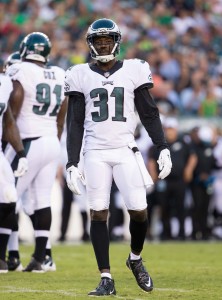 sixth-round pick by simply waiting until next year to make their choices. Miami either doesn’t understand this concept, or fails to recognize the extremely heavy discount that it is placing on future draft picks.
sixth-round pick by simply waiting until next year to make their choices. Miami either doesn’t understand this concept, or fails to recognize the extremely heavy discount that it is placing on future draft picks.
Tannenbaum & Co. also took a bath when trading for veterans, as they traded away the equivalent of a early fifth-round pick to acquire Byron Maxwell, his hefty contract, and Kiko Alonso. Miami may still have some hope that Maxwell can turn into a playable No. 1 cornerback, and Alonso will be cheap in 2016 as he plays out his rookie contract.
But Maxwell’s massive contract is an entity unto itself, and even though the rest of Maxwell’s prorated bonus accelerated onto the Eagles’ cap and the Dolphins were able to restructure Maxwell’s deal, the trade still makes little sense. Miami will pay Maxwell a guaranteed $8.5MM this season and is on the hook for $3MM guaranteed in 2017, so the fact that Philadelphia was able to both dump that contract plus acquire extra draft capital is rather astonishing.
Draft picks:
Even if he never succeeds in the NFL, Laremy Tunsil will likely be remembered for the foreseeable future given the drama that surrounded him on draft night. As most surely recall, Tunsil — who was thought to be the favorite to be selected with the first overall pick before the Titans traded down — was considered a 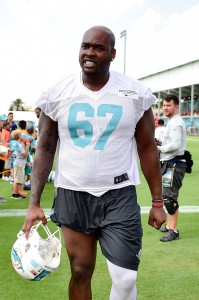 lock to be chosen in the top-six, but a free fall began a video surfaced showing Tunsil smoking out of a bong. Clubs at the top of the draft, most notably the Ravens, weren’t able to gather on the information quickly enough (and also may have had injury concerns about the Ole Miss tackle), leading Tunsil to tumble down that board until Miami snatched him up at No. 13.
lock to be chosen in the top-six, but a free fall began a video surfaced showing Tunsil smoking out of a bong. Clubs at the top of the draft, most notably the Ravens, weren’t able to gather on the information quickly enough (and also may have had injury concerns about the Ole Miss tackle), leading Tunsil to tumble down that board until Miami snatched him up at No. 13.
And though Tunsil is considered one of the premier left tackle prospects to enter the league in some time, he’ll begin his career at guard thanks to the presence of Branden Albert on the blindside. Albert, however, is entering his age-32 season, and has missed time in each of the last four seasons, meaning Tunsil is quite likely to see action at left tackle this season. Offensive line expert Lance Zierlien of NFL.com compared Tunsil to Cowboys tackle Tyron Smith during the pre-draft process, and if Tunsil even comes close to matching Smith’s production, the Dolphins will have made the right choice.
Miami was also counting on Xavien Howard to start early in his career, as the club has little depth behind Byron Maxwell in the secondary. The former Baylor Bear looked like the favorite to land the Dolphins’ No. 2 corner job, but after suffering a knee injury during minicamp, Howard underwent surgery and is now on the active/PUP list. Rookie defensive backs nearly always face a steep learning curve, and Howard will now encounter an even more difficult challenge given that he will miss a portion of training camp.
Skill position players Kenyan Drake and Leonte Carroo, meanwhile, don’t figure to play large roles during their rookie years given that they’re each pretty far down the depth chart. Drake could be listed as low as fourth among Miami’s running backs, and it would take a number of injuries for him to see playing time (but given that Arian Foster and Jay Ajayi are the team’s top two backs, health concerns are certainly on the table). Carroo, meanwhile, has a clearer path to snaps, but he’s behind Kenny Stills for the moment.
Extensions and Restructures:
Cameron Wake was already set to make roughly $8.3MM for the 2016 season, so while the Dolphins could have asked him to accept a pay cut (especially given that’s coming off injury), the club instead lowered Wake’s cap hit for the upcoming campaign while adding $3MM in guarantees for 2017. As Jason Fitzgerald of Over the Cap wrote in his analysis of the deal, Miami is clearly projecting Wake for a solid season, and if the veteran defensive end does return to his old form, then the team has indeed scored a below-market deal. And 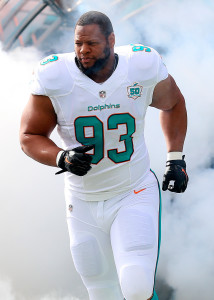 the risk is negligible, because if Wake does fall off a cliff, the Dolphins will have paid him only ~$1.7MM more than was originally scheduled.
the risk is negligible, because if Wake does fall off a cliff, the Dolphins will have paid him only ~$1.7MM more than was originally scheduled.
While Wake’s new deal can be rationalized, the same cannot be said for the restructuring of Ndamukong Suh‘s pact. Already one of the most onerous contracts in NFL history, Suh’s deal now contains an extra $4MM in prorated bonus money in each of the next five years, which gives the star defensive tackle enviable protection against being released. Realistically, Miami now cannot move on from Suh until after the 2019 campaign.
That timeline will be acceptable if Suh continues his current level of production (though he’s still making considerably more than any other defensive tackle), but if Suh experiences a dropoff, the Dolphins will be in an undesirable situation. Additionally, there wasn’t a pressing need for Miami to restructure this deal — though they were tight on cap space, the club made other moves (releasing Brent Grimes and Greg Jennings, forcing Jordan Cameron and Koa Misi to accept pay cuts) that created fiscal room. The Fins have essentially locked themselves into a half-decade of a highly-paid Suh when they weren’t required to do so.
Other:
New general manager Chris Grier will have a voice in Miami’s front office, but Mike Tannenbaum clearly still runs the show and maintains final say on personnel decisions. Changes to the coaching staff will likely have a larger impact on the upcoming season, as Adam Gase landed the Dolphins’ head coaching position after being considered for several openings during the 2015 offseason. Gase has been very successful during his NFL career, helping lead one of the most productive offenses in league history while with the Broncos, and turning around Jay Cutler‘s career with the Bears.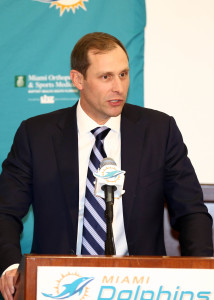
Gase will call the offensive plays in South Beach, meaning new OC Clyde Christensen will maintain more of a planning role, and serve as a sounding board for quarterback Ryan Tannehill. Christensen’s last two pupils were Peyton Manning and Andrew Luck, so he should have a shot at bringing the best of Tannehill to the forefront. On defense, former Bengals defensive backs coach Vance Joseph secured the coordinator role after having been Denver’s first choice for the same job during the 2015 offseason. He’ll try to rescue a unit that ranked just 25th in Football Outsiders’ DVOA last year.
One possible member of Joseph’s unit is former third overall pick Dion Jordan, who earned his conditional reinstatement from the NFL and has since been cleared to practice after presumably meeting the league’s requirement of counseling. However, Jordan is recovering from offseason knee surgery and apparently hasn’t looked great during practice sessions, so he’s no lock to make the squad, especially given that the Dolphins added a good deal of help to their defensive line over the past several months.
Top 10 cap hits for 2016:
- Ndamukong Suh, DT: $12,600,000
- Ryan Tannehill, QB: $11,640,000
- Branden Albert, T: $10,150,000
- Mike Pouncey, C: $10,025,000
- Cameron Wake, DE: $8,525,000
- Byron Maxwell, CB: $8,500,000
- Reshad Jones, S: $8,202,942
- Jordan Cameron, TE: $8,000,000
- Mario Williams, DE: $6,500,000
- Koa Misi, LB: $3,603,000
New head coach Adam Gase has drawn rave reviews at every stop during his career, and the laudation hasn’t ceased now that he’s made his way to Miami. Gase is seen as the savior who can rectify Ryan Tannehill‘s career, and while he may able to turn around the franchise quarterback (with the help of an improved offensive line), the Dolphins’ defense needs to take just as big a leap forward if the club has any serious hopes of contention in 2016.
Information from Over the Cap, Spotrac, and Roster Resource was used in the creation of this post. Photos courtesy of USA Today Sports Images.
By Ben Levine |
at August 6, 2016 9:30 am
It was a typical offseason for the Patriots. A looming suspension/punishment for the organization or star player. The defection of a star defender. The acquisition of notable veterans and high-upside players. A flurry of draft-night trades. In other words, it wasn’t a normal offseason by any other standard.
While the fanbase was primarily focused on the looming suspension of Tom Brady, the Patriots front office did an admirable job of retooling many spots on their roster. With several impending defensive free agents, the Patriots dealt off Chandler Jones, replacing him with players like Chris Long and Shea McClellin. The team lost Brandon LaFell to free agency, but they added a younger piece in wideout Chris Hogan (as well as talented tight end Martellus Bennett). They even drafted a quarterback!
The whole Deflategate fallout seemed to dominate offseason talk, so many of the Patriots moves went under the radar. However, per usual, the team added enough depth to offset any of their notable subtractions. As a result, the Patriots should once again be in the driver’s seat for the AFC title.
Notable signings:
- Chris Hogan, WR: Three years, $12MM. $7.5MM guaranteed. Bills declined to match RFA offer sheet.
- Shea McClellin, LB: Three years, $8.95MM. $3.5MM guaranteed.
- Chris Long, DE: One year, $2.375MM. $1MM guaranteed.
- Nate Ebner, S: Two years, $2.4MM. $500K guaranteed.
- Clay Harbor, TE: Two years, $3MM. $400K guaranteed. $500K available annually via incentives.
- Donald Brown, RB: One year, minimum salary benefit. $300K guaranteed.
- LaAdrian Waddle, T: Two years, $2.35MM. $250K guaratneed. $1.4MM available via incentives.
- Terrance Knighton, DT: One year, $2.05MM. $250K guaranteed. $2.5MM available via incentives.
- Markus Kuhn, DT: One year, $1.2MM. $140K guaranteed.
- LeGarrette Blount, RB: One year, $1MM. $100K guaranteed. $1MM available via incentives.
- Nate Washington, WR: One year, minimum salary benefit. $60K guaranteed.
- James Develin, FB: One year, $750K. $50K guaranteed.
- Frank Kearse, DE: One year, minimum salary benefit. $30K guaranteed.
- E.J. Biggers, CB: One year, minimum salary benefit. $25K guaranteed.
- Ramon Humber, LB: One year, minimum salary benefit. $25K guaranteed.
- Vinnie Sunseri, S: Contract terms unknown.
While most of the Patriots offseason discussion focused on the quarterback and trades, the teams various signings seemed to fly under the radar. Still, the team managed to add several players via free agency who should contribute to this year’s squad.
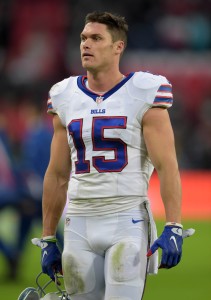 Considering the injury concerns for receivers Julian Edelman and Danny Amendola, the Patriots went hard after several free agent wideouts. After kicking the tires on Marvin Jones and Mohamed Sanu, the team ended up settling on former Bills receiver Chris Hogan – a player coach Bill Belichick had long coveted. The former Bills wideout has put up solid numbers over the past two seasons, compiling 77 catches, 876 yards, and six touchdowns during the span. As things currently stand, the 27-year-old would be the team’s third receiver, and the former Monmouth standout can also reportedly serve as an emergency punter.
Considering the injury concerns for receivers Julian Edelman and Danny Amendola, the Patriots went hard after several free agent wideouts. After kicking the tires on Marvin Jones and Mohamed Sanu, the team ended up settling on former Bills receiver Chris Hogan – a player coach Bill Belichick had long coveted. The former Bills wideout has put up solid numbers over the past two seasons, compiling 77 catches, 876 yards, and six touchdowns during the span. As things currently stand, the 27-year-old would be the team’s third receiver, and the former Monmouth standout can also reportedly serve as an emergency punter.
Hogan wasn’t the only weapon added to Brady’s arsenal. The team signed veteran receiver Nate Washington, who caught 47 passes for 658 yards with the Texans last season. While the 32-year-old has proven to be a durable, consistent option, there’s no certainty that he’ll ultimately make the team.
Elsewhere on offense, the Patriots signed tight end Clay Harbor. The 29-year-old showed that he could be a competent piece of the passing game throughout his tenure with the Jaguars, although he settled into more of a blocking role in 2015. The Patriots value versatility, and Harbor’s ability to play both tight end and fullback will likely earn him a spot on the roster. Speaking of the fullback position, the team brought back incumbent James Develin, who missed all of last season while recovering from a broken tibia. The 28-year-old appeared in all 32 games for the Patriots between 2013 and 2014, including 10 starts.
With a number of intriguing veteran options on the running back market, there was a general assumption that the Patriots would look to add some reinforcement to their backfield. After all, the team finished 30th in rushing yards last season, and the team ultimately had to rely on 32-year-old Steven Jackson during the postseason. Furthermore, considering Brady’s impending suspension, the Patriots wouldn’t be able to lean on the passing game through the first month of the season.
Click here to continue reading about the Patriots..
Read more
As the end of the day, the team did little to improve the run game. The Patriots brought back 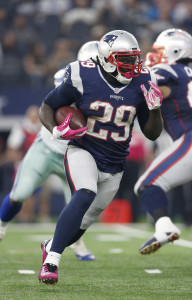 LeGarrette Blount, who spent parts of the past three seasons in New England. After having average 4.9 yards per attempt through his first 21 games with the Patriots, the 29-year-old saw those numbers dip to 4.3 yards per attempt last season. The team also brought in veteran running back Donald Brown, who spent the past two seasons with the Chargers. The former first-rounder had averaged 5.3 yards per carry during his final season with the Colts, but those numbers dropped to 3.1 yards per carry over the past two years. Fortunately, the team could also look forward to the return of Dion Lewis, whose breakout season ended with a torn ACL. Through seven games, the 25-year-old compiled 234 yards on 49 attempts (as well as an impressive 388 yards on 36 catches).
LeGarrette Blount, who spent parts of the past three seasons in New England. After having average 4.9 yards per attempt through his first 21 games with the Patriots, the 29-year-old saw those numbers dip to 4.3 yards per attempt last season. The team also brought in veteran running back Donald Brown, who spent the past two seasons with the Chargers. The former first-rounder had averaged 5.3 yards per carry during his final season with the Colts, but those numbers dropped to 3.1 yards per carry over the past two years. Fortunately, the team could also look forward to the return of Dion Lewis, whose breakout season ended with a torn ACL. Through seven games, the 25-year-old compiled 234 yards on 49 attempts (as well as an impressive 388 yards on 36 catches).
LaAdrian Waddle could be blocking for the duo in 2016, although there’s no certainty that the 25-year-old will make the roster. The former undrafted free agent was added by the Patriots last December following two-plus seasons with the Lions. As PFR’s Zach Links noted, Waddle was rated as Pro Football Focus’ worst qualified offensive tackle in the league, and the lineman hasn’t been capable of staying healthy throughout his career.
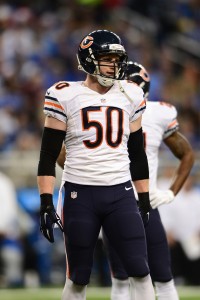 On the other side of the ball, the Patriots did an admirable job of adding solid veterans on affordable deals. The most notable addition was linebacker Shea McClellin, who spent his entire four-year career in Chicago. The former first-round pick has averaged 13 games a season throughout his career, and after having his fifth-year option declined, he finished 2015 with a career-high in tackles (81). The 27-year-old’s ability to play both linebacker and defensive end will certainly earn him a significant role on the team.
On the other side of the ball, the Patriots did an admirable job of adding solid veterans on affordable deals. The most notable addition was linebacker Shea McClellin, who spent his entire four-year career in Chicago. The former first-round pick has averaged 13 games a season throughout his career, and after having his fifth-year option declined, he finished 2015 with a career-high in tackles (81). The 27-year-old’s ability to play both linebacker and defensive end will certainly earn him a significant role on the team.
The Patriots continued their offseason theme of adding former first-round picks by signing former second-overall pick Chris Long to a one-year deal. The 31-year-old hasn’t been particularly healthy over the past two seasons, playing in a total of 18 games. Still, the defensive end was a force from 2010 through 2013, and playing behind both Rob Ninkovich and Jabaal Sheard should preserve the veteran throughout the campaign.
Elsewhere on the defensive line, the Patriots seemingly added a starting defensive tackle in veteran Terrance Knighton. ‘Pot Roast’ is still going strong after seven seasons in the league, and the 30-year-old has only missed an incredible four games throughout his career. After two seasons with the Broncos, Knighton spent 2015 with the Redskins, where he compiled 29 tackles and 1.5 sacks in 15 games. The team did select Malcom Brown in the first-round of the 2015 draft, but the departures of Akiem Hicks and Sealver Siliga meant the team needed some depth at the position.
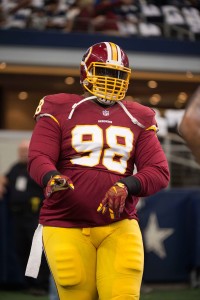 To round out the defensive line, the Patriots also added defensive tackle Markus Kuhn. The four-year veteran spent his entire career with the Giants, where he compiled 39 tackles and 1.5 sacks over 24 games between the past two seasons. The Patriots also signed defensive end Frank Kearse, who followed a promising 2014 campaign (15 tackles, three sacks) with a disappointing 2015 season.
To round out the defensive line, the Patriots also added defensive tackle Markus Kuhn. The four-year veteran spent his entire career with the Giants, where he compiled 39 tackles and 1.5 sacks over 24 games between the past two seasons. The Patriots also signed defensive end Frank Kearse, who followed a promising 2014 campaign (15 tackles, three sacks) with a disappointing 2015 season.
The Patriots brought back safety Nate Ebner on a two-year deal. While the Olympic rugby player probably won’t get much play in the defensive backfield, he’ll surely play a role on special teams. As our own Sam Robinson noted, Ebner finished last season with 11 special teams tackles, the third-best total on the team.
Meanwhile, free agent addition E.J. Biggers could establish a role at cornerback for the Patriots. The former seventh-round pick surely won’t unseat starters Malcolm Butler and Logan Ryan, but he’ll be competing with a collection of players for that third or fourth corner spot. The Patriots also added an intriguing prospect in safety Vinnie Sunseri, although the 22-year-old will certainly have an uphill battle to make the roster. The same goes for linebacker Ramon Humber, although the former Saint could easily carve out a role on the squad. The former North Dakota State standout established himself as a formidable special teams force during his time in New Orleans, and the team’s muddled linebacker depth means the 28-year-old could also contribute on defense.
Notable losses:
- Josh Boyce, WR
- Tarell Brown, CB
- Scott Chandler, TE: Released
- Dominique Easley, DT: Waived
- Darius Fleming, LB: Waived
- Dane Fletcher, LB: Retired
- Brandon Gibson, WR
- Akiem Hicks, DL
- Joey Iosefa, RB: Waived
- Steven Jackson, RB
- Leonard Johnson, CB: Released
- Chris Jones, DT: Waived
- Ishmaa’ily Kitchen, DL: Released
- Brandon LaFell, WR: Released
- Eric Martin, LB: Waived
- Jerod Mayo, LB: Retired
- Rashaan Melvin, CB: Released
- Sealver Siliga, DT
- Brian Tyms, WR
- Dekoda Watson, LB
- Ryan Wendell, C
- Tavon Wilson, S
It’d be a stretch to say that any of the departed Patriots free agents played a major role for the 2015 squad, but there were several players who will certainly be missed.
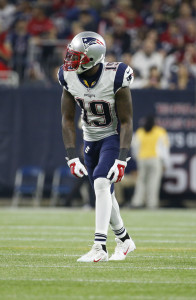 From an actual snap-count standpoint, receiver Brandon LaFell is the team’s most significant loss. Following a 2014 campaign where he set career-highs in receptions (74), yards (953) and touchdowns (seven), the veteran wideout struggled through injuries and inconsistencies in 2015. LaFell finished the campaign with 37 receptions, 515 yards, and no touchdowns, numbers that rival his career-lows.
From an actual snap-count standpoint, receiver Brandon LaFell is the team’s most significant loss. Following a 2014 campaign where he set career-highs in receptions (74), yards (953) and touchdowns (seven), the veteran wideout struggled through injuries and inconsistencies in 2015. LaFell finished the campaign with 37 receptions, 515 yards, and no touchdowns, numbers that rival his career-lows.
Besides LaFell, the team lost another trio of wideouts, although none of the three saw the field for the Patriots in 2015. Former Rams receiver Brandon Gibson was a buy-low grab by the Patriots following two underwhelming seasons in Miami, but he was placed on the injured reserve prior to the season. Former fourth-rounder Josh Boyce never established himself through his three seasons in New England, compiling only nine receptions for 121 yards. Brian Tyms had several big games for the Pats in 2014, but an achilles injury kept him off the field last season.
The loss of veteran linebacker Jerod Mayo will likely have more of an impact on the locker room than the actual field. After being drafted 10th overall, the University of Tennessee product 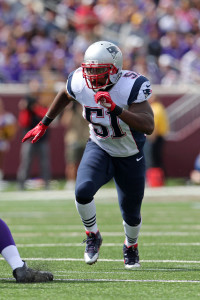 instantly established himself as a presence in the middle of the Patriots defense. From 2008 through 2012, Mayo only missed three regular season games, and he earned a pair of Pro Bowl appearances and a first-team All-Pro selection during that span. After having played 12 combined games between 2013 and 2014, Mayo did see the field for all 16 contests in 2015. However, the veteran started only eight games while barely playing 400 snaps, resulting in a career-low in tackles (47). A shoulder injury ultimately kept Mayo from playing in the AFC Championship game, and the 30-year-old announced his retirement less than a month later.
instantly established himself as a presence in the middle of the Patriots defense. From 2008 through 2012, Mayo only missed three regular season games, and he earned a pair of Pro Bowl appearances and a first-team All-Pro selection during that span. After having played 12 combined games between 2013 and 2014, Mayo did see the field for all 16 contests in 2015. However, the veteran started only eight games while barely playing 400 snaps, resulting in a career-low in tackles (47). A shoulder injury ultimately kept Mayo from playing in the AFC Championship game, and the 30-year-old announced his retirement less than a month later.
Tight end Scott Chandler was brought on board to provide another talented target to Brady’s arsenal, but the veteran wasn’t nearly as productive as he was in Buffalo. Between 2011 and 2014, Chandler averaged 45 receptions, 528 receiving yards, and four touchdowns a season. In 2015, he compiled only 23 receptions, 259 yards, and four scores. While the 31-year-old did contribute as a blocker and special teamer, the presence of other tight ends made the veteran expendable.
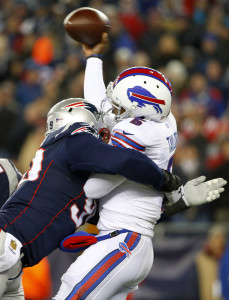 Perhaps the most surprising subtraction was defensive lineman. The 2014 first-round pick struggled with injuries throughout his Patriots tenure, although he did show brief flashes when he did see the field. Reports indicated that the move was attributed to Easley’s knees, as well as “off-field issues.” With plenty of talent on the defensive line, the front office clearly believed they were better off without the headache.
Perhaps the most surprising subtraction was defensive lineman. The 2014 first-round pick struggled with injuries throughout his Patriots tenure, although he did show brief flashes when he did see the field. Reports indicated that the move was attributed to Easley’s knees, as well as “off-field issues.” With plenty of talent on the defensive line, the front office clearly believed they were better off without the headache.
The Patriots lost another pair of defensive linemen in Akiem Hicks and Sealver Siliga. Hicks ultimately played in 13 games for the squad after being acquired from the Saints, totaling 21 tackles and three sacks. Siliga had spent the past three seasons in New England, compiling 5.5 sacks in 25 games. The duo combined for 636 snaps last season, but the free agent and rookie additions (as well as the increased roll for former first rounder Malcom Brown) should reduce the sting of the departures.
The Patriots will see a bit of a makeover in their secondary, as the team lost four defensive backs. The most notable subtraction was safety Tavon Wilson, who played in 54 games during his four seasons in New England. Following an impressive rookie campaign where he picked off four passes, Wilson struggled to hold a consistent role in the following seasons. The trio of Tarell Brown, Rahsaan Melvin, and Leonard Johnson ultimately proved to be nothing more than 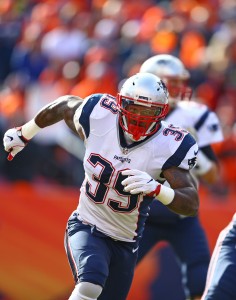 experiments in 2015, with none of the three playing more than 200 snaps.
experiments in 2015, with none of the three playing more than 200 snaps.
The team didn’t ask back running back Steven Jackson, who had four unwhelming games (including playoffs) with the Patriots last season. Meanwhile, veteran center Ryan Wendell started 44 games for the Patriots between 2012 and 2014, earning him a captain distinction prior to the 2015 campaign. However, injuries and the presence of Bryan Stork kept Wendell off the field, and the 30-year-old still hasn’t found a job for 2016. Considering his familiarity with the offense, the veteran could presumably return if the team is seeking additional offensive line help.
Trades:
- Acquired C/G Jonathan Cooper and a 2016 second-round pick (No. 61) from the Cardinals in exchange for LB Chandler Jones.
- Acquired TE Martellus Bennett and a 2016 sixth-round pick (No. 204) from the Bears in exchange for a 2016 fourth-round pick (No. 127).
- Acquired a 2016 third-round pick (No. 78) and a 2016 fourth-round pick (No. 112) from the Saints in exchange for a 2016 second-round pick (No. 61).
- Acquired a 2016 fifth-round pick (No. 147) from the Dolphins in exchange for two 2016 sixth-round picks (Nos. 196 and 204) and a 2016 seventh-round pick (No. 250).
- Acquired a 2016 seventh-round pick (No. 225) and a 2017 fourth-round pick from the Seahawks in exchange for a 2016 fifth-round pick (No. 147).
- Acquired a conditional 2017 seventh-round pick from the Lions in exchange for LB Jon Bostic.
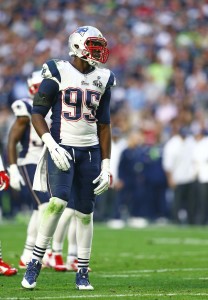 The team’s two biggest offseason moves undoubtedly came via trade. With several talented defenders becoming eligible for an extension, the Patriots had some interesting decisions to make regarding their impending payouts. The team somewhat solved their issues in mid-March, dealing defensive end Chandler Jones to the Cardinals. The 26-year-old started 52 games for the Patriots after being selected in the first round of the 2012 draft, averaging nine sacks a season. Jones had one of his best seasons in 2015, compiling 44 tackles and 12.5 sacks in 15 games. While the subtraction of a player of Jones caliber is never a positive, the Patriots are fortunate to have enough depth on the defensive line. Jabaal Sheard will presumably take Jones’ spot in the starting lineup, while 2015 draft picks Geneo Grissom and Trey Flowers could be the future at the position.
The team’s two biggest offseason moves undoubtedly came via trade. With several talented defenders becoming eligible for an extension, the Patriots had some interesting decisions to make regarding their impending payouts. The team somewhat solved their issues in mid-March, dealing defensive end Chandler Jones to the Cardinals. The 26-year-old started 52 games for the Patriots after being selected in the first round of the 2012 draft, averaging nine sacks a season. Jones had one of his best seasons in 2015, compiling 44 tackles and 12.5 sacks in 15 games. While the subtraction of a player of Jones caliber is never a positive, the Patriots are fortunate to have enough depth on the defensive line. Jabaal Sheard will presumably take Jones’ spot in the starting lineup, while 2015 draft picks Geneo Grissom and Trey Flowers could be the future at the position.
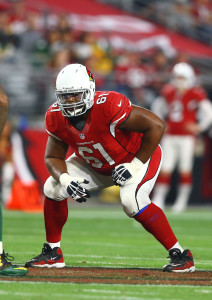 In return, the Patriots acquired offensive lineman Jonathan Cooper and a second-round pick. The guard was the seventh overall pick in 2013, but injures derailed much of his tenure in Arizona. Cooper missed his entire rookie season with a broken fibia, and he only appeared in 24 games (11 starts) over the past two seasons. The 26-year-old is currently slotted in as the team’s starting right guard, although it’s worth noting that the Patriots spent a pair of 2015 draft picks on offensive guards (Shaq Mason, Tre’ Jackson). The team predictably dealt off the second-rounder for additional draft picks, which we’ll get to in a moment.
In return, the Patriots acquired offensive lineman Jonathan Cooper and a second-round pick. The guard was the seventh overall pick in 2013, but injures derailed much of his tenure in Arizona. Cooper missed his entire rookie season with a broken fibia, and he only appeared in 24 games (11 starts) over the past two seasons. The 26-year-old is currently slotted in as the team’s starting right guard, although it’s worth noting that the Patriots spent a pair of 2015 draft picks on offensive guards (Shaq Mason, Tre’ Jackson). The team predictably dealt off the second-rounder for additional draft picks, which we’ll get to in a moment.
Only two days following the Jones trade, the Patriots acquired tight end Martellus Bennett from the Bears. While the Patriots’ previous tight end additions proved to be nothing less than insurance for Rob Gronkowski, Bennett should be able to carve out a significant role in the passing game. Although his 2015 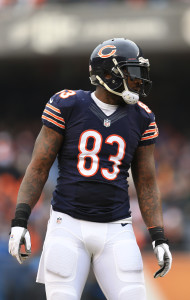 campaign was a bit underwhelming, the 29-year-old still averaged 69 receptions, 705 yards, and nearly five touchdowns a season during his three years in Chicago. Bennett (6-foot-6, 273 pounds) is similar to Gronk (6-foot-6, 265 pounds), so fans shouldn’t necessarily expect the second-coming of the Gronkowski/Aaron Hernandez duo. However, there’s no denying the tight end’s talent in the passing game, and it’s easy to envision Bennett being one of Brady’s five favorite targets (alongside Gronkowski, Edelman, Amendola, and Lewis).
campaign was a bit underwhelming, the 29-year-old still averaged 69 receptions, 705 yards, and nearly five touchdowns a season during his three years in Chicago. Bennett (6-foot-6, 273 pounds) is similar to Gronk (6-foot-6, 265 pounds), so fans shouldn’t necessarily expect the second-coming of the Gronkowski/Aaron Hernandez duo. However, there’s no denying the tight end’s talent in the passing game, and it’s easy to envision Bennett being one of Brady’s five favorite targets (alongside Gronkowski, Edelman, Amendola, and Lewis).
Otherwise, the Patriots made a number of moves to acquire picks during the draft. The team dealt off the second-round pick acquired from Arizona, and they acquired a pair of draft picks that ultimately turned into offensive lineman Joe Thuney and wideout Malcolm Mitchell. The Patriots also ended the draft having acquired a pair of 2017 draft picks.
Draft picks:
The Patriots forfeited their first round pick as a result of the Deflategate fiasco, but the team still managed to emerge with five rookies selected in the first four rounds.
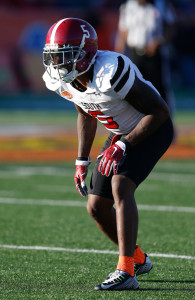 With their second-round pick, the Patriots selected Alabama defensive back Cyrus Jones. While the talented defender may not be tall enough to establish himself as a top corner, he’ll certainly be able to contribute in the slot. Jones also put up impressive return numbers during his three years in college, including a 23.4-yard kick return average and an 11.9-yard punt return average. While it may take the rookie sometime to carve out a roll on defense, Belichick could easily lean on Jones in the return game in an attempt to preserve Amendola and Edelman.
With their second-round pick, the Patriots selected Alabama defensive back Cyrus Jones. While the talented defender may not be tall enough to establish himself as a top corner, he’ll certainly be able to contribute in the slot. Jones also put up impressive return numbers during his three years in college, including a 23.4-yard kick return average and an 11.9-yard punt return average. While it may take the rookie sometime to carve out a roll on defense, Belichick could easily lean on Jones in the return game in an attempt to preserve Amendola and Edelman.
The Patriots have added several offensive guards over the past few seasons, leading some to question the selection of lineman Joe Thuney. However, the North Carolina State product has the ability to play both guard and tackle, and recent reports have indicated that the rookie is already taking hold of the starting left guard spot. Thuney’s presence could also allow the team to move on from lineman Marcus Cannon.
The Patriots continued to surprise with their next third-round pick, selecting Thuney’s college quarterback, Jacoby Brissett. The speedy signal-caller had two solid seasons in the ACC, completing around 60-percent of his passes and running for another 899 yards. The rookie will 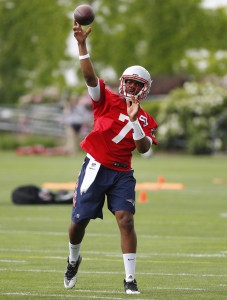 back up Jimmy Garoppolo through the first month of the season, although if the Patriots simply needed a third quarterback, they could have signed one of a number of available free agents. Rather, the selection may indicate that the Patriots are hoping to capitalize on a potential Garoppolo breakout. If the third-year quarterback plays well enough during Brady’s absence, the Patriots could deal the signal-caller while still having a talented prospect in their back pocket.
back up Jimmy Garoppolo through the first month of the season, although if the Patriots simply needed a third quarterback, they could have signed one of a number of available free agents. Rather, the selection may indicate that the Patriots are hoping to capitalize on a potential Garoppolo breakout. If the third-year quarterback plays well enough during Brady’s absence, the Patriots could deal the signal-caller while still having a talented prospect in their back pocket.
With defensive tackle Alan Branch under contract, it’s unlikely that third-round pick Vincent Valentine will be able to contribute in 2016. However, both Branch and Knighton are on the wrong side of 30, so the Nebraska product could have a future role on this squad. Fourth-rounder Malcolm Mitchell has some big-play potential, although the wideout competing with a number of players for the team’s fourth receiver slot.
Among the team’s later-round picks, linebacker Kamu Grugier-Hill has already shown flashes during camp. There’s no reason why the Eastern Illinois product couldn’t beat out Rufus Johnson, Jonathan Freeny, or Ramon Humber for the Patriots’ fourth linebacker slot. Depending on the health of the Patriots receivers, seventh-rounder Devin Lucien could even see some time on the field.
Extensions and Restructures:
Tom Brady has continually been willing to restructure his contract, allowing the Patriots to have more cap flexibility. The star quarterback signed another extension this offseason, with the contract lasting until Brady is 42-years-old. Brady has been a relative bargain for the Patriots in recent years, never accounting for more than a $15MM cap number.
The Patriots also extended safety Patrick Chung’s contract through 2018, raising the veteran’s 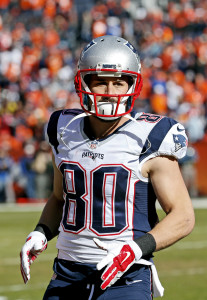 2016 salary in the process. Since returning to New England in 2014, Chung has started 29 of his 31 games, averaging 85 tackles and 8.5 passes defender during that span.
2016 salary in the process. Since returning to New England in 2014, Chung has started 29 of his 31 games, averaging 85 tackles and 8.5 passes defender during that span.
Perhaps the most notable contract restructuring was that of wideout Danny Amendola. There were questions regarding whether the 30-year-old and his $5MM salary would stick around for 2016. However, the wideout took a massive pay cut, reducing that number to $1.25MM. Despite several injuries, the receiver has established himself as one of Brady’s targets over the past few years. While the team presumably wouldn’t have missed a beat without Amendola, his veteran presence will certainly be appreciated (especially if Edelman misses considerable time).
Looking forward, the team has several notable players up for extensions, and it may not be easy for the squad to lock up the entire group long-term. Four starting defenders will actually be reaching free agency in 2017, including Jamie Collins, Dont’a Hightower, Malcolm Butler 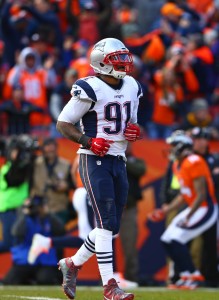 (restricted free agent), and Jabaal Sheard. The Chandler Jones trade provided a bit of clarity on the team’s overall thinking (mostly that Jones was towards the bottom of the Patriots’ list of long-term priorities). However, there’s still no evident pecking order when it comes to inking these players to extensions, although Collins’ youth and production would likely put him in line for the largest payday. Per usual, Belichick and the front office will likely be exploring which of the four players would be willing to stay in New England on team-friendly deals.
(restricted free agent), and Jabaal Sheard. The Chandler Jones trade provided a bit of clarity on the team’s overall thinking (mostly that Jones was towards the bottom of the Patriots’ list of long-term priorities). However, there’s still no evident pecking order when it comes to inking these players to extensions, although Collins’ youth and production would likely put him in line for the largest payday. Per usual, Belichick and the front office will likely be exploring which of the four players would be willing to stay in New England on team-friendly deals.
It’s also worth noting that the Patriots are working with Gronkowski on an extension, despite the tight end having four years left on his contract. The 27-year-old’s base salary peaks at $9MM in 2019.
Other:
Despite the flurry of offseason moves, quarterback Tom Brady commanded the media’s  attention. Nearly 18 months after the infamous AFC Championship Game, Brady announced that he would drop the appeal of his four-game suspension stemming from the Deflategate fiasco. While the NFL Player’s Association could continue the appeals, the organization is operating under the assumption that Brady will miss the first four games of the upcoming season. Anticipation of a suspension may have prompted the team to draft quarterback Jacoby Brisset, with the rookie presumably backing up fill-in starter Jimmy Garropolo through the first month.
attention. Nearly 18 months after the infamous AFC Championship Game, Brady announced that he would drop the appeal of his four-game suspension stemming from the Deflategate fiasco. While the NFL Player’s Association could continue the appeals, the organization is operating under the assumption that Brady will miss the first four games of the upcoming season. Anticipation of a suspension may have prompted the team to draft quarterback Jacoby Brisset, with the rookie presumably backing up fill-in starter Jimmy Garropolo through the first month.
While the Brady suspension will presumably have a negative impact on the squad, the return of offensive line coach Dante Scarnecchia should have more than a positive impact. The long-time coach retired following the 2013 season after 32 years in the league, including 30 in New England. Dave DeGuglielmo replaced the coach on the sidelines for the past two seasons, and despite modest rushing and sack numbers, the unit was continually outclassed by talented defensive lines (as seen in this year’s AFC Championship Game against the Broncos).
News of Michael Williams torn ACL certainly wasn’t encouraging, but the team should more than make up for his absence with Bennett and Harbor. Meanwhile, the team’s decision to not pick up guard Jonathan Cooper’s contract was not much a surprise, as the team will likely let the former first-rounder prove himself during his first season in New England.
Finally, none of the team’s undrafted free agents figure to play much of a role at the start of the season, although the Patriots seemingly find a diamond in the rough every few years. Considering the uncertainty at the pair of positions, if two players had an opportunity to emerge, it could be running back D.J. Foster (Arizona State) and cornerback Jonathan Jones (Auburn).
Top 10 cap hits for 2016:
- Tom Brady, QB: $14,000,000
- Nate Solder, T: $10,322,666
- Devin McCourty, S: $7,397,500
- Dont’a Hightower, LB: $7,751,000
- Jabaal Sheard, LB: $6,812,500
- Rob Gronkowski, TE: $6,618,750
- Chris Hogan, WR: $5,500,000
- Sebastian Vollmer, T: $5,208,334
- Martellus Bennett, TE: $5,185,000
- Marcus Cannon, OL: $4,754,168
The Patriots are rarely predictable when it comes to offseason moves. While the 2014 offseason saw the addition of several big names (led by Darrell Revis), the 2015 offseason was more about the team’s subtractions (including Revis, Brandon Browner, Vince Wilfork, and Shane Vereen).
The team’s 2016 offseason saw the best (and worst) of both worlds. While the loss of Chandler Jones will certainly sting, the team will certainly welcome additions like Long, McClellin, and Bennett. Of course, the team is also returning the majority of the core that made it to last year’s conference championship game. Since the team seemingly got stronger, we should only expect more of the same this upcoming season.
Contract information from Over the Cap, Spotrac, and Roster Resource was used in the creation of this post. Photos courtesy of USA Today Sports Images.
By Connor J. Byrne |
at August 4, 2016 5:27 pm
The 2015 Seahawks won the fewest regular-season games of the four-year Russell Wilson era (10) and were unable to extend their streak of consecutive Super Bowl appearances to three, but they still made the playoffs for the fourth straight time and were among the the final four NFC teams standing. They also racked up top-five finishes in total offense, defense and point differential, and ranked first in Football Outsiders’ regular-season DVOA metric. All things considered, then, general manager John Schneider didn’t need to do anything drastic during the offseason to keep the Seahawks’ window of contention open.
Notable signings:
- Jeremy Lane, CB: Four years, $23MM. $11MM guaranteed.
- Jermaine Kearse, WR: Three years, $13.5MM. $6.3MM guaranteed. $1.4MM available annually via incentives.
- Ahtyba Rubin, DT: Three years, $12MM. $5.5MM guaranteed.
- Jon Ryan, P: Four years, $10MM. $3.4MM guaranteed.
- J’Marcus Webb, OL: Two years, $5.75MM. $2.45MM guaranteed.
- Sealver Siliga, DT: One year, $1.05MM. $200K guaranteed.
- Mike Morgan, LB: One year, $1MM. $200K guaranteed.
- Bradley Sowell, T: One year, $1MM. $200K guaranteed.
- Christine Michael, RB: One year, $725K. $25K guaranteed.
- Patrick Lewis, C: One year, $1.671MM. Signed original-round RFA tender.
- Brandon Browner, CB: One year, $760K.
- Brandon Williams, TE: One year, $675K.
- Tavaris Barnes, DE: One year, $525K.
As has been typical in recent years, the Seahawks were stingy versus opposing quarterbacks last season, finishing first in the league in touchdown tosses allowed (14), second in aerial yardage surrendered, and third in both QB rating against (78.1) and Football Outsiders’ pass defense rankings. Seattle was especially strong down the stretch, which was thanks in part to the return of cornerback Jeremy Lane. After missing the first 10 games of the year because of a broken arm and torn ACL he sustained on an interception return in the Seahawks’ Super Bowl XLIX loss to the Patriots the previous February, Lane recorded the first two regular-season INTs of his career. Overall, Lane’s performance earned him a respectable 51st-place ranking out of 111 qualifying corners at Pro Football Focus.
Since the Seahawks selected him in the sixth round of the 2012 draft, Lane has missed 23 of 64 regular-season games and made just six starts, but the club saw enough positives when he played to bet on the 26-year-old going forward. Lane was the Seahawks’ largest expenditure in free agency, receiving a four-year, $23MM commitment and $11MM in guarantees, and figures to start opposite Richard Sherman on the outside this season. Given his experience as a nickelback, Lane is also likely to spend time inside defending the slot.
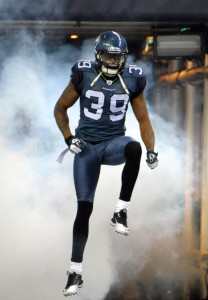
Helping Lane and the rest of the Seahawks’ defensive backs could be free agent pickup Brandon Browner, who thrived in Seattle from 2011-13 as a member of the Legion of Boom before spending the previous two seasons in New England and New Orleans. Last year was unexpectedly ugly for Browner, who rated as PFF’s worst qualifying corner (113th overall) and set the league’s single-season penalty record. That led the Saints to release Browner less than a year after signing him to a $15MM contract that was supposed to last through the 2017 campaign. The Seahawks then took an ultra-cheap flyer on Browner for $760K and will try to revitalize the 32-year-old, though he’ll play safety instead of corner. The Seahawks have arguably the preeminent safety tandem in the league in Earl Thomas and Kam Chancellor, but that won’t necessarily limit Browner’s impact. In fact, head coach Pete Carroll said in May that Browner will have a “really unique role.”
If Browner makes the Seahawks’ roster, they’ll deploy him in a run-stopping capacity on rushing downs and match him up against opposing tight ends in passing situations. Football Outsiders ranked the Seahawks’ pass defense a bottom-of-the-barrel 26th versus tight ends in 2015, so having the 6-foot-4, 220-pound Browner in the fold could serve the club well this year.
Continue reading about the Seahawks’ offseason…
Read more
Aside from Browner, the only notable outside veteran Seattle acquired via free agency is J’Marcus Webb, who’s slated to start at right tackle. The 335-pounder spent the first six years of his career in Chicago, Minnesota and Oakland, starting in 44 of 46 appearances at various O-line spots. In 2015 – his lone season with the Raiders – Webb saw time at guard and tackle, started each of their 16 games and took the field for all 1,056 of their offensive snaps. Despite the remarkable durability he showed last year, PFF wasn’t enamored of Webb’s performance, ranking him 48th among 77 qualifying tackles. Nevertheless, the Seahawks believe Webb is “physically perfect for” right tackle, per Carroll, and are confident their relatively modest investment in him (two years, $5.75MM and $2.45MM guaranteed) will pay dividends.
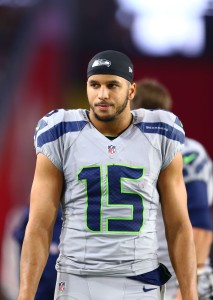
The Seahawks stayed within the organization for the remainder of their most sizable financial commitments, inking receiver Jermaine Kearse, defensive tackle Ahtyba Rubin and punter Jon Ryan to mid-range deals.
At $4.5MM per annum over three years, including $6.3MM guaranteed, Kearse ended up with the richest payday of the trio and will continue playing football in his native Evergreen State. Kearse – who spent his college career at the University of Washington and then signed with the Seahawks as an undrafted free agent in 2012 – has increased his production in each pro season, notching personal bests in catches (49), targets (68), yards (685) and touchdowns (five) in 2015. He parlayed that into a respectable contract and will continue acting as a solid complement to Doug Baldwin and Tyler Lockett.
The 30-year-old Rubin received a tad less than Kearse, and, thanks to the departure of Brandon Mebane, is now the oldest D-tackle on Seattle’s roster. PFF ranked Rubin’s output just 80th among 123 qualifying D-linemen last season, though it’s worth noting that the longtime Brown played mostly run snaps and the Seahawks’ defense surrendered the fewest rushing yards in the league. Seattle clearly believes Rubin had a major hand in its 2015 success against opposing rushers – the franchise otherwise wouldn’t have kept him around on a multiyear deal worth $1.5MM more annually than he raked in last season.
With Mebane gone and Ryan back, the punter is now the Seahawks’ longest-tenured player, having joined the organization in 2008. Ryan has been mediocre to below average in yards per punt, net average, touchbacks and punts inside the 20 in recent seasons, but that didn’t stop Seattle from paying the 34-year-old like one of the league’s 10 best players at his position. From a statistical standpoint, it’s fair to wonder if Seattle would’ve been better off going in a cheaper direction.
Notable losses:
- Alvin Bailey, OL
- Bryce Brown, RB
- Chase Coffman, TE
- Derrick Coleman, FB
- Demarcus Dobbs, DE
- A.J. Francis, DT
- Clint Gresham, LS: Released
- Bruce Irvin, LB
- Fred Jackson, RB
- Tarvaris Jackson, QB
- Lemuel Jeanpierre, C
- Ricardo Lockette, WR: Retired
- Marshawn Lynch, RB: Retired
- Anthony McCoy, TE
- Brandon Mebane, DT
- Nick Moody, LB
- Russell Okung, T
- J.R. Sweezy, G
- Will Tukuafu, FB
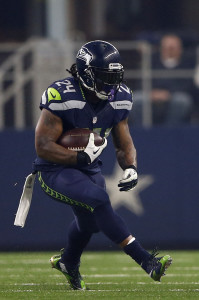
The Seahawks saw a handful of key contributors, including franchise icon Marshawn Lynch, depart over the winter. Lynch retired at 30, thus ending a memorable tenure in Seattle that began when the team stole him from Buffalo in 2010 for two late-round picks. Lynch made four Pro Bowls as a Seahawk and was the driving force behind their offense for most of his five-plus years there. In each of his four 16-game seasons as a Seahawk, Lynch finished with at least 280 carries, 1,200 yards and 11 rushing touchdowns. Lynch went out in less-than-sensational fashion last year, though, as injuries limited his effectiveness. All told, “Beast Mode” accrued career lows in games (seven), carries (111), ground yards (417) and per-rush average (3.8).
In hindsight, it’s possible Lynch’s anticlimactic swan song was a blessing in disguise for the Seahawks, who are now accustomed to life without him and may have found an excellent successor in Thomas Rawls. As a rookie last season, the undrafted free agent from Central Michigan burst on the scene with 830 rushing yards on a stellar 5.6 YPC average. While Rawls succumbed to a fractured ankle in December and is currently on the physically unable to perform list as he continues recovering from it, the Seahawks expect him back for Week 1. If he isn’t ready, Seattle has depth in the competent Christine Michael and three rookies – third-rounder C.J. Prosise, fifth-rounder Alex Collins, and seventh-rounder Zac Brooks – as Roster Resource shows.
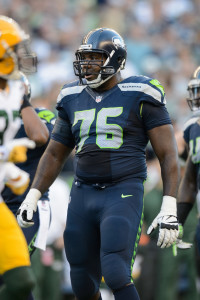
Left tackle Russell Okung and right guard J.R. Sweezy joined Lynch out the door, though their exits came via free agency.
Okung, whom the Seahawks drafted sixth overall in 2010, was always a quality piece for the club when on the field. Unfortunately, a lack of durability was consistently a problem for Okung, who failed to register a 16-game campaign in Seattle and sat out 24 of a possible 96 regular-season contests. Thanks to his injury troubles, Seattle is used to going without Okung, but that doesn’t mean life will be easier for the team now that he’s in Denver.
Technically, Webb is replacing Okung on the roster as a starting tackle, but it’s Garry Gilliam who will man the blind side. Gilliam, a 2014 undrafted free agent from Penn State whose NFL career began on the left side, started all of Seattle’s games on the right last year. PFF gave his 2015 performance a poor assessment, grading him 63rd out of 77 qualifying tackles (Okung was 31st). It seems like an especially tall order for Gilliam to replace Okung as Wilson’s most prominent protector, but the Seahawks are “really not” concerned about it, Carroll said in March.
Unlike Okung, Sweezy was durable during his run in Seattle, where he appeared in and started 46 games from 2013-15. Fifteen of those starts came at right guard last year for Sweezy, whom PFF ranked just 66th out of 81 qualifiers. The site was bearish on his work as both as a pass and run blocker, and the Seahawks let him head to Tampa Bay for a significant raise. Seattle now appears likely to plug in first-round pick Germain Ifedi as Sweezy’s replacement, but decorated free agent Jahri Evans is visiting the team Friday and could end up manning right guard if he signs.
Even with Okung and Sweezy in their lineup for the lion’s share of last season, the Seahawks’ offensive line still had major trouble with pass blocking for a good portion of the campaign. The unit yielded the sixth-most sacks in the league (46) and ranked 30th in Football Outsiders’ adjusted sack rate metric. Those numbers are somewhat deceiving overall, however, as the group fared well during the second half of the season. Amid their 6-2 post-bye week run, the Seahawks gave up a paltry 13 sacks. But it’s up in the air whether the unit will be able to continue at such a pace without Okung and Sweezy. If not, the mobile Wilson might find himself on the run even more often than usual.
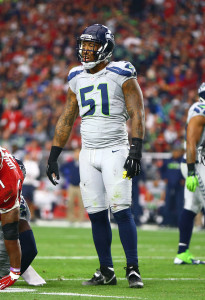
As was the case with their O-line, the front seven of the Seahawks’ defense also lost a pair of integral components. Linebacker Bruce Irvin, who recorded 22 sacks with the Seahawks from 2012-15, cashed in with the Raiders, while the aforementioned Mebane went to San Diego.
The bigger loss of the two is Irvin, who partook in 71.4 percent of the Seahawks’ defensive snaps last season and acquitted himself well on rushing downs and in coverage against the pass, all while adding an edge-rushing element (which second-year defensive end Frank Clark could help replace with a breakout season). Seattle doesn’t have an obvious strongside successor lined up for Irvin, with Mike Morgan, Eric Pinkins and Cassius Marsh competing for the No. 1 job in training camp. They could also deploy Browner there in a hybrid role, much like the NFC West rival Cardinals and Rams do with Deone Bucannon and Mark Barron, respectively. For at least the time being, nobody is going to confuse any of the Seahawks’ current options with Irvin, but they simply couldn’t afford to keep the 28-year-old.
Mebane, meanwhile, led Seahawks interior D-linemen in snaps last season (489) and teamed with Rubin to keep opposing running games at bay. PFF wasn’t particularly impressed with Mebane’s work, though, and Seattle let him go after he spent the first nine years of his career there. Rookie Jarran Reed, whom we’ll touch on later, is on track to take over for him alongside Rubin.
Trades:
- Acquired a 2016 first-round pick (No. 31) and a 2016 third-round pick (No. 94) from the Broncos in exchange for a 2016 first-round pick (No. 26).
- Acquired a 2016 second-round pick (No. 49) from the Bears in exchange for a 2016 second-round pick (No. 56) and a 2016 fourth-round pick (No. 124).
- Acquired a 2016 fifth-round pick (No. 147) from the Patriots in exchange for a 2016 seventh-round pick (No. 225) and a 2017 fourth-round pick.
Draft picks:
- 1-31: Germain Ifedi, T (Texas A&M)
- 2-49: Jarran Reed, DT (Alabama)
- 3-90: C.J. Prosise, RB (Notre Dame)
- 3-94: Nick Vannett, TE (Ohio State)
- 3-97: Rees Odhiambo, T (Boise State)
- 5-147: Quinton Jefferson, DT (Maryland)
- 5-171: Alex Collins, RB (Arkansas)
- 6-215: Joey Hunt, C (TCU)
- 7-243: Kenny Lawler, WR (California)
- 7-247: Zac Brooks, RB (Clemson)
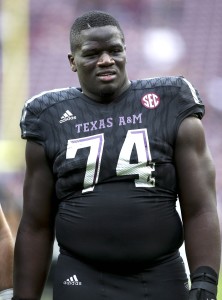
Before drafting the 324-pound Ifedi 31st overall, the Seahawks moved down five spots in a deal with Denver and secured an extra third-round pick (No. 94) in the process. That trade drew praise from FiveThirtyEight’s Chase Stuart, who lauded the Seahawks for receiving 132 cents on the dollar from the Broncos. As mentioned earlier, the athletic, long-armed Ifedi will probably step in at guard in place of Sweezy. If that happens, Ifedi and Webb will form a mammoth right side as they look to open up lanes for the Seahawks’ rushers and keep Wilson upright. However, Ifedi had consistency issues at Texas A&M, so offensive line coach Tom Cable will have his work cut out for him in developing the 22-year-old into a capable NFLer. Cable, for what it’s worth, has already expressed supreme confidence in Ifedi.
The Seahawks reversed course in the second round by moving up seven places and losing a fourth-rounder in a swap with the Bears, but as Stuart wrote, fourths aren’t as valuable to Super Bowl contenders as they are to lesser teams. Plus, Seattle landed Reed, whom many regarded as a potential first-rounder entering the draft. The Seahawks expect the former Alabama standout to ably take over for Mebane and provide them with a run-stuffing force.
After picking up Ifedi and Reed, Seattle made use of three third-round choices – the second of which came as a result of its trade with Denver. The Seahawks spent all three picks on offensive players, first nabbing Prosise, a former receiver who broke out as a runner last season with Notre Dame. The 6-0, 220-pound Prosise rushed for 1,029 yards on 157 attempts (6.6 YPC) and totaled 12 touchdowns in 2015. A speedster who can break tackles (he had an impressive 40 last season), Prosise could go down as a mid-round steal for the Seahawks and form an enviable one-two punch with Rawls.
Like Prosise, tight end Nick Vannett is also behind an injured player on Seattle’s depth chart. In Vannett’s case, it’s tight end Jimmy Graham. The three-time Pro Bowler underwhelmed season (48 catches and two touchdowns in 11 games) before suffering a torn patellar tendon in November. Graham is currently on the PUP list, but the Seahawks expect him back for the regular season. Considering the severity of his injury, it’s an open question how effective Graham will be from hereon, as VICE Sports’ Rivers McCown detailed last month. Thus, if the former Saint isn’t able to bounce back this season, it could open the door to playing time for Vannett. However, the 6-6, 257-pound Vannett won’t remind anyone of the athletic Graham. He’s instead primarily a sure-handed safety valve with excellent blocking skills, the latter of which could be useful to a Seahawks team with a questionable-looking offensive line. Combining Graham’s easy-to-escape contract with Luke Willson‘s status as a free agent-to-be, it seems Vannett is a year at most from seeing consistent NFL action.
Three picks after drafting Vannett, the Seahawks added ex-Boise State O-tackle Rees Odhiambo, who will play guard in Seattle because “he really fits the formula” for the position, Schneider told Stephen Cohen of seattlepi.com in April. Ifedi and the 314-pound Odhiambo were the two strongest O-linemen Cable worked with before the draft, according to Schneider. Unlike Ifedi, Odhiambo will not start immediately.
Extensions and Restructures:
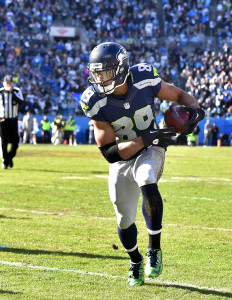
In late June (months after this year’s most expensive free agents came off the board), the Seahawks handed out their priciest contract of the offseason, inking Baldwin to a four-year, $46MM extension featuring $12MM in guarantees. The 27-year-old has been an enormous success story for the Seahawks, who signed him in 2011 as an undrafted free agent from Stanford, and will remain in Seattle as Wilson’s go-to target for the foreseeable future.
After combining for 130 receptions on 14.9 yards per catch and 12 touchdowns in 46 regular-season games during his first three years, Baldwin accumulated 144 grabs on 13.2 YPC and 17 scores in 32 straight appearances over the previous two campaigns. The 5-10, 189-pounder set career marks in 2015 in catches (78), yards (1,069) and TDs (14, which also tied for the league lead) for the playoff-bound Seahawks, with whom he has appeared in the postseason in four consecutive years. Baldwin’s 1,000-yard season last year was just the fourth by a slot receiver over the past half-decade. He’s also the only receiver since 1992 – when targets were first tracked – to amass 1,000-plus yards while hauling in at least 80 percent of the passes intended for him. As a result of his work last season, Baldwin finished in a second-place tie with A.J. Green in Football Outsiders’ wideout rankings.
Other:
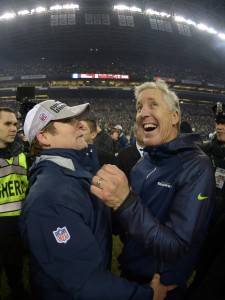
A few weeks after he awarded Baldwin an extension, Schneider received a new deal that’s set to keep him atop the Seahawks’ front office through 2021. The ex-Green Bay underling is now tied with the Ravens’ Ozzie Newsome as the highest-paid GM in the league ($3.75MM per year), which is a well-deserved honor. Since Schneider’s hiring in 2010, the Seahawks have collected five playoff trips, two Super Bowl appearances and a Super Bowl title. They couldn’t have done it without the players acquired under Schneider’s watch – namely Wilson, Lynch, Baldwin, Okung, Irvin, Bobby Wagner, K.J. Wright, Sherman, Thomas and Chancellor, among others.
Shortly after they locked up Schneider, the Seahawks extended one of the GM’s closest confidants, Carroll. The former national championship-winning coach at USC has transferred his excellence with the Trojans to Seattle, where he has helped the Seahawks to a 60-36 regular-season record and a terrific 8-4 playoff mark. Considering his reputation as a defensive backs guru, it’s fair to posit that Carroll’s an important reason for the dominance the Seahawks’ secondary has exhibited throughout his tenure with the club.
One player Carroll won’t coach this season is defensive end Chris Clemons, who retired last week after accepting a one-year offer from Schneider in April. Schneider actually picked up the 34-year-old twice – his first stint in Seattle lasted from 2010-13 after the GM acquired him and a fourth-rounder from Philadelphia for Darryl Tapp. Clemons went on to log 38 sacks during that four-year span, totaling at least 11 in each individual season from 2010-12. He was also a member of the Seahawks’ only Super Bowl-winning team, though they released him during the ensuing offseason. Clemons would’ve had to fight to make the Seahawks’ roster this summer, which the 12-year veteran obviously wasn’t up to.
Top 10 cap hits for 2016:
- Russell Wilson, QB: $18,542,000
- Richard Sherman, CB: $14,769,000
- Earl Thomas, S: $9,900,000
- Jimmy Graham, TE: $9,000,000
- Michael Bennett, DL: $7,000,000
- Cliff Avril, DL: $6,500,000
- Doug Baldwin, WR: $6,325,000
- K.J. Wright, LB: $6,250,000
- Kam Chancellor, S: $6,100,000
- Bobby Wagner, LB: $6,068,750
Despite having to wave goodbye to some high-end contributors during the offseason, Seattle still has a championship-level core and an elite coaching staff in place. On paper, then, the Seahawks once again look capable of breaking the double-digit-win barrier and making another playoff trip. First things first, they have a tall task ahead in trying to take back the NFC West crown from the Cardinals, who coasted to a division title last season.
Contract information from Over the Cap and Spotrac was used in the creation of this post. Photos courtesy of USA Today Sports Images.
By Dallas Robinson |
at August 2, 2016 9:01 pm
The 2015 Falcons started off hot under new head coach Dan Quinn, posting a 5-0 record and looking like a playoff contender as late as November. But a six-game losing streak exposed the club on both offense and defense, forcing Atlanta to make changes on both sides of the ball this offseason.
Notable signings:
- Alex Mack, C: Five years, $45MM. $20MM guaranteed.
- Mohamed Sanu, WR: Five years, $32.5MM. $14MM guaranteed. $1.5MM available via escalators.
- Derrick Shelby, DE: Four years, $18MM. $6MM guaranteed.
- Adrian Clayborn, DE: Two years, $8.5MM. $2.5MM guaranteed. $5.5MM available via incentives.
- Matt Schaub, QB: One year, $1.75MM. $500K guaranteed. $1MM available via incentives.
- Courtney Upshaw, LB: One year, $1.25MM. $390K guaranteed. $250K available via incentives.
- Chris Chester, G: One year, $2.35MM. $250K guaranteed.
- Sean Weatherspoon, LB: One year, $1.5MM. $150K guaranteed.
- Philip Wheeler, LB: One year, minimum salary benefit. $80K guaranteed.
- Bryce Harris, T: One year, minimum salary benefit. $60K guaranteed.
- Tom Compton, T: One year, minimum salary benefit. $25K guaranteed.
- Ryan Schraeder, T: One year, $2.553MM. Signed second-round RFA tender.
- Paul Worrilow, LB: One year, $2.553MM. Signed second-round RFA tender.
- LaRoy Reynolds, LB: One year, $675K.
- Dwight Freeney, DE: Contract terms unknown.
Atlanta’s offensive line responded exceptionally well to offensive coordinator Kyle Shanahan‘s implementation of a zone-blocking scheme, with nearly every player up front earning positive grades from Pro Football Focus. The one exception was center Michael Person, who started 14 games at the pivot after having spent most of his career at guard, so the Falcons turned to a veteran who had some prior experience in Shanahan’s system — former Browns center Alex Mack.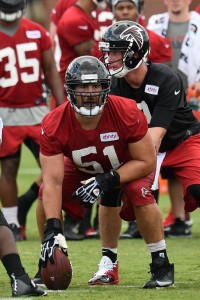
Mack, 30, only played in five games during Shanahan’s year as Cleveland’s play-caller, but he spent the entire summer of 2014 preparing to enter a zone-blocking scheme, and his athleticism and ability to move in the running game makes him a perfect fit for the zone approach. The Falcons made Mack the highest-paid center in the league, handing him $9MM per year after the Browns, Chargers, and Rams all expressed varying levels of interest once Mack opted out of his deal with Cleveland.
After being designated as the Browns’ transition player during the 2014 offseason, Mack played the free agent game correctly, inking an offer sheet with the Jaguars that paid him $8.5MM annually, $18MM guaranteed over the first two years of the deal, and contained that aforementioned opt-out clause. Cleveland matched that offer, and when Mack withdrew two years later, he was able to land a contract that will pay him even more per year and includes another $20MM in guarantees. Like Darrelle Revis, Mack has worked the free agent system to his benefit in order to secure every dollar he’s worth.
Chris Chester, meanwhile, will return to Atlanta after playing every offensive snap for the club last year, but he’ll be expected to compete for his starting job, with Person, rookie Wes Schweizter, and free agent addition Tom Compton serving as Chester’s main obstacles to playing time at right guard. Chester is now 33 years old and coming off January shoulder surgery, but he played so well in 2015 that he should be the favorite to handle the majority of snaps. Right tackle Ryan Schraeder, a revelation last year (PFF’s No. 5 tackle), will also return after signing his second-round restricted free agent tender, and the Falcons could look to sign him to an extension over the next few months.
While Atlanta’s pass-blocking was tremendous, the Falcons’ passing offense as a whole was not, as the club ranked 23rd in passing DVOA, with Julio Jones and his 136/1,871/8 receiving line essentially acting as a one-man passing offense. Tight end Jacob Tamme posted a nice season, racking up 59 passes for nearly 700 yards, but the rest of Atlanta’s pass-catchers — including Roddy White, Leonard Hankerson, and Justin Hardy — left a lot to be desired. But instead of finding an affordable complement to play opposite Jones, the Falcons overspent in a weak free agent market, signing former Bengals wideout Mohamed Sanu to a five-year deal.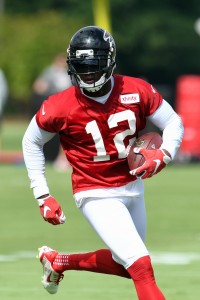
Even among an uninspiring crop of free agent pass-catchers, Sanu only placed seventh among his position in PFR’s free agent rankings, but the 26-year-old will be earning more annually than every other free agent receiver except former Bengals teammate Marvin Jones. Travis Benjamin, Rishard Matthews, Rueben Randle, Anquan Boldin, and Jermaine Kearse will earn $6MM or less on their new contracts, and the Eagles and Lions were able to land Randle and Boldin, respectively, on one-year pacts.
Sanu, who failed top 400 yards receiving last year, somehow managed to score a better deal than Golden Tate received from the Lions during the 2014 offseason. Cincinnati didn’t trust Sanu enough to allow him to play a larger role in their offense, and he struggled when asked to step up amid a rash of injuries during the 2014 campaign. Clearly, the Falcons needed to add another complementary weapon to their offense, but Sanu is unlikely to live up to his contract.
Atlanta’s only other notable addition on offense was at quarterback, and like Mack, Matt Schaub has a history with Shanahan, having spent time with the play-caller in Houston. Schaub, of course, also has a past with the Falcons (he was a former third-round pick of the club), and though his career has fallen apart in the past few seasons, he probably won’t be asked to play much in Atlanta. Starter Matt Ryan hasn’t missed a game since 2009, having started 99 straight contests since his last missed game.
On the defensive side of the ball, the Falcons surprisingly didn’t target any high-profile pass-rushers after failing to get after opposing quarterbacks with any level of consistency in 2016. Not only did the club rank dead last in sacks with only 19 (the lowest total for any team in the league since 2009), but it also finished 32nd in adjusted sack rate. Atlanta decided to play in the middle of the market, however, inking former Dolphins defensive end Derrick Shelby and re-signing their own Adrian Clayborn.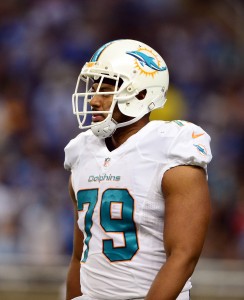
Shelby, 27, is an interesting case of scouting the stat line versus watching the tape. While he’s only posted nine sacks in his career, Shelby graded out as the league’s No. 23 edge defender last season, according to PFF. It’s fair to wonder if Shelby’s increased production was partly a result of playing next to All Pro defensive tackle Ndamukong Suh, and it could be concerning that Miami didn’t seriously attempt to retain Shelby, instead opting for external options such as Mario Williams, Andre Branch, and Jason Jones.
While Shelby landed a four-year contract, the Falcons were able to bring back Clayborn on a shorter pact, locking up the edge defender for two more seasons. Clayborn isn’t much of a run defender, so after seeing some time at tackle in 2015, he figures to play exclusively at end during the upcoming season, and given the makeup of Atlanta’s front seven, it’s possible Clayborn is used primarily in sub packages.
Earlier today, the Falcons finally consummated a long-rumored deal with free agent pass rusher Dwight Freeney, inking the veteran after he also drew interest from the Bengals. Now 36 years old, Freeney was still productive last season, managing eight sacks for the Cardinals in only 255 defensive snaps. And though he didn’t get to the quarterback as much in the year prior, Freeney was still solid for the Chargers in 2014, forcing 40 quarterback hurries and posting nine QB hits. He’ll play as rotational end for Atlanta, and shouldn’t be asked to play more than 30 snaps per game.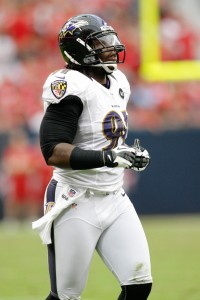
Clayborn and Freeney will see competition for snaps from free agent addition Courtney Upshaw, the former Ravens second-round pick that only netted a one-year deal from the Falcons. The 26-year-old Upshaw never became the edge rushing force in Baltimore that many had projected, but he’s very solid against the run, and could conceivably be used in a variety of roles in Dan Quinn‘s defense. Upshaw will likely see snaps at both defensive end and linebacker in Atlanta, with his duty being heavily influenced by the situation.
While Upshaw could shift between multiple positions, Sean Weatherspoon and Philip Wheeler are linebackers in the most strict sense, and both could see a hefty amount of snaps next seeason. Weatherspoon returns to the Falcons after a one-year stint with the Cardinals, and given his history of injuries, Atlanta will probably try to specify his role in the defense. Given his movement and coverage skills, Weatherspoon will likely be on the field in the Falcons’ nickel defense. Wheeler, meanwhile, will have to compete with fourth-round rookie De’Vondre Campbell for playing time at outside ‘backer.
Read more about the Falcons’ offseason…
Read more
Notable losses:
- Phillip Adams, CB
- Kroy Biermann, DE
- Justin Durant, LB: Released
- Charles Godfrey, S: Retired
- Gino Gradkowski, C
- Shayne Graham, K
- Devin Hester, WR: Released
- Jake Long, T
- Tony Moeaki, TE
- William Moore, S: Released
- O’Brien Schofield, LB
- Paul Soliai, DT: Released
- Nathan Stupar, LB
- Roddy White, WR: Released
While the Falcons may have lost more important players in terms of production, no defection will hit the club harder from a sentimental perspective than that of Roddy White, who was released after the season. White posted a truly great six-year run from 2007-12 during which he averaged 94 receptions for nearly 1,300 yards and eight touchdowns, earning Pro Bowl honors four times and being named an All Pro once. But those totals have slipped in the last three seasons, as White has averaged a 62/713/4 line while seeing his yards per reception drop significantly.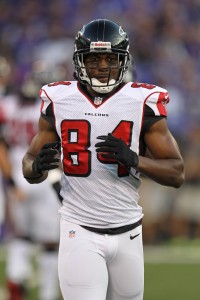
White has since lashed out at the Falcons after receiving his walking papers, intimating on multiple occasions that his release was due to his relationship with offensive coordinator Kyle Shanahan. But while the two may have had disagreements, it’s clear that a 34-year-old White wasn’t worth the $6MM+ cap charge he was due in 2016. At this point, White remains a free agent, and he’s indicated that he plans to continue his career.
Fellow wide receiver Devin Hester was also cut, though it’s hard to consider him a loss given that he missed the entire 2015 season with injury. Hester posted a few solid games during his first season with Atlanta in 2014, but for the most part is still known primarily as a return man, so much so that his return statistics appear before his receiving numbers on Pro Football Reference. Like White, Hester wants to play in 2016 (and has said this season will be his last in the NFL), and claims that as many as seven clubs have already reached out to him
None of Atlanta’s other offensive losses will make much of a dent, as none of Jake Long, Gino Gradkowski, and Tony Moeaki played more than 90 offensive snaps. That’s not the case on defense, however, as the Falcons will be without several players who had a large role last season. Atlanta’s linebacking unit, in particular, will look vastly different in 2016, as Justin Durant, O’Brien Schofield, and Nathan Stupar are all off the roster.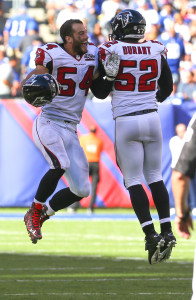
Durant, 30, started 12 games for the Falcons last season, playing a jack-of-all-trades role that he’s grown accustomed to during an NFL tenure that’s see him spend time with five clubs. But with Atlanta adding two young linebackers via the draft, signing Courtney Upshaw and Sean Weatherspoon, and looking to play Vic Beasley at ‘backer in base packages, there simply wasn’t a spot for Durant. He’s found a new home, though, heading back to the Cowboys to help make up for the 10-game loss of Rolando McClain.
While Durant played about 150 more snaps, Schofield was arguably the more impactful defender, as he gave the Falcons a good effort in against the run game and is still viewed as an above-average rusher. Schofield, 29, is still sitting on the open market, and Atlanta has not ruled out a reunion. Stupar, meanwhile, started three games last season but was primarily an effective special-teamer, a role he’ll now play for the division-rival Saints.
Elsewhere in the front seven, the Falcons released defensive tackle Paul Soliai and opted not to re-sign defensive end/linebacker Kroy Biermann, the latter of whom had been with the team since 2008. Biermann had several productive seasons as a run-stuffer who offered some pass-rush skills early in his Atlanta tenure, but he dealt with a major injury in 2013 and never seemed to adapt well to new defensive schemes introduced by Falcons coaches. Soliai, meanwhile, was a misguided signing from the get-go, and Atlanta will now carry $1.4MM in dead money in 2016 and $2.8MM in 2017 as a result of that mistake.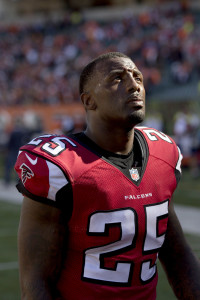
In the back end, safety William Moore was also cut after many years with Atlanta (he was a second-round pick in 2009) after dealing with injuries for much of the past two seasons. Moore, 31, missed 14 games from 2014-15, and wasn’t particularly effective when he was on the field. The Falcons absorbed $3.3MM in dead money by releasing Moore, although they did free up $3.2MM in cap space.
Soliai and Moore are just a few of the contractual mistakes that GM Thomas Dimitroff & Co. have made recently, and though the Falcons don’t have the bad financial rap that a club like the Saints does, Atlanta has not managed its cap well over the past few years. The Falcons will carry the second-largest amount o dead money in the NFL in 2016 (behind only the Saints), using cap space for departed players like Sam Baker, Jon Asamoah, White, Moore, and Soliai. Every club hands out a few bad deals, but the the Falcons are beginning to make the practice look like a trend, not a blip.
Trades:
- Acquired a 2016 second-round pick (No. 52) and a 2016 sixth-round pick (No. 195) from the Texans in exchange for a 2016 second-round pick (No. 50).
Draft picks:
Keanu Neal was perhaps the most surprising pick of the first round, as the Falcons passed up defensive line options like Shaq Lawson, Robert Nkemdiche, and Vernon Butler to add a player to their secondary that many considered 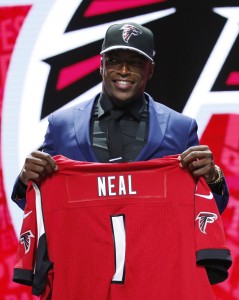 a second-round talent. At 6’1″, 210 pounds, Neal has the size (and speed) to become Dan Quinn‘s new version of Kam Chancellor, but simply being a physical specimen doesn’t mean Neal is a sure thing. Expect a lot of highlight reel hits to go along with some lapses in coverage.
a second-round talent. At 6’1″, 210 pounds, Neal has the size (and speed) to become Dan Quinn‘s new version of Kam Chancellor, but simply being a physical specimen doesn’t mean Neal is a sure thing. Expect a lot of highlight reel hits to go along with some lapses in coverage.
If Atlanta’s selection of Neal didn’t make it clear that the club wanted to add speed to its defense, then the choice of linebacker Deion Jones in the second round surely did. Jones can run like the wind, as evidenced by his 40-yard dash time of 4.38 seconds, but as Pro Football Focus noted when handing out its draft grades, Jones can get eaten up in the run game and missed a tackle on one of every 6.5 attempts. Fourth-rounder De’Vondre Campbell is a linebacker in a similar mold, and both he and Jones will have every opportunity to earn snaps as rookies.
Tight end Austin Hooper also has a pretty clear line to playing time, as veterans Jacob Tamme and Levine Toilolo don’t present the most fearsome competition. Hooper is a solid blocker, and should easily overtake Toilolo as the No. 2 tight end, lining up on the line in two-tight end packages, and it wouldn’t be surprising if he’s Atlanta’s No. 1 option at the position by season’s end.
Other:
The Falcons had already restructured their front office in January 2015, with assistant general manager Scott Pioli taking on college and pro scouting responsibilities in addition to managing the draft, while GM Thomas Dimitroff retained final say over free agency and draft choices. No matter how the announcement was parsed, it looked like Dimitroff has lost at least some power, even though he and Pioli are longtime friends and colleagues.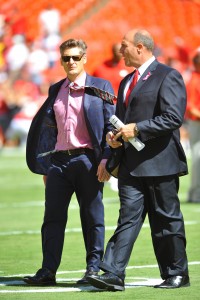
This offseason, Atlanta added one of Pioli’s guys, former Chiefs assistant GM Joel Collier, as director of pro personnel. Bringing in new voices to a front office is typically a positive, but Dimitroff has to be wondering if Pioli is the next man in line for the general manager job if the 2016 season doesn’t go as planned. The Falcons also hired former GMs Phil Emery (Bears) and Ruston Webster (Titans), meaning the club now employs four former general mangers in its front office.
The loss of Jalen Collins for four games is more important than it may appear on the surface given that Colins started only two games during his rookie season, as the former LSU tiger was set to play outside corner in Atlanta’s sub packages, allowing Robert Alford to move to the slot. With Collins suspended, Alford is still likely to make the move inside in nickel packages, but 2015 seventh-rounder Akeem King will now be counted on to play a more impactful role. The Falcons clearly aren’t comfortable with that alignment, leading to their dalliances with free agent slot corners Leon Hall and Brandon Boykin.
Top 10 cap hits for 2016:
- Matt Ryan, QB: $23,750,000
- Julio Jones, WR: $15,900,000
- Sam Baker, T: $6,400,000 (dead money)
- Andy Levitre, G: $5,375,000
- Jake Matthews, T: $4,480,773
- Alex Mack, C: $4,050,000
- Jon Asamoah, G: $3,900,000 (dead money)
- Devin Hester, WR: $3,833,334
- Roddy White, WR: $3,775,000 (dead money)
- Brooks Reed, DE/LB: $3,440,000
From a 30,000-foot view, it’s difficult to see how the Falcons will vastly improve on last year’s 8-8 record. Atlanta will heavily rely on the running game once again, hoping that Devonta Freeman can build upon his impressive season behind a solid offensive line while Matt Ryan continues to feed Julio Jones though the air. On defense, the Falcons are counting on a mix of young players and mediocre veterans to step up, which doesn’t figure to be a winning strategy. Overall, a .500 season still looks like the most likely outcome.
Information from Over the Cap, Spotrac, and Roster Resource was used in the creation of this post. Photos courtesy of USA Today Sports Images.
 The seven-game work sample Osweiler offered included mixed reviews. He showcased some ability despite no previous experience in an important game situation, leading the Broncos to a 4-2 record in games he played throughout. The former second-round pick drove the team to pivotal victories over the Patriots and Bengals to help the Broncos secure home-field advantage. He finished with 10 touchdown passes, six interceptions and 245.9 passing yards per game. Denver’s offense also sputtered for several entire halves under Osweiler’s guidance, leading to two December losses and increasing the defense’s burden. What happened during the final stretch of offensive futility under the 25-year-old Osweiler may have changed the long-term outlook for two franchises.
The seven-game work sample Osweiler offered included mixed reviews. He showcased some ability despite no previous experience in an important game situation, leading the Broncos to a 4-2 record in games he played throughout. The former second-round pick drove the team to pivotal victories over the Patriots and Bengals to help the Broncos secure home-field advantage. He finished with 10 touchdown passes, six interceptions and 245.9 passing yards per game. Denver’s offense also sputtered for several entire halves under Osweiler’s guidance, leading to two December losses and increasing the defense’s burden. What happened during the final stretch of offensive futility under the 25-year-old Osweiler may have changed the long-term outlook for two franchises. Houston moved quickly to replace Arian Foster, signing Miller on Day 1 of free agency. Unlike the new franchise quarterback, the Texans’ cornerstone ball-carrier’s ability can be judged based on full-season bodies of work. Miller posted back-to-back slates of at least 1,200 yards from scrimmage. Among backs who received at least 400 carries in 2014-15, Miller’s 4.8 yards per tote rank as the league’s top mark in a sub-category basically exclusive to starting backs. As a receiver, Miller caught 47 passes for nearly 400 yards last season, so he’s no slouch as an outlet option, either.
Houston moved quickly to replace Arian Foster, signing Miller on Day 1 of free agency. Unlike the new franchise quarterback, the Texans’ cornerstone ball-carrier’s ability can be judged based on full-season bodies of work. Miller posted back-to-back slates of at least 1,200 yards from scrimmage. Among backs who received at least 400 carries in 2014-15, Miller’s 4.8 yards per tote rank as the league’s top mark in a sub-category basically exclusive to starting backs. As a receiver, Miller caught 47 passes for nearly 400 yards last season, so he’s no slouch as an outlet option, either. Previously relocated to right tackle in 2014 prior to his season-ending elbow malady, Allen began his ’15 campaign on the right edge before Ben Grubbs‘ career-ending neck injury moved him back inside. At left guard, Allen became Kansas City’s best lineman, helping the Chiefs adjust to life without Jamaal Charles. But the 6-foot-4 blocker saw a preseason knee injury limit him to 12 games (eight starts) last season. Nonetheless, the Texans needed a guard with Brandon Brooks in the process of signing with the Eagles, and they made Allen the league’s sixth-highest-paid guard on a per-year basis.
Previously relocated to right tackle in 2014 prior to his season-ending elbow malady, Allen began his ’15 campaign on the right edge before Ben Grubbs‘ career-ending neck injury moved him back inside. At left guard, Allen became Kansas City’s best lineman, helping the Chiefs adjust to life without Jamaal Charles. But the 6-foot-4 blocker saw a preseason knee injury limit him to 12 games (eight starts) last season. Nonetheless, the Texans needed a guard with Brandon Brooks in the process of signing with the Eagles, and they made Allen the league’s sixth-highest-paid guard on a per-year basis.


 clearly never lived up to his draft billing after being chosen seventh overall in 2009, but he can still serve as a depth option and special teams player. He saw 39 targets last season, and that number figures to stay relatively stagnant, as though Bryant is suspended for the season, DHB is still behind Antonio Brown, Markus Wheaton, and Sammie Coates among the club’s wide receivers.
clearly never lived up to his draft billing after being chosen seventh overall in 2009, but he can still serve as a depth option and special teams player. He saw 39 targets last season, and that number figures to stay relatively stagnant, as though Bryant is suspended for the season, DHB is still behind Antonio Brown, Markus Wheaton, and Sammie Coates among the club’s wide receivers. emerged as Denver’s left tackle after incumbent Ryan Clady went down for the season, and helped stabilize the club’s offensive line on the way to a Super Bowl title. With the Steelers, Harris will compete with Alejandro Villanueva, who started 10 games at left tackle for Pittsburgh as a 27-year-old rookie. So far, it sounds as though the two are neck-and-neck.
emerged as Denver’s left tackle after incumbent Ryan Clady went down for the season, and helped stabilize the club’s offensive line on the way to a Super Bowl title. With the Steelers, Harris will compete with Alejandro Villanueva, who started 10 games at left tackle for Pittsburgh as a 27-year-old rookie. So far, it sounds as though the two are neck-and-neck. Second-round rookie Sean Davis had been ticketed to take Golden’s place as Pittsburgh’s strong safety, but following a serious injury to cornerback Senquez Golson, Davis is likely to see most of his action at slot corner, meaning Golden will see a heavy snap count in the back end.
Second-round rookie Sean Davis had been ticketed to take Golden’s place as Pittsburgh’s strong safety, but following a serious injury to cornerback Senquez Golson, Davis is likely to see most of his action at slot corner, meaning Golden will see a heavy snap count in the back end. the Cardinals (with whom he ultimately re-signed), and even signed the Broncos’ C.J. Anderson to a restricted free agent offer sheet. But after Denver matched on Anderson, the Dolphins did little to augment their backfield over the next four months except select Kenyan Drake — who doesn’t project as a starter in 2016 — in the third round of April’s draft.
the Cardinals (with whom he ultimately re-signed), and even signed the Broncos’ C.J. Anderson to a restricted free agent offer sheet. But after Denver matched on Anderson, the Dolphins did little to augment their backfield over the next four months except select Kenyan Drake — who doesn’t project as a starter in 2016 — in the third round of April’s draft. the free agent period, the club’s first move was to sign former Bills defensive end Mario Williams, who had reportedly been seeking $10MM annually. While he didn’t reach that mark, there’s some question as to whether Williams is worth the $8.5MM average he did receive.
the free agent period, the club’s first move was to sign former Bills defensive end Mario Williams, who had reportedly been seeking $10MM annually. While he didn’t reach that mark, there’s some question as to whether Williams is worth the $8.5MM average he did receive. There aren’t many details available about the one-year pact as of yet, but Ian Rapoport of NFL.com did note that the deal can be worth “up to $5MM.” That type of phrasing can mean many different things, and we’ll need to know the complete specifics before fully analyzing the deal, but it likely doesn’t offer much in the way of guarantees.
There aren’t many details available about the one-year pact as of yet, but Ian Rapoport of NFL.com did note that the deal can be worth “up to $5MM.” That type of phrasing can mean many different things, and we’ll need to know the complete specifics before fully analyzing the deal, but it likely doesn’t offer much in the way of guarantees. Considering the injury concerns for receivers Julian Edelman and Danny Amendola, the Patriots went hard after several free agent wideouts. After kicking the tires on Marvin Jones and Mohamed Sanu, the team ended up settling on former Bills receiver Chris Hogan – a player coach Bill Belichick had long coveted. The former Bills wideout has put up solid numbers over the past two seasons, compiling 77 catches, 876 yards, and six touchdowns during the span. As things currently stand, the 27-year-old would be the team’s third receiver, and the former Monmouth standout can also reportedly serve as an emergency punter.
Considering the injury concerns for receivers Julian Edelman and Danny Amendola, the Patriots went hard after several free agent wideouts. After kicking the tires on Marvin Jones and Mohamed Sanu, the team ended up settling on former Bills receiver Chris Hogan – a player coach Bill Belichick had long coveted. The former Bills wideout has put up solid numbers over the past two seasons, compiling 77 catches, 876 yards, and six touchdowns during the span. As things currently stand, the 27-year-old would be the team’s third receiver, and the former Monmouth standout can also reportedly serve as an emergency punter.










































































